
WINTER 2023 HISTORYNET.COM WIWP-230100-COVER-DIGITAL.indd 1 10/3/22 11:18 AM
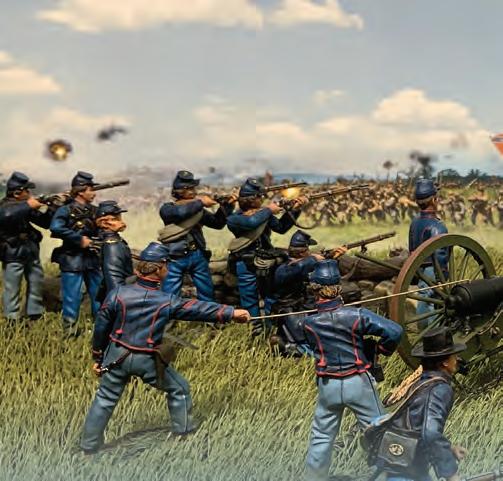








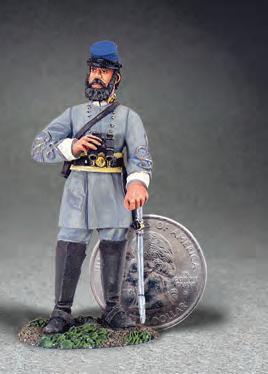


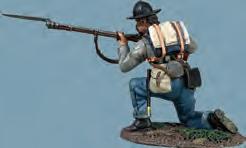








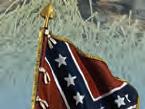







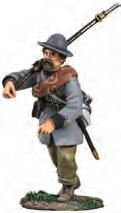
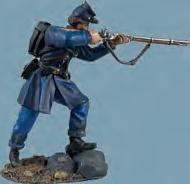


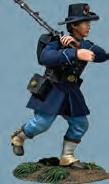


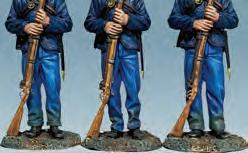



























Each one of our 1:30 scale metal figures is painstakingly researched for historical accuracy and detail. The originals are hand sculpted by our talented artists before being cast in metal and hand painted – making each figure a gem of hand-crafted history. Please visit wbritain.com to see all these figures and more from many other historical eras. Mention this ad for a FREE CATALOG Free Mini Backdrop with your first purchase! matte finish Hand-Painted Pewter Figures 56/58 mm-1/30 Scale 31116 Confederate General “Stonewall” Jackson, No.2 $42.00 WBHN-WW WINTER-2022 ©2022 W.Britain Model Figures W.Britain, and are registered trademarks of the W.Britain Model Figures, Chillicothe, OH Follow us on Facebook: W-Britain-Toy-SoldierModel-Figure-Company Subscribe to us on YouTube: W.Britain Model Figures Tel: U.S. 740-702-1803 • wbritain.com • Tel: U.K. (0)800 086 9123 See our complete collection of 1/30 scale W.Britain historical metal figures at: 31380…$46 Confederate Infantry Bugler 31356…$45 Confederate Infantry Marching 10085 $45 Frederick Douglass American Abolitionist and Social Reformer 31392…$45 Federal Iron Brigade Advancing at Right Shoulder Wearing Gaiters 32005…$45 7th Cavalry Scout “Curly” 31350…$130 Three Federal Infantry Standing at Rest 31317…$42 Confederate General Robert E. Lee Confederate Infantry Waving ANV Flag 31372…$42 Federal in Frock Coat Standing Firing, No.3 31377 $45 Confederate Infantry Marching and Cheering 31361…$45 Confederate Infantry in Frock Coat Advancing Loading 10088 $45 Harriet Tubman American Abolitionist 32000…$45 Dismounted 9th Cavalry Trooper 32002…$45 U.S. Army Apache Scout, 1880s 32003…$45 Captain MylesKeogh 7thCavalry, 1876 32001…$45 U.S. Infantry on Campaign, 1880s 31381…$46 Federal Infantry Drummer, No.3 31267…$42 Confederate Infantry Kneeling Preparing to Fire 31177…$42 Confederate Infantry in Frock Coat Charging at Right Shoulder Shift, No.2 31086 $42 U.S. Colored Troops Marching 10086 $45 Sergeant Major Lewis Douglass, 54th Mass. Infantry WBHN-WW Winter-2022 Wild West.indd 1 9/28/22 2:07 PM WIWP-221108-006 Wbritain.indd 1 9/30/22 11:40 PM
History. Heritage. Craft CULTURE. The Great Outdoors. The Nature of the West.
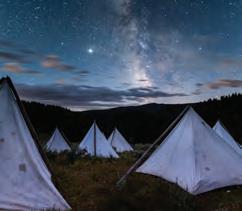
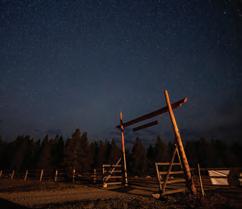

million acres of pristine wildland in the Bighorn National Forest, encompassing 1,200 miles of trails, 30 campgrounds, 10 picnic areas, 6 mountain lodges, legendary dude ranches, and hundreds of miles of waterways. The Bighorns offer limitless outdoor recreation opportunities.


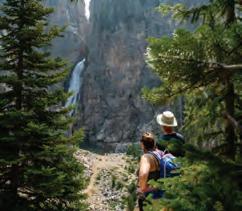

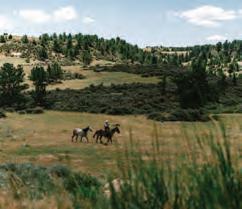

restaurants, bars, food trucks, lounges, breweries, distilleries, tap rooms, saloons, and holes in the wall are spread across Sheridan County. That’s 101 different ways to apres adventure in the craft capital of Wyoming. We are also home to more than 40 hotels, motels, RV parks, and B&Bs.




seasons in which to get WYO’d. If you’re a skijoring savant, you’ll want to check out the Winter Rodeo in February 2022. July features the 92nd edition of the beloved WYO Rodeo. Spring and fall are the perfect time to chase cool mountain streams or epic backcountry lines.


Sheridan features a thriving, historic downtown district, with western allure, hospitality and good graces to spare; a vibrant arts scene; bombastic craft culture; a robust festival and events calendar; and living history from one corner of the county to the next.


1.1
101
4
∞ WIWP Winter 2022-23 WIWP-221108-005.indd 1 10/4/22 1:31 AM
Engelhard
By Mark T. Smokov

 Aaron Robert Woodard
Aaron Robert Woodard


HOW DEADLY WAS KID CURRY?
Harvey Logan was the Wild Bunch’s most prolific killer—or so legend has it ‘THE DEER IS LIKE MONEY’ By Michael
The herding of reindeer for food and fur was once a lucrative venture in Alaska THE SCOUT WHO STRADDLED TWO WORLDS By
Not even a murder charge could derail half blood Johnnie Bruguier’s Army career 40 48 32 WIWP-WINTER-2023-CONTENTS.indd 2 9/30/22 3:12 PM
Emmy Award–winning
EDITOR’S LETTER
LETTERS
ROUNDUP
INTERVIEW
BY JOHNNY D. BOGGS
Hill
WESTERNERS
Texan transplant Henry W. Strong
for Colonel Ranald S.

GUNFIGHTERS & LAWMEN
 BY JULIA BRICKLIN
BY JULIA BRICKLIN
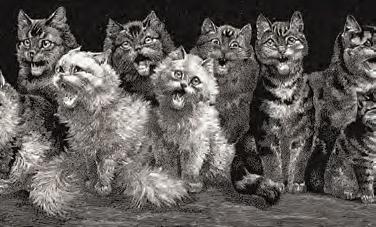
Judge William Story struggled as

Englishwoman
Widow Yetta Kohn
‘Hanging
PIONEERS & SETTLERS
BY JOHN H. MONNETT
Kingsley
WESTERN ENTERPRISE
BY JIM WINNERMAN
BY

ON THE COVER
In this oft-printed 1900 portrait five well-dressed members of the infamous Wild Bunch gang of outlaws—dubbed the “Fort Worth Five,” as they posed in that Texas town—happily sit still for photographer John Swartz. The reputed deadliest of the bunch, Harvey Logan (alias “Kid Curry”), stands at right beside Will Carver. Seated, from left, are Harry Alonzo Longabaugh (“Sundance Kid”), Ben Kilpatrick (“Tall Texan”) and gang leader Robert LeRoy Parker (“Butch Cassidy”). For more about the photo see historynet.com/last-word-famouswild-bunch-photo. (Denver Public Library, Photo Illustration by Brian Walker)

4
8
10
16
director Walter
talks Western movies and history 18
scouted
Mackenzie 20
the predecessor to
Judge’ Isaac Parker 22
Rose
recalled a slushy, happy Christmas 1871 in Denver 24
built a New Mexico Territory cattle ranch that’s still operating 26 ART OF THE WEST BY JOHNNY D. BOGGS Montana artist Jerry Crandall rendered award-winning Western art with accuracy 30 INDIAN LIFE BY RAMON VASCONCELLOS Few Indians benefited from the secularization of California missions in the 1830s 76 COLLECTIONS BY LINDA WOMMACK Fans of Lonesome Dove should plan a visit to Texas State University, San Marcos 78 GUNS OF THE WEST BY GEORGE LAYMAN Black Bart gained infamy for robbing stagecoaches—without firing his shotguns 80 GHOST TOWNS
JIM WINNERMAN Though Hawkinsville, Colo., hosted two gold booms, it never amounted to much 82 REVIEWS Award-winning author Johnny D. Boggs picks his favorite unsung nonfiction books and films. Plus reviews of recent books 88 GO WEST Some reindeer spend their ‘off-season’ receiving visitors at this Alaska farm A PEACE OFFICER MURDERED FOR BOOZE By Ellen Notbohm Even Paulson met a brutal death after surprising bootleggers in Mayville, N.D. THERE’LL BE A CATERWAULING IN THE OLD TOWN TONIGHT By Preston Lewis Hissing, growling and screeching feral cats caused nighttime distress out West 72 TROUBLE IN ZION By Will Gorenfeld An Army column pursuing Ute murderers in Utah Territory nearly sparked war 54 60 THE BUFFALO-BONE CANE MYSTERY By Matt Bernstein George Hearst awarded his protector Wyatt Earp with a walking stick—or did he? 66 WINTER 2023 WIWP-WINTER-2023-CONTENTS.indd 3 9/30/22 3:12 PM
When Earp Met Hearst
In case you missed it, a 2019 book published by the University of North Texas Press has proved a gift for those of us who can’t get enough information about the best-known of the “Fighting Earp” brothers. A Wyatt Earp Anthology: Long May His Story Be Told, edited by Roy B. Young, Gary L. Roberts and Wyatt biographer Casey Tefertiller, with a foreword by Wild West special contributor John Boessenecker, related enough stories about the legendary law man to help get me through a couple of self-isolated COVID years. “Earp’s un waning popularity led several genera tions of scholars, avocational historians and enthusiastic researchers to dig deep into his life and times,” writes Boessenecker. “The fruits of their labor appear here for the first time in a single volume.”
The anthology gives an overview of the man and the myth and details Wyatt’s life before, during and after his glorified days in Tombstone, Arizona Territory. Earp’s ride into the sunset was a long one; he was born on March 19, 1848, in Monmouth, Ill., and died at age 80 on Jan. 13, 1929, in Los Angeles. His life has been glorified by some (including in the popu lar 1950s TV series The Life and Legend of Wyatt Earp), and he became known as the “Lion of Tombstone.” But in his earlier days an appropriate handle could have been the “Pimp of Peoria” (see Roger Jay’s groundbreaking story “‘The Peoria Bummer’: Wyatt Earp’s Lost Year” in the August 2003 Wild West). “Part VII [of the anthology],” writes Boessenecker, “presents a number of now-classic accounts that expose modernday authors who fabricated stories, and even some best-selling books, about Wyatt Earp.”
Of course, fabricated and/or overstated Wyatt tales have a rich history, going back to the two most famous early Earp books—Tombstone: An Iliad of the Southwest (1927), by Walter Noble Burns, and Wyatt Earp: Frontier Marshal (1931), by Stuart N. Lake—that portrayed Earp as a too-good-to-be-true guy. “Lake’s book…exaggerated the lawman’s deeds and created a sort of frontier superhero,” writes Tefertiller in “Finding Wyatt,” published in the October 2017 Wild West and reprinted in the anthology. One such hero-making tale Lake told is how in fall 1878 a courageous Wyatt confronted Clay Allison and ordered the dangerous shootist to literally get out of Dodge City, Kan. Rather than face the wrath of the stalwart lawman, the story goes, Allison complied. “It was preposterous,” writes Tefertiller.
Lake also claimed that in January 1882 (the gunfight near Tombstone’s O.K. Corral having occurred the previous Oc-
For anyone into Earpiana, A Wyatt Earp Anthology: Long May His Story Be Told is a must-read. Co-editors Casey Tefertiller and Gary L. Roberts have written the best biographies, respectively, of Wyatt Earp and Doc Holliday. Their fellow editor, Roy B. Young, also wrote the insightful preface.

tober), Wyatt served as a bodyguard for Senator George Hearst, noting, “With Wyatt, Hearst spent a week riding and camping in the mountains and desert without molestation.” According to Lake, Hearst, who was on an inspec tion tour of Cochise County mining prop erties, had learned from an undercover Wells Fargo agent that Curly Bill, John Ringo and the rest of the Cowboy gang planned to kidnap and ransom him. In our feature story “The Buffalo-Bone Cane Mystery” (see P. 66) author Matthew Bernstein examines the Earp–Hearst association and in particular how Hearst supposedly gave Earp an Indian-made buffalo-bone cane (instead of money) for his services as a protector. After Wyatt’s death Lake wrote to newspaperman William Randolph Hearst, George’s son and heir, telling him the story (whether true or a Lake fabrication is open to question) of this walking stick. “Could it be Lake was trying to flimflam W.R. Hearst into buying a worthless stick of no historic value?” posits Bernstein before delving into the merits of Lake’s account. That the claim might be suspect is not surprising, consider ing the other tales Lake told in Wyatt Earp: Frontier Marshal
It didn’t help Lake’s claim, Bernstein notes, that the biog rapher repeatedly refers to Hearst as “Senator,” as Hearst wasn’t appointed to the U.S. Senate until 1886. Bernstein doesn’t go so far as to declare the Hearst–Earp cane chronicle “preposterous.” Whether true or not, it’s a story of interest that connects a self-made millionaire who established himself as one of the West’s most successful businessmen with the man who became the most famous lawman out West, even if he did it with a little help from friends and biographers.
Wild West editor Gregory Lalire’s historical novels include 2022’s The Call of McCall, 2021’s Man From Montana, 2019’s Our Frontier Pastime: 1804–1815 and 2014’s Captured: From the Frontier Diary of Infant Danny Duly His short story “Halfway to Hell” appears in the 2018 anthology The Trading Post and Other Frontier Stories .

WILD WEST WINTER 20234
EDITOR’S LETTER
WIWP-WINTER-2023-ED-LETTER.indd 4 9/30/22 9:08 AM
Western
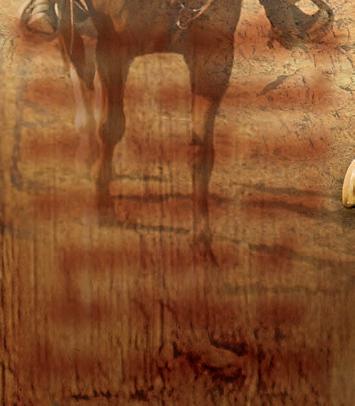

walked taller than John Wayne. In
expected, so
Wayne” in two installments
$29.99, the first due before shipment,
$59.99*.
purchase is backed
money-back guarantee, so there’s no risk. Send no money now.
the
B_I_V = Live Area: 7 x 9.75, 1 Page, Installment, Vertical Price Logo Address Job Code Tracking Code Yellow Snipe Shipping Service Replica knife is richly adorned with hand-cast sculpture and portraits of the Duke on fine porcelain ® ©2022 BGE 01-02767-001-BIP Shown smaller than actual height of 10½ inches. Dull-edged replica knife is for decorative use only; not for use as a toy or weapon. JOHN WAYNE, , DUKE and THE DUKE are the exclusive trademarks of, and the John Wayne name, image, likeness and voice and all other related indicia are the intellectual property of, John Wayne Enterprises, LLC. (C) 2022. All rights reserved. www.JohnWayne.com YES. Please accept my order for the “John Wayne”® collectible as described in this announcement. Please Respond Promptly *Plus a total of $10.99 shipping and service; see bradfordexchange.com. Limitededition presentation restricted to 95 firing days. Please allow 4-8 weeks after initial payment for shipment. Sales subject to product availability and order acceptance. RESERVATION APPLICATION SEND NO MONEY NOW Where Passion Becomes Art The Bradford Exchange 9345 Milwaukee Avenue, Niles, IL 60714-1393 Mrs. Mr. Ms. Name (Please Print Clearly) Address City State Zip Email (optional) 01-02767-001-E56302 No
hero ever
five decades of Hollywood classics, Duke chewed up the Western landscape and proved himself a towering figure of honor and true grit. Now the strong-jawed hero rides across the range once more on a unique collectible that measures more than 10 inches in length and features riveting portraits on fine porcelain. A bronzed sculpt of John Wayne graces the hand-painted handle, further distinguished by the star’s replica autograph. Limited Edition. Order Today! Strong demand is
act now to acquire “John
of
totaling
Your
by our 365-day
Mail
Reservation Application today! ORDER TODAY AT BRADFORDEXCHANGE.COM/JWKNIFE WIWP-221108-010 Bradford An American Legend John Wayne Knife CLIPPABLE.indd 1 9/30/22 11:14 PM
ROB
DAVID

GREGORY
GREGORY

JOHNNY
JOHN




JOHN BOESSENECKER

BRIAN WALKER
MELISSA
PAUL FISHER
DANA B.
MICHAEL
CLAIRE
JAMIE
© TOMBSTONE TURMOIL , ANDY THOMAS VISIT HISTORYNET.COM Sign up for our FREE weekly e-newsletter at historynet.com/newsletters HISTORYNET PLUS! Today in History What happened today, yesterday or on any day you care to search. Daily Quiz Test your historical acumen every day! What If? Consider the fallout of historical events had they gone the ‘other’ way. Weapons & Gear The gadgetry of war—new and old, effective and not so effective. TRENDING NOW WINTER 2023 / VOL. 35, NO. 3 THE AMERICAN FRONTIER
J. LALIRE EDITOR
LAUTERBORN MANAGING EDITOR
F. MICHNO SPECIAL CONTRIBUTOR
D. BOGGS SPECIAL CONTRIBUTOR
KOSTER SPECIAL CONTRIBUTOR
SPECIAL CONTRIBUTOR
GROUP DESIGN DIRECTOR
A. WINN DIRECTOR OF PHOTOGRAPHY
ART DIRECTOR ALEX GRIFFITH PHOTO EDITOR
SHOAF MANAGING EDITOR, PRINT
Y. PARK MANAGING EDITOR, DIGITAL
BARRETT NEWS AND SOCIAL EDITOR CORPORATE KELLY FACER SVP REVENUE OPERATIONS MATT GROSS VP DIGITAL INITIATIVES
WILKINS DIRECTOR OF PARTNERSHIP MARKETING
ELLIOTT PRODUCTION DIRECTOR ADVERTISING MORTON GREENBERG SVP ADVERTISING SALES mgreenberg@mco.com TERRY JENKINS REGIONAL SALES MANAGER tjenkins@historynet.com DIRECT RESPONSE ADVERTISING NANCY FORMAN / MEDIA PEOPLE nforman@mediapeople.com © 2023 HISTORYNET, LLC SUBSCRIPTION INFORMATION: 800-435-0715 OR SHOP.HISTORYNET.COM WILD WEST (ISSN 1046-4638) is published quarterly by HistoryNet, LLC, 901 North Glebe Road, 5th Floor, Arlington, VA 22203 Periodical postage paid at Tysons, Va., and additional mailing offices. postmaster, send address changes to WILD WEST, P.O. Box 900, Lincolnshire, IL 60069-0900 List Rental Inquiries: Belkys Reyes, Lake Group Media, Inc. 914-925-2406; belkys.reyes@lakegroupmedia.com Canada Publications Mail Agreement No. 41342519 Canadian GST No. 821371408RT0001 The contents of this magazine may not be reproduced in whole or in part without the written consent of HistoryNet, LLC PROUDLY MADE IN THE USA
MICHAEL A. REINSTEIN CHAIRMAN & PUBLISHER
The outlaw gang known as the Cowboys operated freely in Arizona Territory, until the Earp brothers and a friend named ‘Doc’ called their bluff. By John Boessenecker historynet.com/they-shoot-cowboys They Shoot Cowboys, Don’t They? WIWP-22-MASTHEAD.indd 6 9/30/22 12:54 PM
Centuries ago, Persians, Tibetans

gemstone of
Mayans considered turquoise
heavens, believing the striking blue stones were sacred pieces of sky. Today, the rarest and most valuable turquoise is found in the American Southwest–– but the future of the blue beauty is unclear.
On a recent trip to Tucson, we spoke with fourth generation turquoise traders who explained that less than five percent of turquoise mined worldwide can be set into jewelry and only about twenty mines in the Southwest supply gem-quality turquoise. Once a thriving industry, many Southwest mines have run dry and are now closed.
We found a limited supply of turquoise from Arizona and purchased it for our Sedona Turquoise Collection . Inspired by the work of those ancient craftsmen and designed to showcase the exceptional blue stone, each stabilized vibrant cabochon features
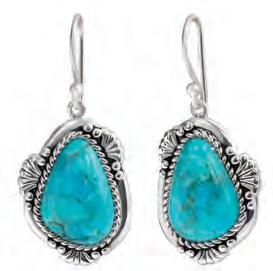


in Bali metalwork.
turquoise
*Special price only for customers using the offer code versus the price on Stauer.com without your offer code.
A.
B.
and
a
the
a unique, one-of-a-kind matrix surrounded
You could drop over $1,200 on a
pendant, or you could secure 26 carats of genuine Arizona turquoise for just $99 Your satisfaction is 100% guaranteed. If you aren’t completely happy with your purchase, send it back within 30 days for a complete refund of the item price. The supply of Arizona turquoise is limited, don’t miss your chance to own the Southwest’s brilliant blue treasure. Call today! 26 carats of genuine Arizona turquoise ONLY $99 C. Necklace enlarged to show luxurious color 14101 Southcross Drive W., Ste 155, Dept. STC690-09, Burnsville, Minnesota 55337 www.stauer.comStauer ® Call now and mention the offer code to receive your collection. 1-800-333-2045 Offer Code STC690-09 You must use the offer code to get our special price. Rating of A+ Stauer… Afford the Extraordinary ® Jewelry Specifications: • Arizona turquoise • Silver-finished settings Sedona Turquoise Collection A. Pendant (26 cts) $299 * $99 +s&p Save $200 B. 18" Bali Naga woven sterling silver chain $149 +s&p C. 1 1/2" Earrings (10 ctw) $299 * $99 +s&p Save $200 Complete Set** $747 * $249 +s&p Save $498 **Complete set includes pendant, chain and earrings. Sacred Stone of the Southwest is on the Brink of Extinction WIWP-221108-014 Stauer Turquoise Collection.indd 1 9/30/22 11:36 PM
Cowboy Archaeologist
That was a wonderful article by Lynda Sánchez on George Mc Junkin [“Black Cowboy Archaeol ogist,” Pioneers & Settlers, Febru ary 2022], who opened up a whole new world in American history. I leased a ranch for years not far from the Folsom Site. One day I found a Folsom point, and now I don’t know where I put it. Your magazine is a good one. Keep it up.
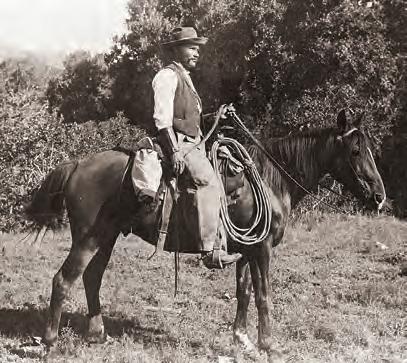
Buddy Wolfe McCoy, Texas
TOM TOBIN
I thoroughly enjoyed the articles on Tom Tobin by the Leonetti brothers, Daniel and Robert, in the June 2022 Wild West.
It is fascinating to read stories about unsung characters from the Old West that are just as exciting as the ones we all know about. Halfway through reading I thought what a great movie the Tobin story would make. When I finished, I discovered Daniel is also a screenwriter. I sure hope some producer takes note of this.
“Texas Bob” Reinhardt Canyon Lake, Texas
WYATT & A RELIC
In the December 2021 Roundup the short piece “Six-shooters for [John] Boessenecker,” who wrote Ride the Devil’s Herd: Wyatt Earp’s Epic Battle Against the West’s Biggest Outlaw Gang, caught my attention, and I ordered his book, which I have just finished reading. It is the most concise and wellresearched book I have read on the Earps and the history of Tombstone and that corner of Arizona and New Mexico. When he describes events, I can see them in my mind’s eye. A story well told. It’s a great read.
I was born in El Paso in 1938 and raised through my child hood in southern New Mexico. My brothers and I lived at my grandmother’s in Vado, just north of El Paso, and went to school in Mesilla. Her first husband died in the Battle of Columbus when Pancho Villa attacked the town. My brothers and I rode horses and camped along the Rio Grande, where my grand mother owned a cotton farm. My family was not very verbal in passing on the history of my kin, and, sadly, I failed to ask questions. It was great to read the detailed history of the “Cow boy” period of the late 19th century and the ebb and flow of the lives of the Earps.
In my early 20s I was living in Phoenix and de veloped a love affair with ghost towns and all things of the Old West. I had hiked into what’s left of Charleston and camped overnight there in the 1970s. I have traveled the roads that run along the
Arizona and New Mexico border with Mexico. I’ve been in Contention City and stood on what remained of the old train platform and been to Shakespeare (ghost town) and the areas of Benson, Bisbee, Douglas and Silver City. I’ve hiked in the Chirica hua and Dragoon mountains. In the 1990s I found an old musket, sawedoff to carbine length, half buried in the floor of a cave south of old Fort Grant. Long ago it was ingeniously repaired with copper wire (from telegraph poles?). I believed the end users were probably Apache Indians.
Boessenecker brought to life for me not only the Earp his tory but also what it was like to have lived in that part of the Southwest at that time. It is a very thorough examina tion of the time and events and the lives of those who lived through it. Knowing more about the details of that history has certainly piqued my interest to revisit those places where I lived in the shadow of the frontier and its iconic stamp on our imaginations. Thanks again for the piece about Boes senecker’s book.
Everett Davidson Prescott, Ariz.
Editor’s note: Wild West special contributor John Boesseneck er not only won a Wild West History Association Silver Star in the best Western book category for Ride the Devil’s Herd but also captured a second Silver Star in the general Western history article category for “They Shoot Cowboys, Don’t They?” which appeared in the October 2020 Wild West and is available online at historynet.com/they-shoot-cowboys.
THEY SHOOT HORSES
I have a question nobody ever addresses: How many horses got shot under fleeing bandits? Seems it would be an efficient way to stop or slow the culprit. Can you answer me or put me in touch with someone that can?
Dennis Strong Salinas, Calif.
Send letters by email to wildwest@historynet.com Please include your name and hometown @WildWestMagazine
Gunfighter and lawman expert John Boessenecker responds: The whole idea of mounted posses racing on horseback after outlaws in a running gunfight is largely the invention of Hollywood. So, the answer is very few horses got shot under fleeing bandits.
WILD WEST WINTER 20238
LYNDA
A.
SÁNCHEZ COLLECTION
LETTERS
George McJunkin was not your average cowboy. Also an amateur naturalist, he discovered bones of the extinct buffalo species Bison antiquus at what would become the Folsom Site in New Mexico.
WIWP-WINTER-2023-LETTERS.indd 8 10/3/22 1:15 PM
Western Jacket
Expertly Crafted of Mohave-brown Cotton Canvas with Cotton Twill Lined Interior

Comfortable Sherpa Collar
Lay Down the Law in Rugged Western Style Just Like John Wayne
John Wayne’s legendary movie career included many heroic roles, including the tough, no-nonsense U.S. Marshall who would go to any length to bring his man to justice. Now you can wear a fitting tribute to this star of the silver screen with our ruggedly handsome Legendary John Wayne Western Jacket

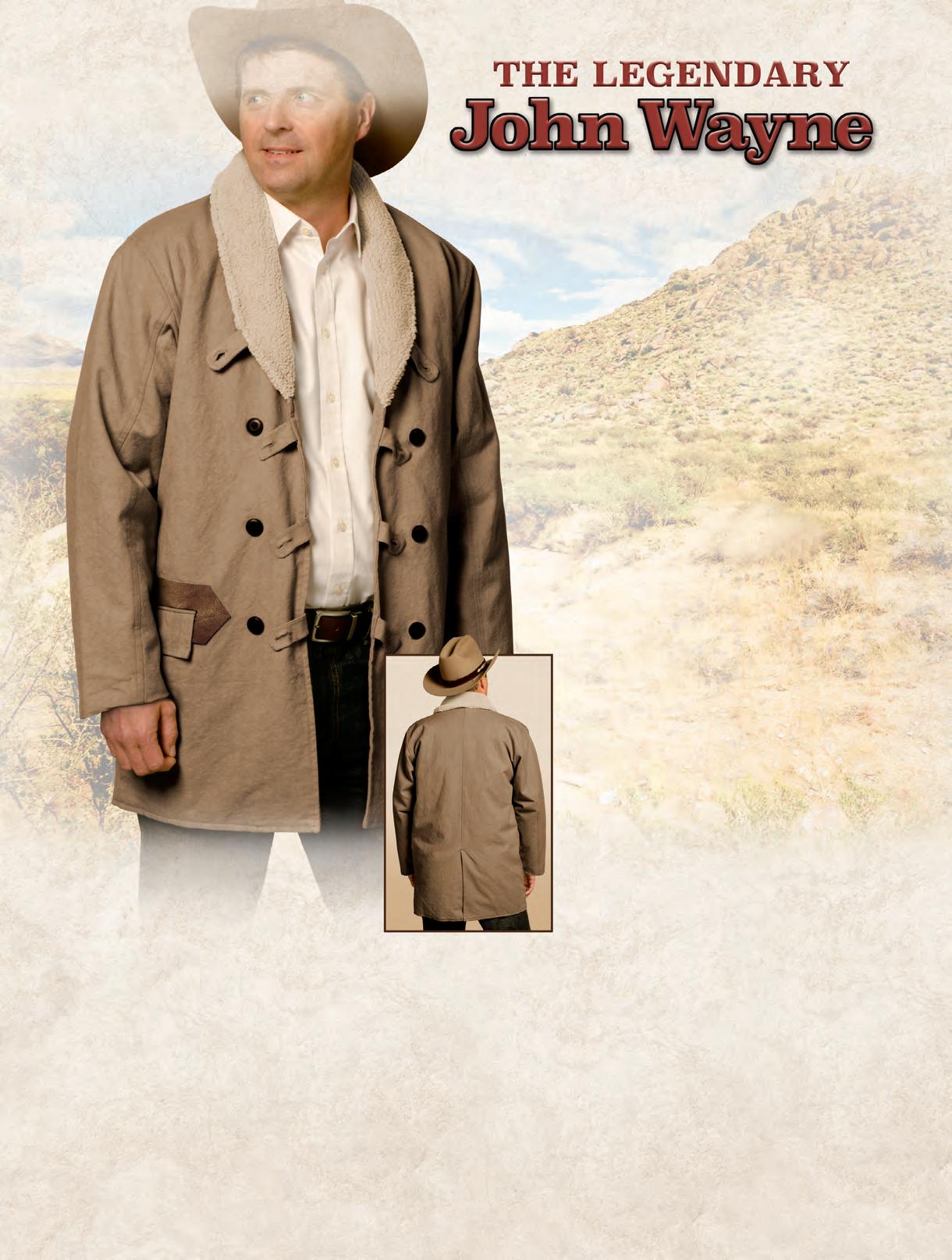
This custom design offered only by The Bradford Exchange is inspired by the same jacket John Wayne wore in his classic role as a U.S. Marshall. Masterfully crafted of Mohave-brown cotton canvas with cotton twill lining, the jacket provides the ultimate in comfort and classic western style. The boldly styled jacket features a Sherpa collar and a double breasted front button closure. Faux leather patch embossed with a U.S. Marshall’s star along with John Wayne’s signature is sewn inside, proof that you’re a certified fan! The jacket has a roomy fit, 2 side flap pockets and an inside slip pocket with faux leather accent. It’s a great way to honor the enduring spirit of a true American icon! Imported.
An Outstanding Value… Satisfaction Guaranteed
This custom jacket is a remarkable value at $169.95*, and you can pay for it in 4 easy installments of $42.49 each. To order yours, in men’s sizes from M-XXXL (for sizes XXL and XXXL, add $10), backed by our unconditional 30-day guarantee, you need send no money now. Just fill out and mail in your Priority Reservation today!

B_I_V = Live Area: 7 x 9.75, 1 Page, Installment, Vertical Logo Address Tracking Yellow Shipping Service
JOHN WAYNE, , DUKE/THE DUKE are the exclusive trademark property of John Wayne Enterprises, LLC. The John Wayne name and likeness and all other related indicia are the intellectual property of John Wayne Enterprises, LLC. Design © John Wayne Enterprises, LLC. All Rights Reserved. www.johnwayne.com ©2022 The Bradford Exchange 01-29931-001-BIBR1
Inspired by the Jacket John Wayne Wore in His Role as a U.S. Marshall!
Embossed Faux Leather Patch with John Wayne’s Signature Sewn in at the Neck
NOT AVAILABLE IN STORES!
Order Now at bradfordexchange.com/29931 Connect with Us! PRIORITY RESERVATION SEND NO MONEY NOW Signature Mrs. Mr. Ms. Name (Please Print Clearly) Address City State Zip Email E56301 The Bradford Exchange 9345 Milwaukee Avenue, Niles, Illinois 60714 Where Passion Becomes Art ❑ Medium (38-40) 01-29931-011 ❑ Large (42-44) 01-29931-012 ❑ XL (46-48) 01-29931-013 ❑ XXL (50-52) 01-29931-014 ❑ XXXL (54-56) 01-29931-015 YES. Please reserve the Legendary John Wayne Western Jacket in the size checked below for me as described in this announcement. LIMITED-TIME OFFER PLEASE RESPOND PROMPTLY *Plus a total of $18.99 shipping and service (see bradfordexchange.com). Please allow 2-4 weeks after initial payment for shipment. Sales subject to product availability and order acceptance. WIWP-221108-011 Bradford John Wayne Sherpa Jacket CLIPPABLE.indd 1 9/30/22 11:15 PM
Favorite Living Western Artists
OF
Bob Boze Bell
The longtime editor of True West magazine has authored and illustrated biographies of such iconic Westerners as Billy the Kid, Wyatt Earp, Wild Bill Hickok and Doc Holliday. Bell is a gifted artist known for his surreal gouache paintings. “I’m just a cartoonist,” he says, “with strong opinions.”

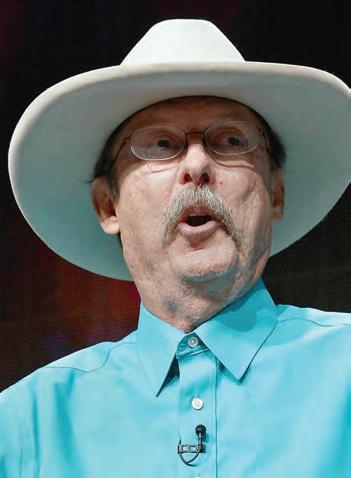

Nocona Burgess
Immensely proud of his heritage, this great-great-grandson of Quanah Parker, the last Comanche war chief, is known for his bold acrylic paintings of Indian figures and culture and has moved into sculpture.
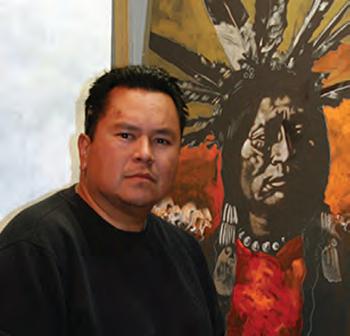
“My dad always said, ‘Every morning when I wake up, I thank God I’m a Comanche,’” the artist recalls.
Curtis Fort Born and raised on a working ranch in New Mexico, Fort might be as close to a modern-day Charles M. Russell as we’ll find, right down to his realistic bronze sculptures and cowboy drawl. Most of his works elicit a smile.
4
Dennis Hogan
An Indiana native, Gunsmoke fan and excellent worker of leather, silver and turquoise, Santa Fe–based Hogan pays homage to the past with a contemporary spin.
5
Douglas Magnus
Another Santa Fe–based silver smith, he creates high-end jewelry with a modern look and designs that evoke the past. In his “spare time” he dab bles as a photographer, videographer, plein air painter, etc.
6
Deana McGuffin
Those who don’t consider boot making an art form have never seen a pair of cowboy boots made by this Albuquerque legend who followed a path her grandfather forged in Roswell back in 1917. McGuffin will soon “retire” to try her hand at leatherwork and woodwork.

7
Barbara Meikle
Painter and sculptor Meikle is particularly drawn to that underappreciated hero of the American Southwest the donkey. Rife with humor, her

(2); REUTERS/ALAMY
CLOCKWISE FROM TOP LEFT: MARSHALL GALLERY, SCOTTSDALE; THOM ROSS; BARBARA MEIKLE; ZUMA PRESS INC/ALAMY STOCK
HISTORICAL
UC BERKELEY; DAVID G. THOMAS;
FROM LEFT: BANCROFT
WILD WEST WINTER 202310
PHOTO
LIBRARY,
STATE
SOCIETY
NORTH DAKOTA 10
ROUNDUP
1
2
3
Bob Boze Bell
Thom Ross
Nocona Burgess
Barbara Meikle Curtis Fort
Deana McGuffin
WIWP-WINTER-2023-ROUNDUP-BW.indd 10 10/4/22 5:22 PM
oils and bronzes also capture horses, Western wildlife and landscapes. She donates part of her earnings to equine rescue efforts and animal shelters.
Billy on Trial
This quirky and highly opinionated San Francisco native loves the West, baseball and literature, not necessarily in that order. His offbeat interpretations of iconic Western figures challenge viewers. Ross’ most recent project tackles Herman Melville’s Moby-Dick.
8Thom Ross
9 Billy Schenck
On April 8, 1881, Billy the Kid finally stood trial in Mesilla, New Mexico Territory, for the April 1, 1878, murder of Lincoln County Sheriff William Brady in the town of Lincoln. He was convicted of first-degree murder and sentenced to death by hanging. That sentence was never carried out, as he later escaped from custody at the Lincoln County Courthouse. On Aug. 13, 2022, Billy was on trial again—this time in a one-act play fittingly titled The Trial of Billy the Kid and presented at the Chiricahua Desert Museum’s Geronimo Event
After working with Andy Warhol in the mid-1960s, Schenck broke into the Contemporary Western/Southwestern Pop art scene with bold paintings inspired by late 1960s/early 1970s Spaghetti Westerns. He can hold forth about Western films for hours.
Don Yena This Navy vet goes all out to get everything just right in his paint ings. “I think the actual story of the American West is so fascinating,” he says from his studio in San Antonio, Texas. “I think it’s more exciting than fiction.”
—Johnny D. Boggs
For Whom the Bell Tolls

Swamped by a hurricane in the Atlantic Ocean some 160 miles off the coast of the Carolinas on Sept. 12, 1857, the 278-foot side-wheel steamship Central America sank with the loss of 425 of its 578 passengers and crew along with an immense cargo of gold (worth $765 million in today’s dol lars), much of it being transported to New York by men returning from the California Gold Rush.

Center in Rodeo, N.M. The Cochise County His torical Society and the Friends of Pat Garrett cosponsored the event, which drew a packed house of 200 people.
“The play fictionalized the real event,” said historian and filmmaker David Thomas, who wrote the feature article “The Trial of Billy the Kid” in the Autumn 2022 Wild West. “In the play Billy testified and had several witnesses testify in his defense. In the real trial the Kid did not testify and had no witnesses standing for him. Billy’s defense was that he had not killed Sheriff Brady, and, further, it was the cold-blooded mur der of John H. Tunstall that led to the violence in Lincoln the day that Brady was killed.” Despite the procedural differences, the outcome was the same—the jury found the Kid guilty.
—James McLaughlin, the agent at Standing Rock Indian Reservation, on the inter-Dakota border, wrote this in his annual report for the year ending July 31, 1883, about the great Hunkpapa Lakota leader Sitting Bull, by far the best-known Sioux on the reservation.
Commander William Lewis Herndon was justly credited with having safeguarded the lives of 153 passengers before going down with the ship. Be tween 1988 and 2014 expeditions to the wreck re covered gold and other artifacts from the seabed. Among the latter was Central America’s 268-pound bronze bell, which California business executive Dwight Manley recently donated to the U.S. Naval Academy in Annapolis, Md. At the heart of campus stands a granite obelisk in Herndon’s honor.

“The script compelled their decision,” Thomas said. The 15-member cast included the five pic tured above: (from left) Dan Crow as Judge Warren Henry Bristol, Kim Kvamme as prosecution witness Deputy Sheriff J.B. “Billy” Mathews, Bill Cavaliere (standing) as prosecuting attorney Simon B. Newcomb, Howard Topoff (seated out of view behind Cavaliere) as defense attorney Albert Jennings Fountain and Craig McEwan as the Kid. The Trial of Billy the Kid is scheduled to be performed at Schieffelin Hall in Tombstone, Ariz., on November 12 and at the Rio Grande Theatre in Las Cruces, New Mexico, on Feb. 25, 2023.

WILD WEST WINTER 2023 11
CLOCKWISE FROM TOP LEFT: MARSHALL GALLERY, SCOTTSDALE; THOM ROSS; BARBARA MEIKLE; ZUMA PRESS INC/ALAMY STOCK PHOTO (2); REUTERS/ALAMY FROM LEFT: BANCROFT LIBRARY, UC BERKELEY; DAVID G. THOMAS; STATE HISTORICAL SOCIETY OF NORTH DAKOTA WEST WORDS
10
‘I cannot understand how [Sitting Bull] held such sway over, or controlled men so eminently his superiors in every respect, unless it was by his sheer obstinacy and stubborn tenacity. He is pompous, vain and boastful and considers himself a very important personage’
WIWP-WINTER-2023-ROUNDUP-BW.indd 11 9/30/22 9:27 AM
Old West Town Resurfaces
In 1858 prospectors in California’s southern Sierra Nevada established a gold camp along the Kern River. It briefly went by the names Rogersville, Williamsburg and Whiskey Flat before becoming Kernville and qualifying for a post office in 1868. In the first half of the 20th century Kernville, some 35 miles northeast of Bakersfield, served as a backdrop for many Western movies, including John Ford’s 1939 classic Stagecoach, starring a young John Wayne. But in 1948, to solve flooding issues in Bakersfield, Congress acquired the land and appropriated funds to build the Isabella Dam, which the Corps of Engineers completed in 1953. By then Kernville had been razed, its residents forming a new Kernville on higher ground. Most years the original townsite remains well beneath 11,200-acre Lake Isabella—though it pops up, literally and in the news, whenever rain is scarce. During a recent drought the water level dropped enough to expose the foundations of old Kernville’s jail, a store, a school, a church and other structures. Townsfolk are happy to bid the past goodbye in favor of precious water.
Button Down
it
Marshal’
—Jack McCall, who murdered Wild Bill Hickok in Deadwood, Dakota Territory, on Aug. 2, 1876, spoke these words as U.S. Marshal J.H. Burdick cinched a noose around his neck atop the gallows in Yankton on March 1, 1877. As the trap was sprung at 10:10 a.m., McCall was heard to gasp, “Oh, God!”
Visitors strolling the Little Bighorn Battlefield National Monument this summer happened across a Civil War–era uniform cuff button bear ing an embossed eagle with outspread wings and a shield. Both Union and Confederate soldiers wore such buttons during the war. This exam ple may have been lost by one of Lt. Col. George

the artifact would go into the museum collection. Over the decades soldiers, passersby, archae ologists and park rangers have recovered some 26,000 artifacts from the battlefield, including weapons, ammunition and personal items.

Custer & Wild Bill
A Model 1873 Colt Single Action Army revolver issued to the 7th U.S. Cavalry on July 2, 1874, and reportedly recovered two years later from the Little Bighorn battlefield in Montana Territory realized $763,750 (well over the estimated high sale price of $550,000) at Rock Island Auction Co.’s May 13–15 Premier Firearms Auction. One of the Plains Indian warriors who prevailed over Lt. Col. George Custer and his immediate command on June 25, 1876, claimed to have col lected the revolver from the field of battle. In 1915
Armstrong Custer’s soldiers during the 7th U.S. Cavalry’s defeat at that Montana Territory battle field on June 25–26, 1876. That isn’t for certain, though, as such buttons were issued to enlisted men from 1855 to ’85. Its finders weren’t about to break federal law as keepers but left the button where it lay half-buried in the dirt. They took only photographs and reported their finding to park staff. While rangers didn’t indicate just where in the park the button turned up, they promised
he traded the pistol for a pair of pants and a blan ket, and the Colt remained in the trader’s family for generations.
The auction also featured an engraved Colt 1851 Navy revolver (Serial No. 204685) attributed to Wild Bill Hickok, which commanded $616,875 (nearly triple the estimated high sale price of $225,000). The Colt was once on display with its Navy mate (Serial No. 204672) at the Cody Firearms Museum in Cody, Wyo. They have match ing engraving and antique ivory grips, and both were manufactured in 1868.
Another Hickok revolver caused a stir at the Rock Island’s Aug. 26–28 Premier Firearms Auction. A Smith & Wesson Model No. 2 Hickok car ried—perhaps one he had on him when shot down by Jack McCall during a Deadwood, Dakota Territory, poker game on Aug. 2, 1876—brought a win ning bid of $235,000. While Hickok was most associated with the Colt 1851 Navy, later in life he favored the smaller, more accurate S&W No. 2. Other highlights of the August auction included an 1891 Colt Single Action Army that went for $763,750 and a Winchester Model 1873 “One of One Hundred” lever-action rifle that hammered down at $440,625.

WILD WEST WINTER 202312 FROM TOP: KVPICS, CC BY-SA 4.0; ROCK ISLAND AUCTIONS; LITTLE BIGHORN BATTLEFIELD NATIONAL MONUMENT, NATIONAL PARK SERVICE
FAMOUS LAST WORDS ‘Draw
tighter,
WIWP-WINTER-2023-ROUNDUP-BW.indd 12 10/3/22 2:17 PM
On May 18, 1980, the once-slumbering Mount St. Helens erupted in the Pacific Northwest. It was the most impressive display of nature’s power in North America’s recorded history. But even more impressive is what emerged from the chaos... a spectacular new creation born of ancient minerals named Helenite. Its lush, vivid color and amazing story instantly captured the attention of jewelry connoisseurs worldwide. You can now have four carats of the world’s newest stone for an absolutely unbelievable price.
Known as America’s emerald, Helenite makes it possible to give her a stone that’s brighter and has more fire than any emerald without paying the exorbitant price. In fact, this many carats of an emerald that looks this perfect and glows this green would cost you upwards of $80,000. Your more beautiful and much more affordable option features a perfect teardrop of Helenite set in gold-covered sterling silver suspended from a chain accented with even more verdant Helenite.

Limited Reserves. As one of the largest gemstone dealers in the world, we buy more carats of Helenite than anyone, which lets us give you a great price. However, this much gorgeous green for this price won’t last long. Don’t miss out. Helenite is only found in one section of Washington State, so call today!



Romance guaranteed or your money back. Experience the scintillating beauty of the Helenite Teardrop Necklace for 30 days and if she isn’t completely in love with it send it back for a full refund of the item price. You can even keep the stud earrings as our thank you for giving us a try.

Stauer… Afford the Extraordinary . ®
• 4 ¼ ctw of American Helenite and lab-created DiamondAura® • Gold-finished .925 sterling silver settings • 16" chain with 2" extender and lobster clasp Rating of A+ 14101 Southcross Drive W., Ste 155, Dept. HEN435-01, Burnsville, Minnesota 55337 www.stauer.comStauer ® * Special price only for customers using the offer code versus the price on Stauer.com without your offer code. Helenite Teardrop Necklace (4 ¼ ctw) $299* .....Only $129 +S&P Helenite Stud Earrings (1 ctw) ....................................... $129 +S&P Helenite Set (5 ¼ ctw) $428* ...... Call-in price only $129 +S&P (Set includes necklace and stud earrings) Call now and mention the offer code to receive FREE earrings. 1-800-333-2045 Offer Code HEN435-01 You must use the offer code to get our special price. Uniquely American stone ignites romance Tears From a Volcano Necklace enlarged to show luxurious color EXCLUSIVE FREE Helenite Earrings -a $129 valuewith purchase of Helenite Necklace 4 carats of shimmering Helenite Limited to the first 1600 orders from this ad only “I love these pieces... it just glowed... so beautiful!” — S.S., Salem, OR WIWP-221108-012 Stauer Helenite Teardrop Necklace.indd 1 9/30/22 11:25 PM
L.Q. JONES
Craggy-faced character actor L.Q. Jones, 94, who featured in the Sam Peckinpah Westerns Ride the High Country (1962), Major Dundee (1965), The Wild Bunch (1969), The Ballad of Cable Hogue (1970) and at least 55 other movies, died on July 9, 2022, at his home in Los Angeles. In the Budd Boetticher Western Buchanan Rides Alone (1958) his character defies an order to kill fellow Texan Tom Buchanan (portrayed by Randolph Scott), and in Hang ‘em High (1968) he slips a noose around the neck of Clint Eastwood. Born Justus Ellis McQueen Jr. on Aug. 19, 1927, in Beaumont, Texas, Jones also appeared in many 1950s–60s TV Westerns, including Cheyenne, Gunsmoke, Wagon Train and The Virginian. For a change of pace in 1975 he directed, produced and helped write the postapocalyptic comedy A Boy and His Dog
JAMES CAAN
Though perhaps best known for his role as Sonny Corleone in The Godfather (1972) or his portrayal of cancer-stricken Chicago Bears football player Brian Piccolo in Brian’s Song (1971), James Caan earlier made a notable appearance as the knife-throwing gambler “Mississippi” in Howard Hawks’ Western El Dorado (1966). Caan, who was born in New York City on March 26, 1940, died at age 82 in Los Angeles on July 6, 2022. In El Dorado Caan’s character sides with principal stars John Wayne and Robert Mitchum in a Western that is alternately gritty and amusing. He also appeared in such golden-era TV Westerns as Death Valley Days and Wagon Train
CLU GULAGER
The many TV roles of actor Clu Gulager, 93, who died in Los Angeles on Aug. 5, 2022, included his portrayal of a heroic Billy the Kid in The Tall Man (1960–62, with Barry Sullivan as Pat Garrett) and Deputy Emmett Ryker for four seasons (1964–68) of The Virginian. Born William Martin Gulager in Holdenville, Okla., on Nov. 16, 1928, he was an enrolled member of the Cherokee Nation of Oklahoma. His paternal grandmother, Martha Schrimsher Gulager, was a sister to Mary America Schrimsher Rogers, the mother of humorist Will Rogers. In his final role Gulager appeared as a bookstore owner in the 2019 Quentin Tarantino comedy-drama Once Upon a Time in Hollywood.
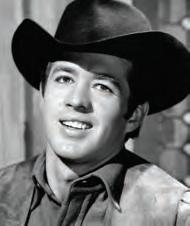
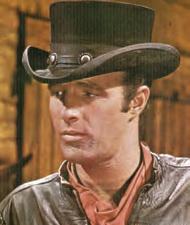
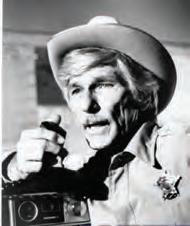
Mankiller Quarter
The likeness of Wilma Mankiller (1945–2010), the first female principal chief of the Cherokee Nation, appears on the reverse of a new quarter coin, part of the U.S. Mint’s American Women commemorative program. Mankiller is depicted wearing a traditional shawl beside the seven-point star of the Cherokee Nation. A bust of President George Washington still graces the face of the coin. Other Indian women to have appeared on American currency include Pocahontas (on the reverse of a $20 bill in the 1860s) and Sacagawea (on the face of a dollar coin introduced in 2000 and first minted for general circulation in 2002).

Eye for Eye
L.J. Martin writes Western novels, nonfiction works and screenplays and is a co-founder of Wolfpack Publishing. He’s also a movie buff. But after 35 years Hollywood had yet to come calling, so he resolved to adapt one of his own novellas, Eye for Eye, into a recently released film. Filming was done on his ranch near Missoula, Mont. His executive producer is Hollywood public rela tions master David Mirisch, who brought aboard actors John Savage and Blanca Blanco. For the lead male role Martin picked friend and Montana native Shane Clouse, a songwriter and balladeer who also wrote the theme song. The film is avail able on Amazon Prime Video.
Carlyle Headstone
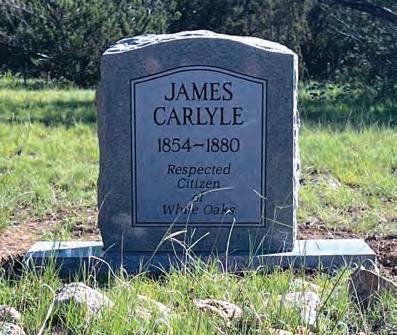
On Nov. 27, 1880, a posse out of White Oaks, New Mexico Territory, including deputized local black smith and ex-buffalo hunter James Carlyle, sur
rounded a roadside tavern known to locals as Greathouse Station. Trapped inside were sus pected rustlers, including Billy the Kid. At some point Carlyle set down his gun, went inside and tried to negotiate a surrender, but he was shot down. The posse lost interest and withdrew. The next morning locals found Carlyle’s body wrapped in a blanket and hastily buried in the frozen, rocky earth. A day later possemen returned, burned the tavern to the ground and exhumed Carlyle’s body. Placing it in a wooden box, they reburied it on a hilltop overlooking the smoldering ruins.
For 142 years only a mound of rocks marked the grave. All that changed on Aug. 5, 2022, when Carlyle got a headstone, thanks to the efforts of Lucas Speer, Jerry Prather and Josh Slatten, board members of Billy the Kid’s Historical Coalition (BTKHC). A short service followed, attended by members of BTKHC, Cold West, the Friends of Pat Garrett and the Wild West History Association.
WILD WEST WINTER 202314
LEFT, FROM TOP: EVERETT COLLECTION; WARNER BROS./GETTY IMAGES; EVERETT COLLECTION; U.S. MINT; RIGHT: JOSH SLATTEN
SEE YOU LATER... WIWP-WINTER-2023-ROUNDUP-BW.indd 14 9/30/22 9:29 AM
Notonly are these hefty bars one full Troy ounce of real, .999 precious silver, they’re also beautiful, featuring the crisp image of a Morgan Silver Dollar struck onto the surface. That collectible image adds interest and makes these Silver Bars even more desirable. Minted in the U.S.A. from shimmering American silver, these one-ounce 99.9% fine silver bars are a great alternative to one-ounce silver coins or rounds. Plus, they offer great savings compared to other bullion options like one-ounce sovereign silver coins. Take advantage of our special offer for new customers only and save $5.00 off our regular prices.




Morgan Silver Dollars Are Among the Most Iconic Coins in U.S. History
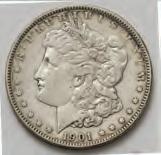


What makes them iconic? The Morgan Silver Dollar is the legendary coin that built the Wild West. It exemplifies the American spirit like few other coins, and was created using silver mined from the famous Comstock Lode in Nevada. In fact, when travelers approached the mountains around the boomtown of Virginia City, Nevada in the 1850s, they were startled to see the hills shining in the sunlight like a mirror. A mirage caused by weary eyes?
No, rather the effect came from tiny flecks of silver glinting in the sun.




A Special Way for You to Stock Up on Precious Silver
While no one can predict the future value of silver in an uncertain economy, many Americans are rushing to get their hands on as much silver as possible, putting it away for themselves and their loved ones. You’ll enjoy owning these Silver Bars. They’re tangible. They feel good when you hold them, You’ll relish the design and thinking about all it represents. These Morgan Design One-Ounce Bars make appreciated gifts for birthdays, anniversaries and graduations, creating a legacy sure to be cherished for a lifetime.

Order More and SAVE

You can save $5.00 off our regular price


buy now. There is a limit of 25 Bars per customer, which means with





Hurry.

GovMint.com • 1300 Corporate Center Curve, Dept. MSB183-01, Eagan, MN 55121
when you
this special offer, you can save up to $125.
Secure Yours Now! Call right now to secure your .999 fine silver Morgan Design One-Ounce Silver Bars. You’ll be glad you did. One-Ounce Silver Morgan Design Bar $49.95 ea. Special o er - $44.95 ea. +s/h SAVE $5 - $125 Limit of 25 bars per customer Free Morgan Silver Dollar with every order over $499 (A $59.95 value!) FREE SHIPPING over $149! Limited time only. Product total over $149 before taxes (if any). Standard domestic shipping only. Not valid on previous purchases. For fastest service call today toll-free 1-888-201-7144 Offer Code MSB183-01 Please mention this code when you call. SPECIAL CALL-IN ONLY OFFER Fill Your Vault with Morgan Silver Bars GovMint.com® is a retail distributor of coin and currency issues and is not a liated with the U.S. government. e collectible coin market is unregulated, highly speculative and involves risk. GovMint.com reserves the right to decline to consummate any sale, within its discretion, including due to pricing errors. Prices, facts, gures and populations deemed accurate as of the date of publication but may change signi cantly over time. All purchases are expressly conditioned upon your acceptance of GovMint.com’s Terms and Conditions (www.govmint. com/terms-conditions or call 1-800-721-0320); to decline, return your purchase pursuant to GovMint.com’s Return Policy. © 2022 GovMint.com. All rights reserved. Actual size is 30.6 x 50.4 mm 99.9% Fine Silver Bars Grab Your Piece of America’s Silver Legacy BUY MORE SAVE MORE! BUY MORE SAVE MORE! BUY MORE SAVE MORE! A+ WIWP-221108-016 GovMint Morgan Silver Bars.indd 1 9/30/22 11:18 PM
Hardly Over the Hill
EMMY-WINNING DIRECTOR WALTER HILL TALKS WESTERN MOVIES AND HISTORY
BY JOHNNY D. BOGGS
For a Hollywood director and screenwriter who came into the business around the time Westerns started to fade in popularity, Walter Hill has certainly made a name for himself in the genre, having received best director Emmy Awards for the pilot epi sode of HBO’s Deadwood (2004) and the two-part miniseries Broken Trail (2006). Broken Trail also earned Hill a Western Heritage Award from the National Cowboy & Western Heritage Museum in Oklahoma City, as did his big-screen film Geronimo: An American Legend (1993).
The director of The Long Riders (1980) and Wild Bill (1995) will turn 81 on Jan. 20, 2023, but Hill isn’t slowing down. In 2021 he wrapped work as screenwriter and director of the forthcoming independently produced Western Dead for a Dollar, starring two-time Academy Award recipient Christoph Waltz. While filming near Santa Fe, Hill took time to discuss Western films and history with Wild West
What brought you to Dead for a Dollar?
It’s a script I’d been working on for about a year and a half, not c onstantly. There was a real historical character, Chris Madsen [a Denmark-born deputy U.S. marshal and one of Oklahoma Territory’s “Three Guardsmen” with fellow law men Heck Thomas and Bill Tilghman].…I thought the idea of a European immigrant as protagonist [Waltz as bounty hunter Max Borlund] was a nice, off-center way of getting into a story. We’re so used to the Joel McCrea, Randolph Scott, John Wayne Anglo kind of guy.

Yet you chose not to make it a Madsen biopic. No. Madsen’s intriguing, but the more I wrote, the less I pushed that idea. [Borlund] never was Chris Madsen. So I tried to give him his own point of view and distinct personality. Madsen was somewhat controversial.
How do you set about researching a film or character?
Reading Western history can be frustrating. A lot of it is incomplete, and an awful lot of it is contradictory. There’s very little backup for most of it. [Authors] quote local newspapers, which were notorious, for most of it. Trying to piece together who was a good guy, who was a bad guy in these historical char acters is, let me say, a rocky and narrow trail.
Do you enjoy history?
I like to read history. I was a his tory major and a lit minor. I can not tell you I was a great student.
Talk about Jesse James and The Long Riders.
I tried to emphasize certain things—that it was a Midwestern story, not a Western story; that they were farm boys, not cowboys. Some of the stuff I thought worked very well in the movie. But I don’t think it got to be a complete dramatic experience. David Carradine [as Cole Younger] was wonderful.
One of the best portrayals of Younger on film?
I really think so, yes.…The real Cole Younger wasn’t a lot like David Carradine. I’d be the first to tell you that. Probably the closest to what he was really like was Jimmy Keach’s Jesse.… He was a natural leader, and he was kind of crazy. They were all kind of afraid of him. When he said, “Let’s ride,” they rode.
What are your memories of filming Geronimo?
I have some complicated feelings about the movie.
I always said the title of the movie should have been The Geronimo War.
I wanted [viewers] to see the Army was a divided camp. In many ways the people who understood and were most sympathetic to the American Indians were members of the Army. Now, it wasn’t universally true by any means. Some of the most savage opponents were affiliated with the Army. [Lieutenant Charles] Gatewood [portrayed by Jason Patric] is…as [scout Al] Sieber said of him. He’s a sad case. He didn’t hate the enemy, and he didn’t love who he was fighting for.
I tried to use as much…of [Geronimo’s] dialogue recorded by what seemed to be reasonable sources of that time. His purported autobiography I don’t think is quite what the old man was thinking. But his last speech, on the train, which I wrote, was partially a cosmic understanding of the dilemma —that they weren’t going to win, and Geronimo says their time has passed. He meant their time as a dominant force. That’s not to in any way to forgive their treatment.
To read the full interview visit historynet.com.
WILD WEST WINTER 202316 UNITED ARTISTS
INTERVIEW
Walter Hill directs a scene from his 1980 Western The Long Riders while actors Duke Stroud (left) and Peter Jason, both playing Pinkerton men, await their cues.
WIWP-WINTER-2023-INTERVIEW.indd 16 9/30/22 9:30 AM







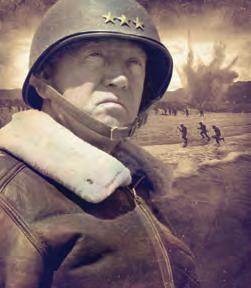
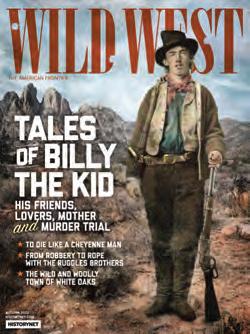
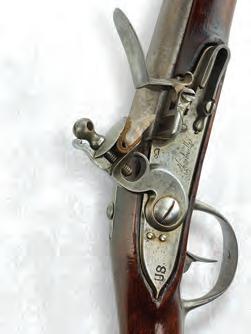



Order by Dec. 6 and you’ll receive FREE gift announcement cards that you can send out in time for the holidays! LIMITED-TIME HOLIDAY OFFER CHOOSE ANY TWO SUBSCRIPTIONS FOR ONLY $29.95 TWO-FOR-ONE SPECIAL! CALL NOW! 1.800.435.0715 PLEASE MENTION CODE HOLIDAY WHEN ORDERING SCAN HERE! OR VISIT HISTORYNET.COM/HOLIDAY Offer valid through January 8, 2023 * For each MHQ subscription add $15 Vicksburg Chaos Former teacher tastes combat for the first time Elmer Ellsworth A fresh look at his shocking death Plus! Stalled at the Susquehanna Prelude to Gettysburg Gen. John Brown Gordon’s grand plans go up in flames Tulsa Race Riot: What Was Lost Colonel Sanders, One-Man Brand J. Edgar Hoover’s Vault to Fame The Zenger Trial and Free Speech Yosemite The twisted roots of a national treasure HISTORYNET.com JUL 2020 H H HISTORYNET.COM JUDGMENT COMES FOR THE BUTCHER OF BATAAN THE STAR BOXERS WHO FOUGHT A PROXY WAR BETWEEN AMERICA AND GERMANY PATTON’S EDGE THE MEN OF HIS 1ST RANGER BATTALION ENRAGED HIM UNTIL THEY SAVED THE DAY In 1775 the Continental Army needed weapons— and fast World War II’s Can-Do City Witness to the White War ARMS RACE THE QUARTERLY JOURNAL OF MILITARY HISTORY An ammunition dump explodes during the April 1972 battle for An Loc. Defeating Enemy Stereotypes White and Black POWs bonded as cellmates The Green Berets Battles that inspired the book and movie TERROR AT AN LOC 9TH CAVALRY’S HEROIC FIGHT TO RESCUE DOWNED AIRMEN Huey Haven Old Warbirds Are Getting a New Museum HOMEFRONT Sweet success for Sammy Davis Jr. JUNE 2022 HISTORYNET.COM HNET SUB AD_HOLIDAY-2022.indd 1 8/30/22 8:34 AM
A Strongwilled Texas Scout
Ason of the South, Henry Woodson Strong wore many hats as a young adult in north east Texas, where he raised hogs and later sheep and in between served as a civilian scout and guide for Colonel Ranald S. Mackenzie.
In 1926 he recounted his early days in the “Lone Star State” in his self-published 122-page memoir My Fronter Days and Indian Fights on the Plains of Texas
“The photo card is a card he would sign and give with the book,” collector Tony Sapienza says of this image.
“It’s rare to have the two together.” The author struck a different pose for the cover of his book. Born in Carroll County, Miss., on March 27, 1849, Strong grew up on his father’s turpentine plantation in Choctaw County, Ala. He briefly attended Spring Hill, a Jesuit college in Mobile, before joining a Confederate cav alry unit at age 15 and serving through the Civil War.
“He was an unrepentant Confederate,” says Sapienza. By 1870 Strong was in Texas and soon started raising hogs near Jacksboro. Around 1873, despite his Rebel sympathies, he signed on to scout for Mackenzie in his expeditions against renegade Comanches and Kiowas, doing battle and rescuing captives. On July 7, 1875, in the wake of the Red River War, Strong mar ried Sarah Eleanor “Pinkie” Parks in Wichita County, where in 1882 Henry began running sheep. By de cade’s end the Strongs, who ultimately raised seven children, had made Grayson County their home. In 1924 Pinkie died at age 70 in Waxahachie, the Ellis County seat. Oddly enough, though her husband sur vived her, the death certificate lists her as a widow.
On May 14, 1928, Henry, 79, died at the home of a niece in Palestine, the Anderson County seat. He’s buried in the Palestine City Cemetery.

TONY SAPIENZA COLLECTION
WESTERNERS
WILD WEST WINTER 202318 WIWP-WINTER-2023-WESTERNERS.indd 18 9/30/22 9:31 AM
It was a perfect late autumn day in the northern Rockies. Not a cloud in the sky, and just enough cool in the air to stir up nostalgic memories of my trip into the backwoods. is year, though, was di erent. I was going it solo. My two buddies, pleading work responsibilities, backed out at the last minute. So, armed with my trusty knife, I set out for adventure.
Well, what I found was a whole lot of trouble. As in 8 feet and 800-pounds of trouble in the form of a grizzly bear. Seems this grumpy fella was out looking for some adventure too. Mr. Grizzly saw me, stood up to his entire 8 feet of ferocity and let out a roar that made my blood turn to ice and my hair stand up. Unsnapping my leather sheath, I felt for my hefty, trusty knife and felt emboldened. I then showed the massive grizzly over 6 inches of 420 surgical grade stainless steel, raised my hands and yelled, “Whoa bear! Whoa bear!” I must have made my point, as he gave me an almost admiring grunt before turning tail and heading back into the woods.
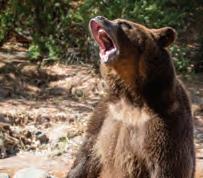
But we don’t stop there. While supplies last, we’ll include a pair of $99 8x21 power compact binoculars FREE when you purchase the Grizzly Hunting Knife.

Make sure to act quickly. The Grizzly Hunting Knife has been such a hit that we’re having trouble keeping it in stock. Our first release of more than 1,200 SOLD OUT in TWO DAYS! After months of waiting on our artisans, we've finally gotten some knives back in stock. Only 1,337 are available at this price, and half of them have already sold!
•
•
•
I was pretty shaken, but otherwise ne. Once the adrenaline high subsided, I decided I had some work to do back home too. at was more than enough adventure for one day.
Our Grizzly Hunting Knife pays tribute to the call of the wild. Featuring stick-tang construction, you can feel con dent in the strength and durability of this knife. And the hand carved, natural bone handle ensures you won’t lose your grip even in the most dire of circumstances. I also made certain to give it a great price. After all, you should be able to get your point across without getting stuck with a high price.
The

Knife Speci cations:
Stick tang 420 surgical stainless steel blade; 7 ¼" blade; 12" overall
Hand carved natural brown and yellow bone handle • Brass hand guard, spacers and end cap
FREE genuine tooled leather sheath included (a $49 value!)
Grizzly Hunting Knife $249 $79* + S&P Save $170 California residents please call 1-800-333-2045 regarding Proposition 65 regulations before purchasing this product. *Special price only for customers using the offer code. 1-800-333-2045 Your Insider Offer Code: GHK184-02 Stauer, 14101 Southcross Drive W., Ste 155, Dept. GHK184-02, Burnsville, MN 55337 www.stauer.com Stauer® | AFFORD THE EXTRAORDINARY ® A 12-inch stainless steel knife for only $79 I ‘Bearly’ Made It Out Alive What Stauer Clients Are Saying About Our Knives “The feel of this knife is unbelievable... this is an incredibly fine instrument.” — H., Arvada, CO “This knife is beautiful!” — J., La Crescent, MN 79 Stauer®Impossible Price ONLY Join more than 322,000 sharp people who collect stauer knives EXCLUSIVE FREE Stauer 8x21 Compact Binoculars -a $99 valuewith your purchase of the Grizzly Hunting Knife WIWP-221108-013 Stauer Grizzly Hunting Knife.indd 1 9/30/22 11:23 PM
Lest Ye Be Judged
On March 3, 1871, President Ulysses S. Grant nominated Story and Congress confirmed him to the bench of the new district court, which oper ated out of Fort Smith and was responsible for all federal legal matters occurring within its approximately 75,000-square-mile jurisdiction, from western Arkansas into Indian Territory (present-day Oklahoma). While Congress had split Arkansas into two federal districts in 1851, successive judges had presided over both until Story took the helm of the Western District.
The court struggled with the racial strife of Reconstruction and grappled with frontier law lessness amid disputes over Indian sovereignty and white settlement. It dispatched marshals into Indian Territory to arrest and bring to trial individuals accused of crimes. Yet so vast was the district, it could take days, weeks, sometimes months for lawmen to scour the boundaries of the territory and return with fugitives in tow. Complicating matters was the recurring question of jurisdiction—whether a suspect should be tried in an Indian court (of which there were several) or Story’s federal district court.
It was a plum assignment for Story, though newspapers in his home state of Wisconsin ex pressed doubts about the readiness of its young native. “That boy grew up without any particular aim in life, read law a short time in Milwaukee, provided himself with a carpet bag and went to Arkansas,” The Oshkosh Times wrote rather uncharitably. Though it deemed him “not very promising,” the paper said his family connec tions gave him “some degree of eminence.”
BY JULIA BRICKLIN
hen former federal judge and Colorado lieutenant governor William Story died in 1921, newspaper obituaries glossed over the most turbulent episode of his career. In 1874, under threat of impeachment, he had resigned as judge of the U.S. District Court for the Western District of Arkansas. Before the court garnered headlines as the jurisdiction of Isaac “Hanging Judge” Parker and Deputy U.S. Marshal Bass Reeves, it was the domain of Story, a man considered by many contemporaries the most corrupt judge in the West.
W
Born in Waukesha County on April 4, 1843, Story earned a law degree from the University of Michigan in 1864. He may have been encouraged in his career choice by the memory of his paternal great uncle Joseph Story, who’d been an associate justice of the U.S. Supreme Court. After serving in the Union Army during the Civil War, young Story practiced law in Wisconsin and Arkansas. In 1867 Governor Isaac Murphy of Arkansas appointed him as a judge in the state’s Eighth Judicial Cir cuit, in the southwest part of the state. Soon after taking office in 1869, Republican Governor Pow ell Clayton appointed Story to the bench of the Second Judicial Circuit, in northeastern Arkan sas. “The youngest judge of the grade in America is William Story, of the Arkansas court,” Wisconsin’s

WILD WEST WINTER 202320 LEFT: OLD STATE HOUSE MUSEUM, LITTLE ROCK; RIGHT: LIBRARY OF CONGRESS
BEFORE RESIGNING IN DISGRACE, FEDERAL JUDGE WILLIAM STORY PRECEDED THE MORE CELEBRATED ‘HANGING JUDGE’ ISAAC PARKER IN ARKANSAS’ WESTERN DISTRICT
GUNFIGHTERS & LAWMEN
William Story was judge of the U.S. District Court for the newly created Western District of Arkansas till resigning under threat of impeachment in 1874. He later served as the seventh lieutenant governor of Colorado (1891 to ‘93) under Governor John Long Routt.
DENVER PUBLIC LIBRARY, COLORIZATION BY HISTORYNET WIWP-WINTER 2023-G&L.indd 20 9/30/22 9:32 AM
Janesville Daily Gazette trumpeted on Jan. 26, 1869. “He is 25 years old.”
Two years later came his appoint ment to the Western District, a plum position paying $6,000 a year, a hefty sum at the time. Taking up residence at the Metropolitan Hotel in Little Rock, 28-year-old Story went to work, hiring commissioners and marshals, and the papers soon reported he had his court up in “apple pie order” and running like “well-oiled machinery.”
Within a few months of his arrival, however, he fell dangerously ill. On June 17, 1871, the jurist overdosed on chloroform he’d reportedly pur chased and taken by mistake to alle viate a headache. It took a doctor several hours to revive him, and Story several days to fully recover. It was a harbinger of trouble to come.
Actively involved in Republican politics, Story had supported Arkansas’ First Dis trict congressman Logan H. Roots in the latter’s unsuccessful 1870 campaign for re-election. Roots had supported Story’s appointment to the bench, so the judge softened the blow of Roots’ defeat by hiring him as marshal of the Western District. Story also hired, as commissioners, two other men with whom he was politically aligned. Little more than a year after he took the bench, however, the U.S. attorney forced out Roots as marshal amid reports of fraud and soaring ex penses. One rival newspaper claimed the mar shal, with Story’s tacit approval, had dispatched deputies to round up sympathetic townsmen to vote for certain candidates in a local election. Meanwhile, local attorneys complained about Story’s two hired commissioners, accusing them of having withheld payments to witnesses who had often traveled hundreds of miles to appear in court, forcing some to sell personal effects to pay their expenses.
Story himself allowed marshals to charge the federal government for work they apparently never did, raising the question of whether he was getting kickbacks. “Parties who never left town,”
Little Rock’s Daily Arkansas Gazette reported, “were allowed and paid full fees of all kinds for hunting after prisoners, and some parties were allowed [and paid] for arrests made at a distance, when they did not leave town or make any ar rests.” Moreover, the paper alleged, Story signed blank vouchers and let marshals charge whatever they chose, without submitting proper receipts, a practice that cost taxpayers hundreds of thou
sands of dollars. Worse still, cases listed on some vouchers were fabrications. The attorneys also questioned Story’s handling of certain cases, par ticularly his decision to allow the release of one convicted murderer on bail before sentencing— a man who was neither pursued nor retried.
According to Story’s biographer, it was a May 1873 bribery charge that sealed his fate. The charge accused the judge of having accepted $2,500 to dismiss an indictment against an In dian Territory druggist for having illegally sold liquor to Indians. A U.S. attorney was accused of having accepted a $500 bribe to further guaran tee a dismissal in the case. Such accusations continued to swirl around Story and his court until finally, in early 1874, Congress started a for mal investigation. It ultimately charged him with 19 counts of corruption, notably the sale of his office for favors. Story appeared before the U.S. House Judiciary Committee, which found his ex planations for such alleged transgressions “lame, disconnected and unsatisfactory.”
Rather than face impeachment, Story resigned, on June 17, 1874. President Grant appointed Judge Parker in his place and tasked the “Hanging Judge” with reforming the federal court for the West ern District. Story moved his family to Ouray, Colo., where, despite the recent allegations of corruption, he built a successful law practice. In 1891, after a move to Denver, he was elected Colo rado’s lieutenant governor. In 1913 he relocated to Salt Lake City, where he resumed private law practice. Story eventually retired to Los Angeles, dying there at age 78 on June 20, 1921.

Above left: Arkansas Governor Isaac Murphy appointed Story as a judge in the state’s Eighth Judicial Circuit, in the southwest part of the state. Above: When Governor Powell Clayton took office in 1869, he appointed Story to the bench of the Second Judicial Circuit, in northeastern Arkansas.

According to Story’s biographer, it was a May 1873 bribery charge that sealed his fate
WILD WEST WINTER 2023 21 LEFT: OLD STATE HOUSE MUSEUM, LITTLE ROCK; RIGHT: LIBRARY OF CONGRESS
DENVER PUBLIC LIBRARY, COLORIZATION BY HISTORYNET WIWP-WINTER 2023-G&L.indd 21 9/30/22 9:33 AM
Happy Christmas 1871!

PROPER ENGLISHWOMAN ROSE GEORGINA KINGSLEY REFLECTED ON THAT YEAR’S YULETIDE AMID DENVER SOCIETY
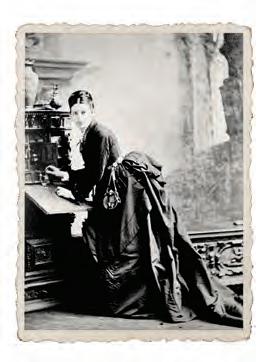 BY JOHN H. MONNETT
BY JOHN H. MONNETT
Memories of Christmases past run deep through the colorful history of Denver, among the first of the Great Plains settlements to urban ize. Englishwoman Rose Georgina Kingsley— eldest daughter of controversial Anglican priest, social reformer and writer Charles Kingsley and sister of Victorian novelist Mary St. Leger Kingsley (pseudonym Lucas Malet)—journaled one of the earliest recollections of how Denver ites celebrated yuletide.
In 1870 John Evans completed the Denver Pacific Railway, linking its namesake city to Cheyenne, Wyoming Territory, on the Union Pacific section of the transcontinental railroad. That same year William Jackson Palmer’s Kansas Pacific reached Denver. Their com pletion buoyed the flagging economy that had gripped post war Colorado Territory with the exhaustion of known placer
deposits, for the railroads made it possible to bring in industrial smelting and mining equip ment and thus exploit subterranean veins of gold and silver. Denver’s economy predict ably boomed, as did its affluent residential neighborhoods. The rails also brought wealthy Europeans fascinated by the prospect of seeing the Western frontier firsthand. Among them was Rose Kingsley.
Arriving on the Front Range of the Rocky Mountains just before Christmas 1871 to visit brother Maurice, a recent Denver transplant, Rose vividly described the sights and sounds of winter revelry. Her travels in Colorado Territory, which pre date those of her better-known countrywoman Isabella Bird by two years, brought Kingsley face to face with a territory and city on the verge of making their mark. Considering the florid writing of many Victorian-era authors, the straightforward
WILD WEST WINTER 202322 OPPOSITE TOP: LIBRARY OF CONGRESS; BELOW: THE KINGSLEY SCHOOL; THIS PAGE: NORTH WIND PICTURE ARCHIVES/ALAMY STOCK PHOTO
PIONEERS & SETTLERS
“The streets are full of sleighs, each horse with its collar of bells,” wrote Rose Georgina Kingsley of yuletide Denver, where she arrived just before Christmas 1871 to visit her brother.
Rose Kingsley
WIWP-WINTER 2023-PIONEERS & SETTLERS.indd 22 9/30/22 9:33 AM
prose of Rose’s journal is refreshing. Consider the following description of her enchantment with the holiday activity around her:
Denver looks wintry enough under 6 inches to a foot of snow; but it is full of life and bustle. The toy shops are gay with preparations for Christmas trees; the candy stores filled with the most attractive sweetmeats; the furriers display beaver coats and mink, ermine and sable, to tempt the cold passerby; and in the butchers’ shops hang, besides the ordinary beef and mutton, buffalo, black-tailed deer, antelope, Rocky Mountain sheep, quails, par tridges and prairie chicken.
Strolling uptown from the commercial center along Blake Street, Kingsley entered Denver’s growing residential section along 14th Street past Larimer. “The streets are full of sleighs, each horse with its collar of bells,” she wrote, “and all the little boys have manufactured or bought little sleds, which they tie to the back of any passing cart or carriage and get whisked along the streets till some sharp turn or unusual roughness in the road up sets them.” The well-bred Englishwoman was particularly enamored with the unconstraint of Denver society. “In the frank, unconventional state of society which exists in the West, friendships are made much more easily than even in the Eastern states or, still more, in our English society.”
No Victorian Christmas Eve would be complete without a two-horse open sleigh ride. As the mer cury had dipped to 2 degrees below zero, Rose and Maurice bundled up beneath wool blankets, buffalo robes and plush sable furs. Leaving the city behind, the sleigh skimmed across the open prai rie beneath a bright moon, the horses fairly flying over the smooth, sparkling snow with silver bells jingling in the frosty air. When the siblings ar rived home around 11 p.m., Rose recalled, Maurice “looked just like Santa Claus, with his moustache and hair all snowy white from his frozen breath.”
Christmas Day dawned sunny and warm, leav ing Rose and Maurice to pick their way through rivers of melting snow to the Masonic Hall, tem porary home of the year-old Trinity Episcopal Church. Until their church building was com pleted several years later, British-born Anglican Denverites attended services at the hall, which on the outside reminded the English pastor’s daughter of a country squire’s coach house. Its interior had been tastefully decorated with fresh, fragrant evergreens from the mountains.
Following services Rose accepted an invitation to Christmas dinner at a fashionable home in
Denver was a busy place in the 1870s, as depicted in this hand-colored woodcut reproduction of a 19th-century illustration. There on Christmas Day 1871 Kingsley dined on turkey and mince pie, sang traditional carols and played such games as snap-dragon, in which players snatched up brandy-soaked flaming raisins.

which another friend boarded. After dinner of “the orthodox turkey and mince pie,” guests were summoned to the spacious parlor, where they gathered around a fresh spruce draped with strings of raw cranberries and popcorn. Once the host had distributed presents to his household servants, he and his guests passed the evening singing traditional carols and playing such games as blind man’s bluff and charades. Best of all was snap-dragon, the most popular of Victorian yuletide parlor games. Once the lights were dimmed, a shallow bowl filled with brandy-soaked raisins was set on the floor, and the liquor ignited. At a signal players took to snatching up flaming raisins from the bowl and popping them into their mouths. The idea was to close one’s mouth over a burning currant and extinguish the flame. One tradition held that the person who snatched up the most raisins would meet their true love within a year. Alas, Rose never married.
To end the near perfect evening, the master of the house gallantly began the first verse of “God Save the Queen.” Abashedly unfamiliar with the lyrics, he soon relinquished center stage to Rose. “It sent a thrill over me,” she wrote, “hearing it a thousand miles west of the Mississippi for the first time since leaving England. And then I was made to sing it all through; for, though the tune is familiar enough in America, no one present knew the right words.”
In 1874 Kingsley published her recollections of that memorable Denver Christmas in South by West: Or Winter in the Rocky Mountains and Spring in Mexico , edited by none other than father Charles, the Rev. Kingsley. Soon overshadowed by Bird’s 1879 masterpiece A Lady’s Life in the Rocky Mountains, which many credit for the genesis of Colorado tourism, Kings ley’s book faded into obscurity, though it has since been reprinted. Follow ing statehood, of course, Colorado’s immigrant population multiplied, and present-day Denverites celebrate Christmas traditions from many lands, including merry old England.
WILD WEST WINTER 2023 23 OPPOSITE TOP: LIBRARY OF CONGRESS; BELOW: THE KINGSLEY SCHOOL; THIS PAGE: NORTH WIND PICTURE ARCHIVES/ALAMY STOCK PHOTO
WIWP-WINTER 2023-PIONEERS & SETTLERS.indd 23 9/30/22 9:34 AM
The Widow Who Would Be Cattle Queen
AFTER HER HUSBAND’S UNTIMELY DEATH, YETTA KOHN JOINED FORCES WITH HER SONS AND DAUGHTER TO TAKE CARE OF BUSINESS IN NEW MEXICO TERRITORY
BY JIM WINNERMAN
In a discussion of life on the Western frontier relatively few women pop to mind. Even the well-known phrase “Go West, young man,” popularized by newspaper editor Horace Greeley, omits women from the story of west ward expansion. Certainly, women were there, often toiling away anonymously to raise families and crops in harsh envi rons. Yet few remain household names. Exceptions include hard-drinking, tough-talking Calamity Jane and, to a lesser extent, hard-drinking, quick-shooting Stagecoach Mary. One genuinely ladylike Western pioneer who has largely escaped notice is Yetta Kohn, who for decades in the late 1800s and early 1900s was a dynamic force on the plains of New Mexico (which became a state in 1912). A successful businesswoman, rancher and devoted mother, Kohn’s story has all the fabric of what constitutes an American legend.
A Jewish immigrant from Bavaria (born Yetta Louise Gold smith on March 9, 1843), she found success both as a young wife and mother and as a widow, and she did so without a formal education or parental guidance. Yetta’s very American story began in 1853, when the 10-year-old disembarked in New York from the steamer William Tell in the company of older family members, possibly siblings. They eventually made their way west, as Yetta’s name appears beneath theirs in the 1860
census as a 17-year-old resident of Leavenworth, Kansas Terri tory (admitted to the Union months later as the 34th state).
That year she married fellow countryman and Jewish immi grant Samuel Kohn, and the couple journeyed west in a covered wagon to start a new life together in gold rush–era Denver’s Cherry Creek neighborhood. There she gave birth to sons Howard and George, who as adults would become instrumental in Yetta’s later success. By 1865 the family of four had returned to Leavenworth, likely due to a flood that had devastated Cherry Creek in May 1864. Over the next several years Samuel entered the wool-and-hide business, and Yetta delivered three more children. Two died in infancy, while daughter Belle survived.
In 1869, soon after Belle’s birth, the growing family returned west, following the Santa Fe Trail to Las Vegas, New Mexico Territory, some 40 miles east of Santa Fe. There Samuel opened a wool-and-hide store on the town plaza, supplying the gar ments necessary for life on the frontier. In the 1870 federal census Yetta, a seamstress, is the only woman in town who listed an occupation other than homemaker. A year later she gave birth to son Charles.
On Sept. 29, 1878, Samuel died at age 40. The cause was un recorded. He left Yetta with four children, ages 7, 9, 15 and 17. Together with eldest son Howard, Yetta kept the wool-and-

WILD WEST WINTER 202324 NEW MEXICO JEWISH HISTORICAL SOCIETY
WESTERN ENTERPRISE
DENVER PUBLIC LIBRARY WIWP-WINTER 2023-WESTERN ENTERPRISE.indd 24 9/30/22 9:35 AM
Opposite: The family wool-and-hide store in Las Vegas, New Mexico Territory, fell to Yetta to manage after her husband, Samuel Kohn, died in 1878. Right: The Kohn matriarch poses front and center with family members: (standing from left) son Howard, daughter Belle and son George; (seated from left) son Charles, Yetta, Stanley (Belle’s son) and Albert Calish (Belle’s husband).

hide store viable through 1882. She then moved the clan to a homestead in the since vanished com munity of La Cinta, 60 miles to the east-southeast. Applying the lessons she’d learned running the family business in Las Vegas, Yetta soon opened a grocery store, became the postmistress and began purchasing more land on which to graze cattle. By 1887 she had formed a partnership with two local investors and her three grown children (How ard, George and Belle) and was running 4,000 head of cattle on open range in San Miguel County. She also helped establish a social club and once helmed a flatboat across the Canadian River to get club members to an outing.
Inevitably, the maturing Kohn children scat tered. In 1885 Belle and Charles left for school in Kansas and New Jersey, respectively, soon fol lowed by college-bound Howard and George. In 1888 the family sold their stock to rancher Wilson Waddingham. Through the turn of the century Yetta continued to buy and sell land in Las Vegas and Kansas while bouncing between Las Vegas and addresses in Wichita and New York.
In 1900 Yetta and George rendezvoused back in Las Vegas, where Charles soon joined them to start a general store. By 1902 Howard had united with his mother and brothers in time to make a final move south to the rail stop of Rountree, New Mexico Territory (20 miles west of Tucumcari), where they purchased a mercantile business from town namesake Henry Rountree and acquired more land through the homestead acts.
That year a lingering drought ended, the town was reborn as Montoya, and Yetta and her three sons not only kept the mercantile store running, but also opened a land company, a bank and a ranch. The businesses owned by mother and sons were known as Kohn Bros., while the ranching component was called Yetta Kohn & Co. By 1904 the family was again intact, as Belle, husband and son joined her mother and brothers in Montoya and started their own ranching operation. For a dozen years good business decisions and astute land purchases allowed the family to flourish.
Then double tragedy struck. On Jan. 30, 1916, just four days after his marriage to 24-year-old Hannah Bonem, Charles died at age 44 in Kansas City, the first stop on the couple’s honeymoon, from an infection in an abscessed tooth. Three days later, a grief-stricken George collapsed and
died of heart failure. He was 53. A front-page profile in the Feb. 3, 1916, Tucumcari News and Tucumcari Times paid tribute to the brothers and, by inference, to how well Etta had done as a widow and single mother:
The esteem in which these brothers were held is best attested by the deep sympathy universally expressed by the community. Every business house was closed by common consent…and remained closed while the bodies awaited the last sorrowful rites.…
No more beautiful tribute could be paid to the life and memory of these brothers than was manifested in the sorrow of the native people with whom their business had largely been transpired and who came in num bers…to unite their sorrows in one common grief.
Upright, congenial and generous, Charley and George Kohn endeared themselves to all worthy persons with whom they were acquainted.
Scarcely a year later, on April 24, 1917, Yetta—or “Mother Kohn,” as she was affectionately known in Montoya—died at age 74. Family oral history records that her passing had been “hurried along” by the circumstances of her sons’ deaths. The April 27 Santa Fe New Mexican was especially generous in its praise of the late matriarch:
She had an especial faculty for comforting the unsuccessful without injuring their pride, and hundreds of needy will miss her ever-ready response to their appeals.
The home life was her greatest pleasure and ideal, and legions have been made happy through an [sic] hospitality which has become pro verbial. A real type of womanhood has departed, but her good influence will live always.
After the deaths of Charles, George and Yetta, Howard Kohn took over the family businesses and followed his mother’s habit of purchasing land around Montoya. In 1923 he married his bookkeeper, Clara McGowan, and they named their only child, daughter Yetta, in honor of her grandmother. When Howard died in 1933 from the effects of smoke inhalation after battling a blaze at the Kohn ranch, Clara took over operations. Like her mother-in-law, she proved a sharp yet ladylike businesswoman. In 1946 Clara’s ranching enterprise, by then known as the T4 Cattle Co., purchased 117,000 acres in the Mesa Rica section of the historic Bell Ranch, which abutted the Kohn property. After the sale T4 land totaled 180,000 contiguous acres. Succeeding generations continued to acquire land, and today the 220,000-acre T4 is one of the largest private ranches in the country.
WILD WEST WINTER 2023 25 NEW MEXICO JEWISH HISTORICAL SOCIETY
DENVER PUBLIC LIBRARY
WIWP-WINTER 2023-WESTERN ENTERPRISE.indd 25 9/30/22 9:35 AM
A Legacy ofHistorical Realism
Artist Jerry C. Crandall, 87, died of COVID-19 on June 12, 2022, at home in western Montana, leaving behind widow Judy, two sons and a daugh ter from a previous marriage, as well as a cat (Billy the Kiddy) and a dog (Bridger James). He also leaves a 60-year legacy of historically accurate artwork, much of which deals with the American West.


Judy Crandall recalls her husband’s atten tion to historical detail: “Jerry often said, ‘I want to accurately document a historical scene, to tell a story. It is OK for someone to criticize my art, but not my research.’” If the artist wanted to paint a charging cavalry soldier, for
example, he first learned to ride in period gear like that trooper. In researching mountain men, he made and wore the clothes, fired the weapons, felt the cold. That painstaking ap proach also made him a natural as historical consultant for the TV miniseries Centennial (1978–79) and the big-screen films The Moun tain Men (1980) and Tombstone (1993).
Crandall was born on April 1, 1935, in La Junta, Colo., near the site of Bent’s Fort on the Santa Fe Trail. His father loved history and art and en couraged Jerry to pursue both. Hired as an aviation artist by McDonnell Douglas Aircraft Co., in Long Beach, Calif., young Crandall worked on his own paintings in the evenings and
WILD WEST WINTER 202326 IMAGES COURTESY JUDY CRANDALL (6)
COVID MAY HAVE CLAIMED MONTANA ARTIST JERRY CRANDALL, BUT HIS HISTORICALLY ACCURATE WORKS RIDE ON BY JOHNNY D. BOGGS
Jerry Crandall, who died of COVID-19 last June, painted the oil Racing the Iron Horse in 2015. He based this work on an actual 1866 event in which Brulé Lakota Chief Spotted Tail rode in the cab with the train’s engineer while mounted braves raced the locomotive.
ART
OF THE WEST
Jerry C. Crandall
WIWP-WINTER 2023-ART OF THE WEST.indd 26 9/30/22 9:37 AM
on weekends. At one point a friend who bro kered Western art took some of Jerry’s works to Fenn Galleries, in Santa Fe, and “came back with a very large check,” Judy says. “Sold them all.” Thus encouraged, in the summer of 1973 Crandall began painting full-time. His first show, with a fellow artist at Beverly Hills’ Petersen Galleries in April 1974, was a sellout. Jerry and Judy married on July 4, 1976, soon after the artist had rendered a portrait of Lt. Col. George Armstrong to mark the centennial of the Battle of the Little Bighorn. In 1982 the Crandalls moved to Sedona, Ariz., where
Judy set to work promoting and advertising her husband’s work. In 1996 they moved to Montana.
Crandall’s favorite subjects were American Indians and mountain men. “He loved their in dependent spirit, quest for exploration and col orful way of life,” Judy says. “These were tough people who Jerry wanted to correctly capture through historically correct paintings. Collec tors eagerly sought out his work celebrating our unique Western history.”


Some of those paintings took months to com plete. Others took years.
“An idea would jell after reading a journal, diary or other firsthand account of an event—and this process was complicated as well as time-con suming, as he wanted the painting to satisfy his objective,” Judy says. “Having the right model, re-creating the correct clothing and other neces sary items were critical to the success of his work.
Clockwise from top left: Son of the Wolf (2016) depicts a half Kootenai, half Blackfeet warrior holding a vicious-looking war club; in After the Raid (2015) a Southern Cheyenne warrior has captured a bugler’s shell jacket and horn and is attempting to duplicate a cavalry call, to the discomfort of a fellow warrior; in His Sister’s Toy Horse (2015) the Mountain Crow warrior Walk in the Clouds rides in a triumphant parade with his girlfriend seated behind him while his sister follows on foot, showing off the toy horse she made to honor him; in Pawnee (2016) a warrior carries a trade musket and wears a Thomas Jefferson peace medal.
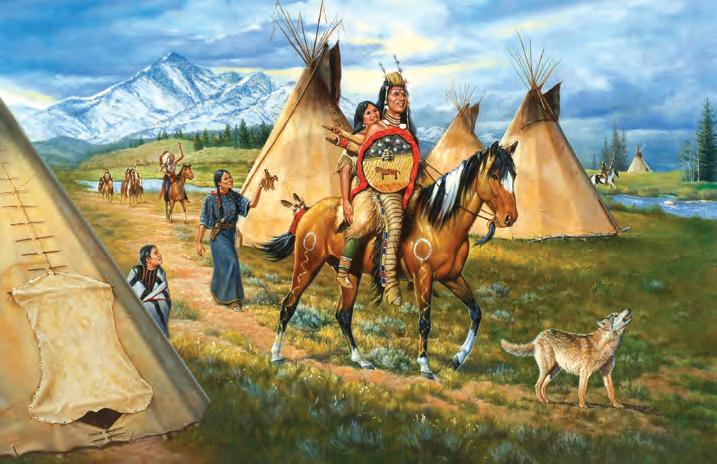
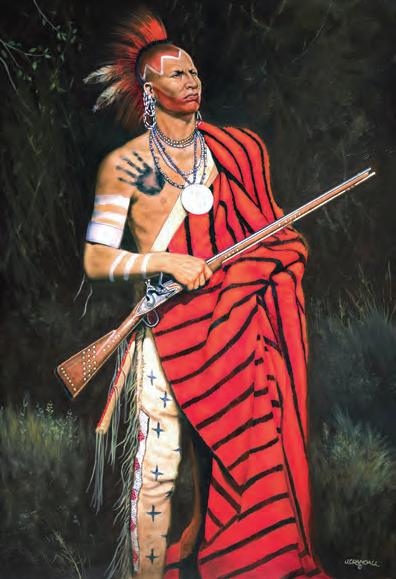
WILD WEST WINTER 2023 27 IMAGES COURTESY JUDY CRANDALL (6)
WIWP-WINTER 2023-ART OF THE WEST.indd 27 9/30/22 9:38 AM
Clockwise from top left: In Crazy Horse’s Magic Dust (2017) the great Lakota warrior makes final preparations before going into battle; in Bent’s Fort Beauty (2018) a young lady wearing beads proudly awaits her hunter husband’s return to the frontier fort; in Grandfather’s Shield, (2013) a man paints his hide shield while a boy and a dog intently watch; in Chief Iron Shirt at Fort McKenzie (2018), based on a real August 1833 incident, a Blackfeet chief enjoys the items he received in trade with the Hudson’s Bay Co.
“He was always reading and researching some thing. He would make small sketches of images that grew in his mind based on his reading ma terial. Once the painting was sketched out, he would paint every day until it was completed. He preferred to do one thing at a time, so once he decided on which project he wanted to tackle, he would go full force on it.”
Crandall also painted World War II scenes fea turing pilots and planes of Germany’s Luftwaffe How does Judy think her husband would want to be remembered?
“That he was a student of history, the Ameri can West and World War II,” she says. “He wrote eight books on the Luftwaffe aircraft and men who flew these machines. Some have titled him an
expert, and Jerry always corrected them, saying, ‘No, we are all students.’
“That he loved talking about his passionate love of history and always had time to talk to anyone and everyone who had questions.
“That he wanted to aid the movie industry by serving as a technical adviser, which he did for Centennial , The Mountain Me n and some for Tombstone, in which he also did a stunt—fall ing off his horse on cue!” For such spunk Wild West salutes “Crash Crandall,” who threw him self soul, mind and, quite literally, body into his work.
For more on Jerry Crandall and his art visit eagle-editions.com and historynet.com.

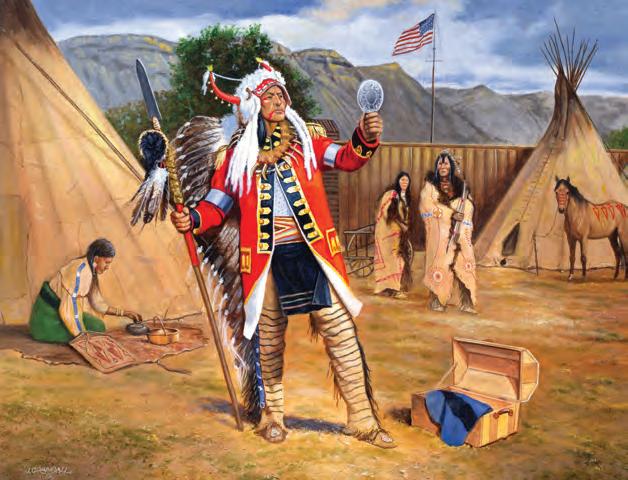


WILD WEST WINTER 202328
IMAGES COURTESY JUDY CRANDALL (4)
WIWP-WINTER 2023-ART OF THE WEST.indd 28 10/4/22 5:24 PM



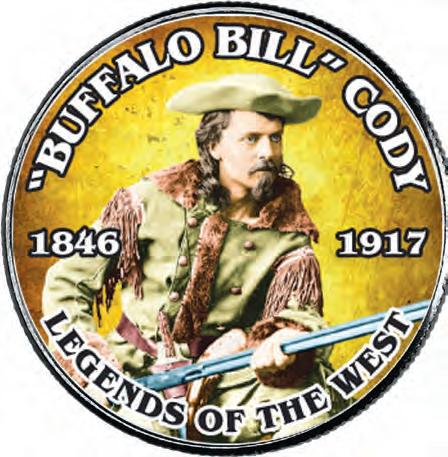



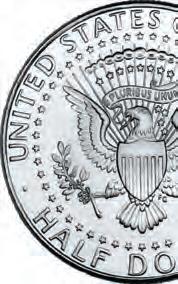






Coins capture the spirit of the Old West... Get Two Sharpshooter Half Dollars For Only $5 – You Save $14.98! Now you can own uncirculated US half dollars bringing to life two of the greatest shots in the Old West –Buffalo Bill Cody and Annie Oakley. Just $5 for both coins! Legendary Figures Who Continue to Inspire Us Today Coins have been enhanced by Mystic with vintage photos of Buffalo Bill Cody and Annie Oakley in all their glory. From their wardrobe to their firearms, these images capture the icons at the height of their careers. Display your coins on your desk or bookshelf as examples of the greatness of this period in our history. Get Your Coins Today Order your coins now for only $5 and save $14.98. Shipping and guaranteed delivery are FREE! You’ll also receive special collector’s information and other Legends of the West coins with no obligation to buy. Limit of five orders at this low price. Legends of the West Coins ❏ Yes! Send me the Legends of the West coins for only $5. Shipping and guaranteed delivery are FREE. Your satisfaction is guaranteed. Limit of 5. Quick order at MysticAd.com/AZ119 Name ____________________________________________ Address __________________________________________ City/State/Zip _____________________________________ ❏ Check or money order ❏ Visa ❏ MasterCard ❏ AmExpress ❏ Discover Exp. Date ___/___ Please send payment to: Mystic, Dept. AZ119, 9700 Mill St., Camden, NY 13316-9111 NY State residents add sales tax. ✔ WIWP-221108-008 Mystic Stamp Stamps CLIPPABLE.indd 1 9/30/22 11:20 PM
Mission Impossiblein California
IN THE 1830S MEXICO DECREED LANDS ONCE OWNED BY THE CATHOLIC CHURCH AVAILABLE FOR PRIVATE OWNERSHIP— BUT FEW MISSION INDIANS BENEFITED
BY RAMON VASCONCELLOS
In his reminiscences, written in Rome in the 1830s, Pablo Tac, a former Luiseño Indian and devoted Catholic, expressed his affection for the bygone mission life of Spanish Alta California. At Mission San Luis Rey de Francia, Tac’s former home, Indians partook in such reli gious aspects of daily life as the choir, enjoyed the protection of soldiers (“so that nobody does injury to Spaniard or to Indian”) and were cared for by Franciscan fathers who “[know] the customs of the neophytes well.” In a letter to Alta Cali fornia Governor José Figueroa written around the same time, Narciso Durán, father-president of the missions, contrasted the “far more wretched and oppressed” existence of Indians living outside their walls. “All in reality,” he wrote, “are slaves, or servants, of white men.”
Overlooking such advocacy of the mission system, Mexican government officials moved to secularize (i.e., nationalize) all California missions in the 1830s, transferring the lands once owned by the Franciscan order of the Catholic Church

to the state. Under the Secularization Act of 1833 and a sub sequent gubernatorial order, the former mission lands were confiscated and then made available for private ownership, ostensibly enabling Indians to purchase property. However, the stark reality for most “emancipated” Mission Indians was a slide into destitution. Dispossessed of their mission holdings, few became private landowners.
When founded in the late 17th century, the missions formed part of a tripartite settlement arrangement in Spanish Califor nia comprising presidios (military outposts) pueblos (adjacent villages) and misións (centers of religious worship and in struction usually within proximity of the former two). Mission de Nuestra Señora de Loreto Conchó (aka Mission Loreto), founded in 1697 by Jesuit priest Juan María de Salvatierra, was the first successful mission of 20 the Jesuit order established in Baja (Lower) California. In 1767 distrust of the wealthy and powerful Jesuits by King Charles III prompted him to expel them from Spain and its colonies, particularly from distant Cal
WILD WEST WINTER 202330 LEBRECHT MUSIC & ARTS/ALAMY STOCK PHOTO
INDIAN LIFE
Mission San Diego de Alcalá, founded in 1769 by Father Junípero Serra, was the first of 21 Franciscan missions established in Alta (Upper) California. Mexico secularized them all in 1833.
STOCK MONTAGE/GETTY IMAGES WIWP-WINTER 2023-INDIAN LIFE.indd 30 9/30/22 9:49 AM
ifornia. He turned over the 14 operating missions in Baja California to the Fran ciscan order, which ultimately estab lished 21 new ones in Alta (Upper) Cali fornia. Father Junípero Serra founded the first of the latter in San Diego in 1769.
Incentivized to live on mission settle ments by the protection afforded from marauders and the prevalence of food, local Indians became a captive audience of potential neophytes (converts). The Franciscans adopted the practices of reducción and congregación in their ad ministration of the missions, instilling in their wards Western culture and val ues in hopes of “reducing” Indians from their comparatively undisciplined ways, while “congregating” them together for the purpose of instruction. Baptized neo phytes were expected to adopt the wor ship practices, marital customs and other be haviors promoted by the Franciscans. Those yet to be converted were referred to as gentiles.
Though Indians were not compelled to reside at the mission, once one had converted and adopted it as home, he had to remain a resident for 10 years, after which time the land he’d farmed would re vert to his ownership. Rarely could neophytes or gentiles come and go as they pleased. To enforce the rules and maintain discipline the Franciscans sometimes resorted to draconian measures. In 1831 Frederick William Beechey, an English ship’s captain, recalled having witnessed reprisals against runaway Indians. “Armed force is sent in pursuit,” he wrote, “and drags him back to punishment apportioned to the degree of aggravation attached to his crime.” Beechey questioned the Francis cans’ commitment to Indian autonomy. “Having served 10 years in the mission, an Indian may claim his liberty.…A piece of ground is then allotted for his support, but he is never wholly free from the establishment, as part of his earnings must still be given to them [the Franciscans].” Disaffected Indians sometimes staged revolts, including up risings at Mission San Diego in 1775 and Mission Santa Inés, in central California, in 1824. In theory, under both Spanish and Mexican rule, each mission was to operate only 10 years. The expectation was that the Franciscans would have converted and instructed an ample Indian populace within that time, after which the mis sion lands were to be distributed among them. Nonenforcement of that decree in California in part prompted secularization. Justly concerned the entire scheme was a pretext to diminish the influence of the Catholic Church, one Franciscan
challenged Mexican officials to step up. “Let the latter begin to work, to found establishments and schools, and to practice arts and industries,” he wrote. “Then will be time to lead the Indians to follow a good example.” The process called for the missions to become pueblos, allowing for Indian landownership. Yet only one, Mission San Juan Capistrano, did so. All others trans ferred to ranchos owned by wealthy Californios (descendants of Spanish colonists). By one esti mate the ranchos swallowed up some 90 percent of former mission lands.
A few Indians received sizable allotments. In 1838 Governor Juan Bautista Alvarado granted Ignacio Pastor of Mission San Antonio de Padua a whopping 43,000 acres. Widow Cristina Salgado, who’d been emancipated with her husband from Mission Carmel prior to secularization, gained title to 3,200 acres near the Salinas River, making her perhaps the only female Indian awarded a grant. However, most Indians—notably the Chu mash of Mission Santa Barbara—received little more than small plots on which to raise vegetables. Adding insult to injury, the government officials who administered secularization, like commis sioner José Antonio Romero of San Carlos, chal lenged the very right of Indians to own land.
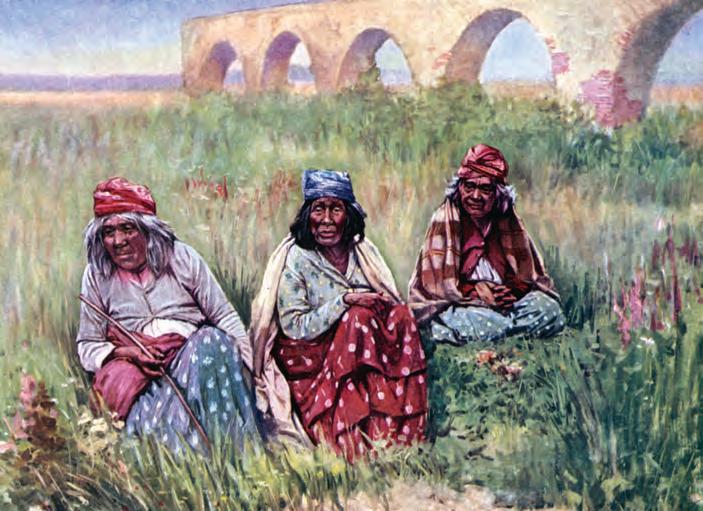
In the wake of the 1848 signing of the Treaty of Guadalupe Hidalgo, which ended the Mexican War and ceded California to the United States, land disputes between Californios and the federal government routinely bypassed any concerns about Indian landownership in the new territory. By then, in an echo of Father Durán’s observation of non–Mission Indians decades earlier, most Cal ifornia Indians lived in a state of destitution.
Elderly Indian women of Mission San Luis Rey de Francia, founded in 1798, rest on its grounds. Before the Secularization Act of 1833 Mission Indians enjoyed the protection of Spanish soldiers and the care of Franciscan fathers.
Baptized neophytes were expected to adopt the worship practices, marital customs and other behaviors promoted by the Franciscans
WILD WEST WINTER 2023 31 LEBRECHT MUSIC & ARTS/ALAMY STOCK PHOTO
STOCK MONTAGE/GETTY IMAGES WIWP-WINTER 2023-INDIAN LIFE.indd 31 9/30/22 9:49 AM
How DeadlyWas Kid Curry?
UNDER THAT ALIAS OUTLAW HARVEY LOGAN GAINED INFAMY, BUT WHETHER HE WAS THE ‘DEADLIEST’ MEMBER OF THE WILD BUNCH IS DEBATABLE
BY MARK T. SMOKOV W
ild Bunch gang leader Butch Cassidy (real name Robert LeRoy Parker) and cohort the Sundance Kid (Harry Alonzo Longabaugh) are known for having robbed trains and committed various other crimes without killing anyone. Not so Wild Bunch member Kid Curry, born Harvey A. Logan in Iowa in 1867. In my 2012 book He Rode With Butch and Sundance: The Story of Harvey “Kid Curry” Logan I note that Curry has generally been credited with eight or nine killings, some sources stating the figure as high as 40. But such figures are unreliable. “The only killing that can definitely be attributed to Curry, arguably in self-defense, was the result of his saloon brawl with miner ‘Pike’ Landusky in Montana,” I wrote back then. “Still there are modern writers who persist in placing him at the scene of nearly every suspected Wild Bunch killing, even when it can be shown that time, distance and other circumstances make this highly unlikely if not impossible.”
In retrospect, that doesn’t preclude the possibility Curry killed more than once. Two contemporary sources suggest a realistic toll, while the available evidence offers up the most likely candidates for consideration as Curry victims.
The first assertion comes from one of Curry’s avowed enemies—Robert A. Pinkerton, who operated out of the New York office of his father’s Pinkerton National Detective Agency. Pinkerton appeared to ignore the apocrypha about Curry when wiring the chief of police in Knoxville, Tenn., after the Kid’s capture east of town on Dec. 15, 1901: “Send you and all con cerned hearty congratulations on im portant arrest made. Logan is one of the worst criminals in the West. He is a leader of train and bank robbers, and as such has no equal. He has committed three murders and is an expert jail breaker. Suggest that you put guard on him day and night.”
The second source of Curry’s possible kill count is the outlaw himself. The Kid spent much of the week before his capture drinking and shooting pool in the Knoxville bars. A local paper reported that he regularly flashed a roll of $20 bills and a couple of revolvers. When full of liquor he boasted to fellow patrons he was “something of a man himself” and claimed to have made three men “bite the dust.” One might assume Curry, when drunk and bragging, would have been inclined to claim a more impres sive figure. But as he stated a more credible toll of three, a number that happens to agree with that quoted by Pinkerton,

WILD WEST WINTER 202332
WORLD HISTORY ARCHIVE/ALAMY STOCK PHOTO; OPPOSITE PAGE: DEADWOOD HISTORY INC., COLORIZED BY HISTORYNET
Robert A. Pinkerton
WIWP-WINTER-2023-KID CURRY.indd 32 9/30/22 9:50 AM
 Kid Curry in Custody
The man born Harvey Logan in 1867 posed slouched in a chair for this photo on Oct. 1, 1897, while being held in the Deadwood, S.D., jail. He’d been arrested for having helped rob the Butte County Bank in Belle Fourche, S.D., on June 28, 1897.
Kid Curry in Custody
The man born Harvey Logan in 1867 posed slouched in a chair for this photo on Oct. 1, 1897, while being held in the Deadwood, S.D., jail. He’d been arrested for having helped rob the Butte County Bank in Belle Fourche, S.D., on June 28, 1897.
WORLD HISTORY ARCHIVE/ALAMY STOCK PHOTO; OPPOSITE PAGE: DEADWOOD HISTORY INC., COLORIZED BY HISTORYNET WIWP-WINTER-2023-KID CURRY.indd 33 9/30/22 9:50 AM
it stands to reason the Kid was telling the truth, or something very close to it. In their 1954 Pictorial History of the Wild West authors James D. Horan and Paul Sann provide a Pinkertonlike chronological list of killings most com monly attributed to Curry. Rife with misspelled names and incorrect dates, it tallies nine such victims, though the authors credit no official agency or any other source for that matter. The list, with corrections in brackets, follows:
1. [Powell] “Pike” Landusky, Landusky, Mont.—Dec. 25 [27], 1894
2. Sheriff Hagen [Josiah Hazen], Conners [Converse] County, Wyo.— June 5, 1899
3 & 4. Norman brothers [actually two unrelated Mormon men, Andrew Augustus “Gus” Gibbons and Frank LeSueur, St. Johns, Ariz.]—June [March 27] 1900
5. Sheriff Scarborragh [former Deputy U.S. Marshal George Scarborough], Apache County, Ariz. [Deming, N.M.]—July 1901 [April 5, 1900]
6 & 7. Sheriff John [Jesse M.] Tyler, Moab [Grand] County, Utah, and deputy [posse member] Sam Jenkins—May 16 [26], 1900
8. Oliver Thornton, Painted [Paint] Rock, Texas—March 27, 1901
9. James [“Jim”] Winters, Montana— July 26 [25], 1901
Victim No. 1
Curry definitely killed a Montana man in a Dec. 27, 1894, saloon brawl, an event captured in Olaf Carl Seltzer’s oil painting Kid Curry Killing Pike Landusky in Jew Jake’s Saloon, Landusky, Montana. Left: Powell “Pike” Landusky was buried on his ranch outside the eponymous town of Landusky, now a tiny unincorporated community in Phillips County.
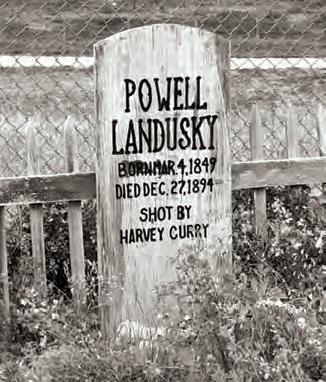
A similar list compiled by Pinkerton agent Lowell Spence records seven murder victims, minus George Scarborough and Oliver Thorn ton. Spence submitted his list for the agency records along with a document titled “Logan’s Log,” in which the Pinkerton agent describes having diligently tracked Curry’s activities from June 2, 1899, to Dec. 15, 1901. Logan’s Log does not list five killings attributed to a gang of five that rampaged through Arizona Territory and Utah in spring 1900. It mentions only three vic tims: Thornton, Josiah Hazen and Jim Winters. Spence apparently wasn’t certain who killed Thornton; he notes only that George and Ed Kilpatrick were indicted for the crime, though “Logan [was] in it too.”

WILD WEST WINTER 202334 TOP: GILCREASE MUSEUM; LEFT: MONTANA HISTORICAL SOCIETY TOP: MIKE BELL COLLECTION; RIGHT: NEWSPAPERS.COM
WIWP-WINTER-2023-KID CURRY.indd 34 10/4/22 5:25 PM
Who Shot the Sheriff?
Josiah Hazen, sheriff of Converse County, Wyo., was likely one of Curry’s victims. The sheriff was ambushed on June 5, 1899, while trailing three men suspected of having robbed a Union Pacific train three days earlier at Wilcox, Wyo.


Does the omission of five killings in Logan’s Log mean Spence be lieved Curry had no hand in those murders? Furthermore, did the Pinkerton man intend to attribute the seven killings on his overall list to Curry alone or to the Wild Bunch in general? While the seven included Landusky, the latter’s name is ab sent from Logan’s Log. It’s possible Spence considered Curry’s first killing a matter of record not requiring further documentation. After all, the testimony of witnesses at a coroner’s inquest into the Landusky murder is irrefutable.
To sum up, Pinkerton agent Spence’s nominees for the Kid’s kill count include at least Landusky, Hazen and Winters. Note, however, that none of the above referenced documents lists another killing often attributed to Curry—that of Deputy Sheriff William “Billy” Deane, of Johnson County, Wyo., in 1897.
Some writers assert that by early 1899 Curry had accompanied Cassidy and gang member William Elsworth “Elzy” Lay to southwestern New Mexico Territory and there, under the alias Tom Capehart, hired on at the WS Ranch near Alma. This bit of mythology may have been started by New Mexico cowhand, detective and ranger Charles A. Siringo. “‘Kid Curry’ knew every foot of this whole country, as he had been a cowboy along the line of New Mexico and Arizona under the name of Tom Capehart,” Siringo asserts in his 1919 autobiography, A Lone Star Cowboy. “Several years previous Cape hart had shot and killed Geo. Scarborough.” Subsequent Wild Bunch/Curry biographers, including Horan, Charles Kelly and Brown Waller, repeated Siringo’s assertion, adding their own surmises.
As Capehart was among the prime suspects in the gang of five (which included Wild Bunch members Will Carver and Ben Kilpatrick) be lieved to have murdered Gus Gibbons, Frank Le Sueur and Scarborough in Arizona Territory and Jesse Tyler and Sam Jenkins in Utah, Curry was thus tied to those killings under that pre sumed alias. The only problem with that errone ous assumption is that the real Tom Capehart, a Texas cowhand, was working at the WS Ranch at the time Curry was said to have hired on. It would have been ludicrous for the Kid to have assumed as an alias the name of someone with whom he was reportedly working.
In fact, no known sources place Curry in the Southwest at the time of the five known murders attributed to the gang of five. Allowing for Landusky as one of the Kid’s victims, that leaves four men to consider as possibly having met death from Curry’s guns—Deane, Hazen, Thornton and Winters.
Deputy Sheriff Billy Deane was shot down on April 13, 1897, some two years and four months after the death of Landusky. Johnson County Sheriff Al Sproul had hired Deane specifically to arrest cattle thieves. Although he was considered a cool and determined man, Deane’s decision to ride out alone to capture or kill fugitive outlaws was pure foolishness. He set out south from Buf falo and on the morning of April 13 confronted two members of a gang of rustlers at the Griggs’ family-run post office. The gang, apparently intent on getting its mail, was thought to have included “Flatnose” George Currie and the two “Roberts boys” (aliases then used by Curry and the Sundance Kid). Deane pushed hard for a gunfight, but the rustlers rode off.
Deane went in pursuit, and a few hours later, near the Kaltenbach sheep ranch, he spotted four men he took to be the rustlers riding to ward him. Drawing to within 400 or 500 yards of them, the deputy jumped from his horse and shot at the oncoming riders. Promptly dismounting, the four returned fire. Three of their bullets found their mark, and Deane bled out within minutes. Witnesses testified that as many as seven men shot at the deputy, two having ambushed him from a draw or cutbank.
TOP: GILCREASE MUSEUM; LEFT: MONTANA HISTORICAL SOCIETY TOP: MIKE BELL COLLECTION; RIGHT: NEWSPAPERS.COM
35WILD WEST WINTER 2023 To sum up, Pinkerton agent Spence’s nominees for the Kid’s kill count include at least Landusky, Hazen and Winters WIWP-WINTER-2023-KID CURRY.indd 35 9/30/22 9:51 AM
Three Gang Members and a Girlfriend Annie Rogers, who kept company with Curry, poses with him in a Denver studio in December 1900. Above right: “Flatnose” George Currie was with Curry and the Sundance Kid in the shootout that cost Sheriff Josiah Hazen his life. Right: The Sundance Kid (real name Harry Longabaugh) posed for this 1901 studio portrait in New York before heading to South America.
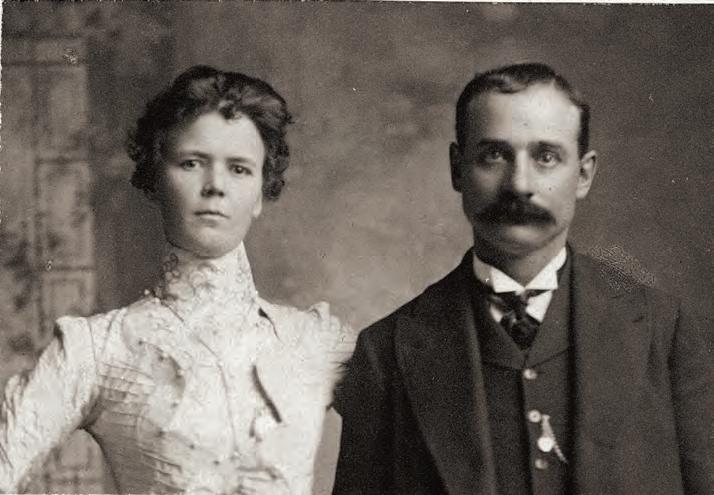
Given the evidence, or lack thereof, Deane is not a good candidate to mark down as one of Curry’s victims. Even though the prime sus pects were members of the Hole-in-the-Wall Gang (see sidebar, P. 47), they were never offi cially identified, and authorities made no ar rests in the killing. The April 22 Buffalo Bulletin reported that the jury at a subsequent coroner’s inquest found “the deceased came to his death from a gunshot by parties unknown.” With four to seven men shooting at a range of 400 to 500 yards, it would be next to impossible to identify Curry, let alone single him out as the responsible gunman.
Little more than two years later, on June 5, 1899, Converse County, Wyo., Sheriff Josiah Hazen was ambushed while trailing three men suspected of the Union Pacific train robbery at Wilcox three days earlier. The posse tracked the fugitives—George Currie, Kid Curry and the Sundance Kid—to a spot along Castle Creek, roughly midway between Casper and the outlaw hangout also known as Hole-in-the-Wall. Sheriff Hazen and Dr. John F. Leeper of Casper (though some sources claim the second man was Union Pacific Special Agent Frank Wheeler) dismounted and walked up a draw, searching for the tracks of the outlaws’ horses. Hazen found the trail and called to Dr. Leeper. The latter had approached to within feet of the sheriff when the outlaws suddenly opened fire from concealment.
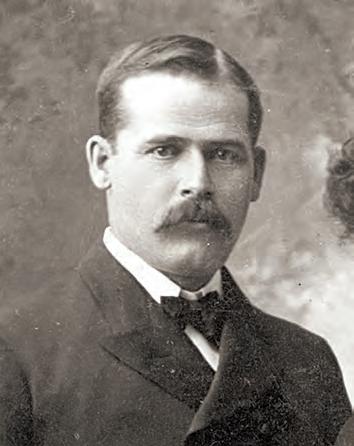

The newspapers called it a volley or succession of shots, one posse man recalling the reports of three distinct guns. “At the first shot Sher iff Hazen threw up his hands,” reported the June 8 Wyoming Derrick , “shot through the abdomen, the ball entering the right side and pass ing through.” The outlaws kept the posse pinned down for the next sev eral minutes to cover their escape north along the creek. Hazen was taken first to Casper, then to his home in Douglas, where he died early the next morning.
The June 10 Cheyenne Daily Sun-Leader stated that some mem bers of the posse had “returned a few shots…but the robbers could not be seen and, [as] they use smokeless powder, could not be separately located.” Although no one in the posse could be sure who’d shot Hazen, there’s a pos sibility the bandits themselves knew. First, the two parties had been in much closer proximity than those in the Deane con frontation. Second, this gunfight had pitted just three outlaws against two posse members. Finally, if we’re to believe the report that the first shot had been distinct from the volley or succession of three, the bandits may have known who among them fired the fatal bullet. Hazen certainly could have been one of the men Curry claimed to have made “bite the dust.”
Trying to identify the person who murdered Oliver Thornton is, at this late date, an exercise in futility. Wild Bunch members Curry, Carver and Ben Kilpatrick were present at the latter’s Planche Spring family farm, between Eden and Paint Rock, in Concho County, Texas, in late March 1901. They were relaxing and laying low in the wake of a fall 1900 celebration with Butch Cassidy and the Sundance Kid in Fort Worth, during which they posed for the infamous “Fort Worth Five” photo. They had designated the cow town as a rendezvous point after having split
WILD WEST WINTER 202336 CLOCKWISE FROM LEFT: LIBRARY OF CONGRESS; MIKE BELL COLLECTION; HISTORYNET ARCHIVE TOP AND BELOW: AMERICAN HERITAGE CENTER, UNIVERSITY OF WYOMING; RIGHT: ROBERT G. MCCUBBIN COLLECTION
WIWP-WINTER-2023-KID CURRY.indd 36 9/30/22 9:52 AM
forces to hold up both a Union Pacific train at Tipton, Wyo., and the First National Bank of Winnemucca, Nev.
On March 23, 1901, Butch, Sundance and the Kid’s companion, Ethel Place, arrived in Buenos Aires, Argentina, on a steamship out of New York City. On or around the same date the other three gang members, who’d been posing as dealers in polo ponies and touring west Texas in a rubber-tired buggy, arrived at the Kil patrick family farm.
On March 27, the day of the Thornton shooting, Ben’s younger brothers, George, Ed and Felix, and his sisters, Ola and Alice, were also present. An initial report of the killing appeared in the April 6 Devil’s River News, out of Sonora, Texas. “The reports which have been received in San Angelo are meager and conflicting,” the news paper equivocated, before spilling details:
Oliver Thornton, who was an employee of Ed Dozier and working on his farm, had been greatly troubled by hogs belonging to the Kilpatricks.… He went over to the Kilpatrick house to ask them to keep their hogs out. Ed Kilpatrick, George Kilpatrick and Walker were playing croquet. [Thornton, armed with a Winchester] threw down on the crowd and demanded that they keep the hogs out of Dozier’s premises. Ed Kil patrick stated that the hogs were [his brother] Boone Kilpatrick’s, and that they wanted no trouble, and that Walker then shot him.
Men of Action
Top: Possemen unload their horses in Wilcox after the June 2, 1899, train robbery.

Above: Orlando Camillo “Deaf Charley” Hanks had a hand in the Great Northern train robbery near Wagner, Mont., on July 3, 1901. Left: Three Logan brothers strike a pose circa 1890: (from left) John, Harvey (Kid Curry) and Lonie.
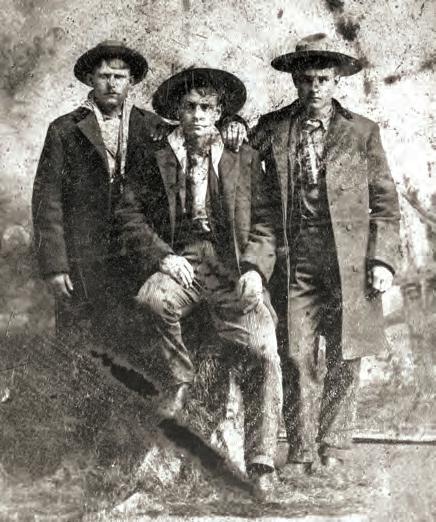
“Walker” was Charles Walker, an alias of Will Carver. Curry, also present, was using the alias Bob McDonald. While the Pinkertons knew those aliases, local authorities were unfamiliar with them, a fact the Kilpatricks exploited to initially mislead those investigating the shooting.
George Kilpatrick later identified Walker as Carver and claimed McDonald had killed Thorn

37WILD WEST WINTER 2023 CLOCKWISE FROM LEFT: LIBRARY OF CONGRESS; MIKE BELL COLLECTION; HISTORYNET ARCHIVE TOP AND BELOW: AMERICAN HERITAGE CENTER, UNIVERSITY OF WYOMING; RIGHT: ROBERT G. MCCUBBIN COLLECTION
WIWP-WINTER-2023-KID CURRY.indd 37 9/30/22 9:52 AM
The End of Winters
In the early morning of July 25, 1901, Jim Winters took two bullets to the gut after stepping out the back porch of the Montana ranch house he shared with stepbrother and partner Abe Gill. Though Kid Curry had a strong motive, authorities never charged him with the murder.
ton. However, the newspaper’s description of Walker as “a small man weighing from 135 to 140 pounds, dark complexion, heavy brown mus tache, a bald head and aged between 35 and 40 years” more closely resembled Curry than Carver. Several months later Kilpatrick’s older brother Boone (who wasn’t present at the shooting) told St. Louis detectives Carver had done the killing, though Boone deemed it justifiable homicide, insisting Will had shot Thornton as the latter was thumbing a shell into his shotgun.
“In considering our outlaws, Will Carver and Harvey Logan,” author John Eaton writes, “we have trouble in finding a motive. In a robbery or in self-defense these men would kill for the profit and preservation of their lives, but never over an argument concerning someone else’s hogs.…A killing would tell the law where they are and have it close in on them, just as this one did.” That same assumption is true of Ben Kil patrick. A news item from St. Louis published in the November 19 Billings (Mont.) Gazette re ported that Kilpatrick, while in custody, claimed to have killed Thornton to save the life of his brother (Ed or George), whom Thornton had covered with a pistol.
Texas rancher John Loomis referred to his neighbors the Kilpatrick boys as “natural born criminals” and suggested a younger outlaw (mean ing either Ed or George) had killed Thornton in a
bid to impress veteran gang member Carver. In March 1902 the younger Kilpatrick brothers were duly ar rested and tried for the Thornton murder, but both were acquitted.
Taken as a whole, the evidence suggests that no one, except Carver and the Kilpatricks, was aware of Curry’s presence in the region or even knew what he looked like. Thus, there really isn’t any concrete evi dence Curry had anything to do with Thornton’s murder.
The final man under consider ation as one of the Kid’s possible victims is Montana rancher Jim Winters. After the July 3, 1901, Great Northern train robbery near Wag ner, Mont., Curry, Ben Kilpatrick and O.C. “Deaf Charley” Hanks hid out in the Missouri Breaks until those hunting for them wearied of the pur suit. Around 6 a.m. on July 25, eight days after the posses disbanded, Winters had stepped out the back porch of his ranch house to brush his teeth when struck in the abdomen by two bullets. One slug lodged in his stomach, the other shattered his spinal column.

Among those alerted by the shots were six young Easterners staying at the ranch that summer to help with the haying. Sources differ as to whether Abe Gill, Winters’ stepbrother and partner, was also present that morning. A subsequent inquest lists the six Easterners as witnesses, one of whom reported having seen someone he didn’t recognize run up a coulee some 150 yards away in a crouched position. Warning shots from that shooter, or shooters, kept the six hands pinned down until about 8:30 a.m., when two were finally able to ride north to Harlem for a doctor.
Authorities found empty .30-40 Winchester shell casings beside an old hog pen west of the ranch house, behind which the killer (or killers) had taken up a firing position. From there two sets of footprints led to a camp site in a creekside willow thicket. On the ground were the butts of several hand-rolled cigarettes, while the shod prints of two or three horses led away from the creek. The evidence suggested two or three men had waited several hours for Winters to show himself. Authorities speculated the shooter had ridden away first, while his accomplice, or accomplices, provided covering fire. A three-man posse followed but soon lost the trail of the bushwhackers.
The next day, the 26th, the Fort Benton River Press named the Curry gang as prime sus pects. “The Curry gang and their sympathiz ers have had it in for Winters ever since the latter killed John Curry about five years ago, an occurrence which was justified by Curry
WILD WEST WINTER 202338 MARK T. SMOKOV COLLECTION ABOVE RIGHT: LIBRARY OF CONGRESS; TOP RIGHT: MARK T. SMOKOV COLLECTION
Winters had stepped out the back porch of his ranch house to brush his teeth when struck in the abdomen by two bullets
WIWP-WINTER-2023-KID CURRY.indd 38 9/30/22 9:53 AM
commencing to fire at him with a sixshooter,” the newspaper wrote. “[John] Curry claimed the Tressler Ranch, which Winters had bought, and tried to en force his claim by ordering its owner out of the country.”
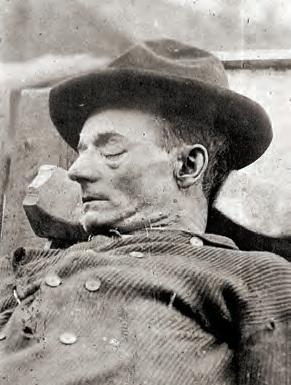
Winters had recently told Sir ingo he expected to be waylaid and killed by John’s brother, Kid Curry. But five years had passed since the Winters/John Curry gun fight, and all that time Kid Curry hadn’t shown any inclination to seek revenge. Anyway, Winters had plenty of other enemies. Resi dents of north-central Montana’s Little Rockies, for example, were not happy Gill and Winters had in vited the various barroom posses to camp on their ranch. While they supposedly scoured the country for the Great Northern bandits, posse members had cut barbed wire fences, ridden through neighbors’ grain fields and intermittently ducked into Landusky to fill up on whiskey and shoot up the town. One upset neigh bor reportedly threatened that unless Winters reimbursed him for dam aged crops, he’d “get what Johnny Curry got.”
The verdict of the inquest was Winters had been killed “by some person or persons unknown to this jury.” On September 3, after a thorough inves tigation, a Fort Benton grand jury was only able to conclude Winters had been murdered “by a fugitive from justice…one of the parties to said [Great Northern] train robbery.” While the grand jury lacked the evidence to charge Curry with murder, Winters may well have been the final victim on the Kid’s list of three men he made “bite the dust.”
In determining the identities of the alleged three (not nine) victims of Curry’s guns, with Pike Landusky as a given, the other two were most likely Josiah Hazen and Jim Winters. But without any confirmation from Robert Pinkerton or Curry himself, their identities will have to remain as speculation.

On June 7, 1904, Curry and two cohorts robbed a Denver & Rio Grande train outside Parachute, Colo. Two days later, on being cornered and wounded by a posse, the Kid fatally shot himself in the head. Questions inevitably arose over whether the dead man was in fact Curry, but Knoxville

No Cure for Curry
Left: Cornered and wounded by a posse after he and two cohorts robbed a Denver & Rio Grande train outside Parachute, Colo., Kid Curry shot himself in the head on June 9, 1904. Knoxville, Tenn., authorities confirmed the dead outlaw’s identity. Above: Logan/Curry is buried in the Pioneer Cemetery in Glenwood Springs, Colo.
authorities who had interacted with the outlaw during his 1901–02 stay in their county jail identi fied the body from photos as that of Harvey Logan, alias Kid Curry. Confirmation of the deceased’s identity came in the form of a 3-inch scar atop his head—the relic of a wound inflicted on Curry by a nightstick-wielding Knoxville policeman.
Seattle author Mark T. Smokov has long had an interest in Kid Curry and other Western outlaws. Smokov’s book He Rode With Butch and Sun dance: The Story of Harvey “Kid Curry” Logan is recommended for further reading along with Har vey Logan: Wildest of the Wild Bunch, by Donna B. Ernst, and Will Carver, Outlaw, by John Eaton.
Similar Bunch, Two Gangs
Although most historians and writers use the names Hole-in-the-Wall Gang and Wild Bunch interchange ably, they were two distinct gangs. The former included George Currie, Kid Curry and the Sundance Kid. Butch Cassidy had little to no association with this gang. The Wild Bunch formed in 1897 when members of the Hole-in-the-Wall Gang rode down to Powder Springs, a mile south of the Wyoming-Colorado line, to join Cassidy’s gang (which included Elzy Lay). Will Carver and Ben Kilpatrick eventually came up from Texas to participate in holdups. As I state in my book, there is no concrete evidence Cassidy himself ever robbed a train. —M.S.
WILD WEST WINTER 2023 39 MARK T. SMOKOV COLLECTION ABOVE RIGHT: LIBRARY OF CONGRESS; TOP RIGHT: MARK T. SMOKOV COLLECTION
WIWP-WINTER-2023-KID CURRY.indd 39 10/4/22 5:26 PM
Food on the Hoof Carl Lomen (at left) and one of his four brothers man a reindeer-drawn sled. In 1914 the enterprising Nome-based family bought a herd of 1,200 reindeer and launched the Lomen Co., a meatpacking business. Within a few years they were shipping venison to the Lower 48.
 WILD WEST WINTER
WILD WEST WINTER
202340
WIWP-WINTER-2023-REINDEER.indd 40 10/3/22 7:40 AM
‘The Deer Is Like Money’
THE REINDEER HERDING INDUSTRY IN FAR NORTHWEST ALASKA PROVED LUCRATIVE FOR A TIME, BUT ONLY FOR A VERY FEW BY MICHAEL ENGELHARD

LOMEN BROTHERS/ARCHIVES WEST WIWP-WINTER-2023-REINDEER.indd 41 10/4/22 5:27 PM
In the 1897 edition of the annual Eskimo Bulletin , between a sales ad for walrus heads and word of the discovery of an cient Eskimo armor made from iron slats, appeared the following news item:
The success attending this third year of the mission herd of domestic reindeer at the Cape [Prince of Wales] speaks well for the faithful ness and skill of our Eskimo herders, all of whom are Christians.…Each of them has driven more than 500 miles during the winter.
The author and publisher of those lines, Congregational missionary William Thomas Lopp, briefly served as superintendent of the District of Alaska reindeer station in Teller. The driving he mentioned referred to reindeer-drawn sleds whose drivers balanced on the runners in the style of dog mushers.
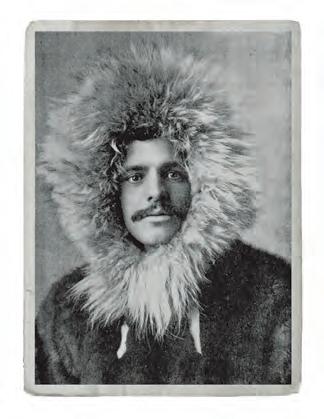
On Independence Day five years earlier, amid a flag-raising ceremony, cheering onlookers and a herd of 53 Siberian rein deer, district officials had opened Teller Station in Port Clarence Bay, a large, sheltered bight east of the Bering Strait. Those animals laid the foundation for a population of reindeer on the Seward Peninsula that would peak at 640,000 animals and support a booming industry that inexorably shaped the welfare of the region’s Alaska Natives.
By century’s end commercial hunting had depleted whale, walrus and caribou populations on the peninsula, and star vation haunted the local Iñupiat, an ethnic group closely related to Canada’s Inuit. Believing “God blesses aggres siveness,” the Rev. Sheldon Jackson, a Presbyterian minister, missionary and Alaska’s general agent of education, repeat edly sailed to Siberia in 1892 and imported 171 reindeer to feed the Iñupiat and provide them with livelihoods. Escort ing that first shipment were four Chukchi Siberian herders
On a Mission
Left: Congregational missionary William Thomas Lopp served as superintendent of the reindeer station in Teller, Alaska, in 1893-94. Above: Alaska Native herders, all identified as Christian converts, pose for a portrait among their reindeer sleds.
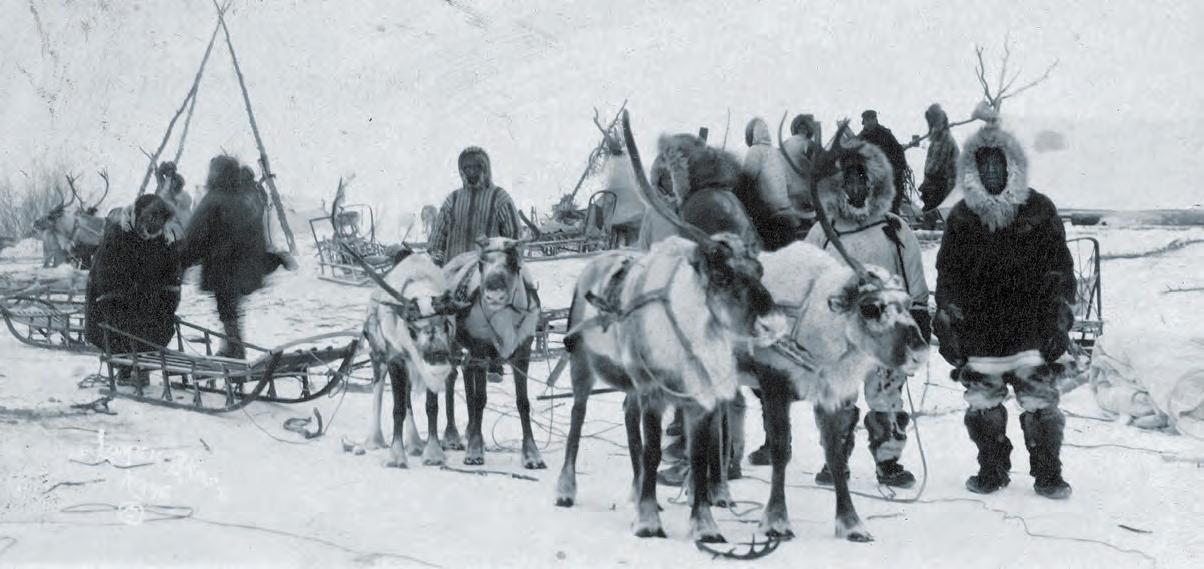
he’d employed as instructors. Iñupiat flocked from hundreds of miles away to see what the missionaries at Teller were up to. Their intentions were implicit in The Eskimo Bulletin and explicit in Jack son’s reports to the federal government. The reverend—who stood just 5 feet tall but was colossally ambitious, egotisti cal and often tactless—considered rein deer “an important factor in the civiliza tion of the Eskimos.”
Iñupiaq chronicler Inez Ayagiaq Black instead recalled how the newcomers’ dealings unraveled the cultural fabric of northwestern Alaska Natives. “When the young men started working, their lifestyle changed,” she said. “They didn’t eat only Eskimo food. Their clothing changed. They didn’t use winter furs all the time, like the fur pants they used to wear.”
Jackson taught Iñupiat of both sexes English, math and domestic skills to prepare them for doing business with whites. Consider, for example, the following passage from a mission school language lesson sheet:
We-mok has 10 deer. They are big deer. Some of them are fat. Four of them are sled-deer.
Printed below it were verses from abolitionist writer Julia Ward Howe’s Battle Hymn of the Republic praising the fearful “grapes of wrath” and the beautiful lilies in which “Christ was born.”
WILD WEST WINTER 202342 LIBRARY OF CONGRESS (4)
WIWP-WINTER-2023-REINDEER.indd 42 9/30/22 1:02 PM
Underlying Jackson’s agenda was his generation’s overarching belief in Manifest Des tiny. Reindeer would not only turn hunters into herders, he thought, but also “utilize hundreds of thousands of square miles of moss-covered tundra…and make those now useless and barren wastes conducive to the wealth and prosperity of the United States.”
Yet for millennia such “barren wastes” had sustained people who were neither ranchers nor miners nor farmers. The North Country animals (fish and sea mammals) were their crops. “Any time that we wanted an ‘apple,’” recalled Iñupiaq leader Eben Hopson from Utqiagvik (formerly Barrow), “we went out and got it. We got what we wanted to live on, got what we needed.”
In place of that carefree subsistence lifestyle those Iñupiaq apprentices selected by the mission instructors received five years of schooling, room and board included. His first year an apprentice earned the loan of two female reindeer (and any offspring they bore), the second year five, the third and each year after 10. At the end of five years, if judged adequately skilled, each was loaned enough reindeer to increase his herd to 50 head.
From the outset tensions flared between the missionaries and their Chukchi instructors. Among other “transgressions,” when the Chukchi were thirsty, they would lasso reindeer cows, kneel and drink directly from their teats, quaff ing milk, Jackson observed, “with as much enjoy ment as if it had been pure nectar.” More offensive still was their practice of leading the salt-loving reindeer by marking the ground with streams of urine poured from a sealskin bag. To missionary sensibilities such behavior would do nothing to help civilize the Iñupiat.
In 1894 the exasperated missionaries recruited 16 Saami (seven herders and their families) from Lapland to replace the Chukchi instructors. A clause in their contract bound the Saami to be
Killer Deer?
Reindeer Rush
The 1893 formation of the Alaska Reindeer Service brought a flood of hopeful Iñupiat, like this dealer in reindeer hides, eager to profit from the trade in venison and fur.

have “orderly and decently and to show discipline.” Each brought his own sled and herding dogs and would receive 100 deer for three to five years of service. The Iñupiat soon warmed to the “Card People,” as they dubbed the Saami, whose traditional curled toe boots and Four Winds hats re minded them of the garb of playing card jokers, jacks and kings. But the trainees continued to chafe at their subordinate status, the monotony of herding (compared to hunting or fishing) and the lack of immediate payback.
Ironically, considering Jackson’s stab at acculturation, the need to contin ually shift reindeer to prevent overgrazing required the Iñupiat to lead more nomadic lives than they had as hunters and fishers. Shadowing the herds all summer, they walked or jogged up to 30 miles daily. “The deer run the herder,” Saami instructor Andrew Bahr said. Iñupiaq herder Chester Seveck, who tended reindeer for 46 years, summed up the herders’ existence. “We keep moving camp every 10 days or two weeks to another grazing ground in win tertime,” he recalled in his clipped English. “In summertime we keep rein deer on the coast near ocean side where flies and mosquitoes not so many.”
In the winter of 1897–98 the owners of eight whalers trapped in an ice field near Point Barrow appealed to President William McKinley on behalf of their 265 stranded crewmen. As it was too late in the year for the U.S. rev enue cutter Bear to push through the pack ice, the rescue party disembarked at Cape Vancouver and traveled overland, first stopping by Teller Station to purchase a herd of reindeer—food on the hoof. In what became known as the Overland Relief Expedition they were to drive north “40 tons of meat.”
Six men—including officers from Bear , station superintendent Lopp and native herder Charlie Antisarlook—set out for Point Barrow in midDecember. Picking up more Iñupiaq herders along the way, they sledged
A reindeer herd congregates at Cape Prince of Wales, in western Alaska, in 1900. When Carl Lomen encountered his first vast herd of reindeer as he crossed the tundra near Nome that year, the visiting Minnesotan feared they might attack.
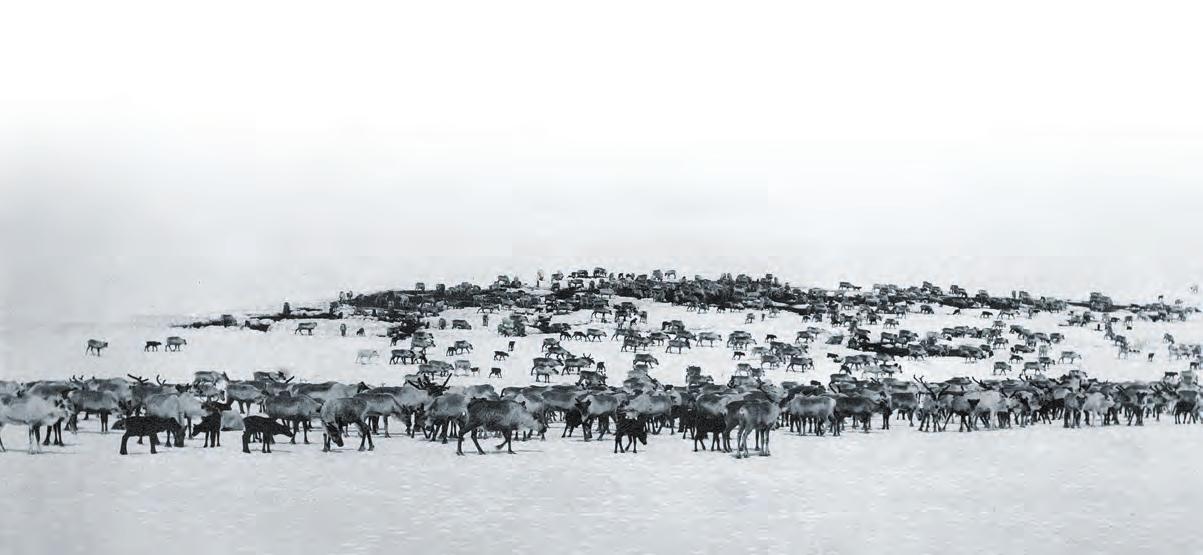
LIBRARY OF CONGRESS (4)
WIWP-WINTER-2023-REINDEER.indd 43 9/30/22 1:02 PM
provisions 1,500 miles by dog and deer while the men snowshoed and skied. As they crossed exposed Kotzebue Sound, they had to cut steps into pressure ridges and burn several sleds to keep warm. Approaching North Slope villages whose residents had never encountered reindeer, Lopp’s men clarified that the animals were not caribou to be hunted. After suffering blizzards, frostbite, polar bear attacks, 70-below temperatures and snow blindness, the men reached the stranded crews at Point Barrow by late March 1898, having lost only one-sixth of the herd.
That same year, with Nome in the grip of gold fever, outlying fortune seek ers clamored for meat and regular freight and mail delivery. To supply their needs, Lopp and his herders established a “reindeer express” between Nome and the mining camps in the York Mountains. The first government mail route to St. Michael, a Yukon River gateway to the Klondike, opened in 1900.
Draft reindeer quickly surpassed sled dogs, as the former grazed freely, while food for the latter had to be bought, fished for or shot and then carried. Haul ing up to 300 pounds each, mail service reindeer could cover 30 to 50 miles in a stretch. The animals rested at way stations, pawing lichen from beneath the snow. In a land of few trees, makeshift fences of burlap, willow or slabs of lake ice easily held them. Some traveled 6,000 miles in a single winter. That said, most Iñupiat preferred dogs, as reindeer kicked up snow into a driver’s face and tended to slip and fall on glare ice. One storm toppled reindeer and over turned loaded sleds like toys, and at least one Saami mailman froze to death.
Around the turn of the century the winds of opportunity blew a par ticularly enterprising family into Nome. In June 1903, having spent a work
People of the North Country
Above: Saami herders recruited from Lapland pose in traditional garb with their families and working dogs at Teller Station in 1894. Left: Changunak Antisarlook Andrewuk, aka “Sinrock Mary,” poses while sawing a deer leg. The widow of a Teller Station trader, Mary once owned the largest herd in the North Country.

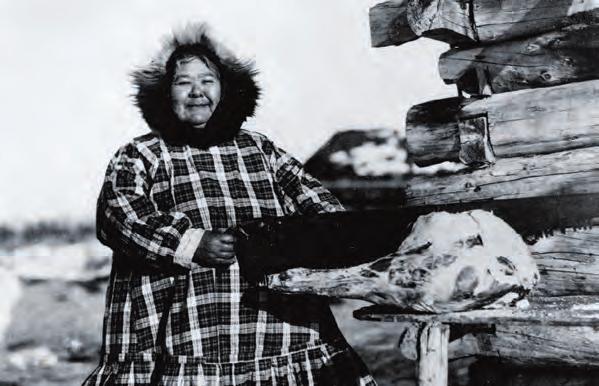
ing vacation there at the height of the gold craze, Carl J. Lomen and his father, Judge Gudbrand J. Lomen, of St. Paul, Minn., moved to town. Carl’s mother, four brothers and sister soon followed. As shrewd hawkers of reindeer meat and the Christmas holiday, the Lomens would rise to become Nome’s wealthiest family.
Carl’s initial reindeer sighting paints him as something of a citified “dude,” for while he was crossing the tundra near Nome in the summer of 1900, a herd stopped him dead in his tracks. Ignorant of the habits of reindeer, he feared they might attack.
By the time of his family’s move chances to score still abounded in the territory’s most-popu lous city. In 1908 the Lomen brothers bought a photo studio, stocking it with cameras and glassplate negatives acquired from other photogra phers. They soon mastered the craft while learn ing to keep their gear and fingers functioning at subzero temperatures. Cashing in on the soonto-be-territory’s aura and newfound popularity, the brothers sold their images as postcards and to various newspapers and scientific publica tions. In 1914 the family launched the Lomen Co., a meatpacking business stocked with 1,200 rein deer purchased from an aging Saami. Within a couple of years the enterprise was shipping meat to the Lower 48.
Carl Lomen, who boasted of the family’s “many pleasant relationships with the native people,” pledged that he and his brothers represented no threat to local herders, as they’d focus on national markets. By then, however, most miners had left the region, leaving no significant local buyers.
WILD WEST WINTER 202344 TOP: HUNTINGTON LIBRARY; ABOVE: ALASKA STATE LIBRARY AND ARCHIVES LIBRARY OF CONGRESS
WIWP-WINTER-2023-REINDEER.indd 44 9/30/22 9:56 AM
Lacking the funds to build slaughter houses or underground cold storages— natural freezers that took advantage of permafrost—Iñupiaq herders couldn’t compete on the national stage, not that they had any stateside connections. Conflict over prime rangeland mounted as Lomen came to control the best graz ing grounds, charging native herders a use fee and collecting a herding fee for each Iñupiaq reindeer that got mixed up with his animals. While the Lomens did hire native herders and buy their excess steers, such were largely token gestures to maintain good will. Regardless, the natives were far from throwing in the towel. With seed stock from the firmly established mission herds, additional Iñupiaq reindeer stations sprung up in Iliamna, Barrow, Kivalina, Nulato and as far inland as Bettles.
In his 1954 memoir Fifty Years in Alaska Lomen gave patronizing due to native resilience and good humor. “Civilized men,” he wrote, “would become despondent living under like conditions, but the Eskimo meets them lightheartedly. He exhibits no concern for the morrow.” Pages later, however, the entrepreneurial meat-packer belied his true feelings with a quote from Iñupiaq herder William Allokeok of Shishmaref: “If you wish a good living from your deer, you should think and plan how to care for them. If you don’t, your herd will decrease.”
Unfortunately, no amount of skill and dedication could guarantee an Iñupiaq herder’s success. By 1896 Jackson had changed the apprenticeship terms so that no animals could be earned during the period of instruction, and native herders could no longer expect the loan of a starter herd on graduation. The new rules also specified that when an Iñupiaq herder died, half of his herd reverted to the mission.
Lopp and others sincerely concerned about native livelihoods raised the alarm, prompting a 1905 Interior Department investigation of the mission stations. It found that the missions, their supervising Scandi navians and the government itself, not native herders, owned most of the 10,000-plus head then in Alaska. Jackson, singled out for his conflicting interests as the district’s agent of education and field agent of the Presby terian missions, resigned, and a new policy was implemented to place more reindeer into native hands. Instead of having to qualify through appren ticeships, Iñupiat could simply purchase reindeer from fellow herders, though they were still not permitted to sell female breeding deer to non natives. Only through a legal technicality had Lomen been able to buy his original herd, as no sales restrictions had been imposed on nonnative herds.
Alas, the government reforms benefited few native herders, and most of those only temporarily.
Among the few truly successful native herders was “Sinrock Mary.” Born Changunak in 1870 to an Iñupiaq mother and a Russian trader father, she was raised in bustling St. Michael. Growing up trilingual, she worked as a linguist and interpreter for Jackson and legendary U.S. Revenue Service Captain Michael A. Healy before achieving fame herself as the “Queen of Reindeer.”
In 1889 Mary married Charlie Antisarlook—the Teller Station herder who a decade later would join the Overland Relief Expedition. The couple moved to Cape Nome, where Charles had established a modest herd, the
Iñupiat and Their Reindeer ‘Rides’ Domesticated reindeer in decorative harnesses wait for their Iñupiaq handlers to make the next move. The Iñupiat are Alaska Natives whose coastal territory runs from Norton Sound, on the Bering Sea, northeast along the Chukchi and Beaufort seas to the Canadian border.

first owned by an Alaska Native. When her hus band succumbed to measles in 1900, Mary worked diligently to maintain the herd, selling meat to local businesses and the Army station. Her second husband wasn’t interested in reindeer, so Mary adopted 11 children, among them little ones the epidemics had orphaned. She transformed them and other Iñupiat into “deer men” able to manage their own herds.
At one point “Queen Mary” reigned over the largest herd in the North Country. Through her children she also managed to uphold such Iñu piaq traditions as gathering berries and greens, fishing and preparing skins for sewing. Conniving to cheat her out of her inheritance, rumrunners and drifters slurred the stately, curly-haired woman, threatened and sued her, shot at her deer to scatter them, killed and left some rot ting on the tundra, and proffered her liquor to cloud her judgment. One Swedish schemer pre tended to be her third husband, while relatives of her dead husband, inflamed with a new kind of fever—the lust for unearned wealth—tried to disown her, stating that Iñupiaq inheritance rules favored males.
Changunak had long witnessed the effects of greed, disease and lawlessness. Miners staking claims within grazing ranges often destroyed the natural reindeer and caribou forage by burning off vegetation. Scores of other reindeer were lost to rustling. With the proliferation of Nome honkytonks and home brewing, alcoholism became rampant. The encroachment on native hunting and fishing grounds brought new diseases—small pox, influenza, measles, etc.—to which Alaska Na
WILD WEST WINTER 2023 45 TOP: HUNTINGTON LIBRARY; ABOVE: ALASKA STATE LIBRARY AND ARCHIVES LIBRARY OF CONGRESS
WIWP-WINTER-2023-REINDEER.indd 45 9/30/22 9:56 AM
Man on the Move
Iñupiaq herder Chester Seveck tended reindeer for 46 years. In wintertime, he recalled, the herders kept moving camp every 10 days or two weeks to find graze, while in summer they kept the herds along the coast.

tives had little resistance. By century’s end more than half the native population in northwest ern Alaska had died. According to Sister Frances Kittredge of the Cape Prince of Wales mission, whose sister Ellen had married Teller Station superintendent Lopp, hardly any Iñupiat over 50 years old was left, and few younger than 5. “There is hardly a family where someone is not gone,” she wrote to her mother.
A 1916 influenza epidemic practically wiped out Sinuk, aka “Sinrock,” the village from which Mary took her nickname and where she tended her herd. Lomen, who paid his helpers in cash, lured ever more herders away from the widow, who could only pay in reindeer and whose herd with ered away in the absence of competent care.
In 1915, to better integrate herding into Iñupiaq culture, Interior’s Bureau of Education began organizing weeklong annual fairs in centrally located settlements. As described by Lomen, these were splendid affairs, versions of Rocky Mountain fur rendezvous that echoed the ancient trans–Ber ing Strait barter gatherings at Sisualik, a spit near
Kotzebue. Clanging brass bells and the old man grunts of sled deer announced the arrival of delegates representing herds from all points of the compass. The herders wore fine costumes, while harnesses blazed with dangling yarn pom poms, and hand-carved walrus ivory buckles and clasps fastened the straps.
At times the pageant resembled a fashion show. Pukiq, snow-white fur from the animal’s belly or throat, was especially valued. It looked dashing on chocolate-colored summer hides or in contrasting panels or inserts of geometric motifs, like checkered parka hems. White deer leg skins made for fancy mukluk boots. Surviving photos of duotone skin rugs, whose designs mimic Navajo weaving, hint that some items were meant for collectors or other commercial markets.
The fairs adopted a flag—a red reindeer on a white field bordered in blue— which snapped in the arctic breeze beside the Stars and Stripes. Attendees field-dressed animals, cooked, shared stories and sang. “They had races using one sled deer, then two sled deer and then four sled deer and eight sled deer,” longtime herder Seveck recalled. There were shooting and heavy-pull contests (with 1,600-pound loads of sand), men’s and women’s snowshoe races, and bow drill fire-starting and snow-melting competi tions. In one popular rodeo contest a man roped and then harnessed a feisty bull reindeer, drove a distance and then sped back to the start. When herders wanted to perfect their throwing skills without disturbing their grazing animals, one of their own would play the target, scampering about with antlers atop his head. Another amusing winter exercise for ropers, Ellen Lopp wrote in a letter, “was to go to a long hill, get some children to coast down on sleds or barrel staves and lasso them as they went sliding down.” Fall and spring roundups likewise were social events. Families camped at the corrals and chipped in on such tasks as separating out the respective herds, choosing steers for future draft duty and castrating newborn calves. Castrating calves allowed selective breeding and improved the meat of steers that skipped the fall rut. It also made males more docile for pulling sleds. A family culled its herd for food and clothing and tallied how much it had grown. As cows sometimes bear twins and calve annually after becom ing yearlings, well-serviced herds could swell by more than a third every spring. Like the Saami, the Iñupiat ear-notched reindeer for identification, as their fur is too thick for branding.
Exponential growth. Investment and interest. Supply and demand. By the late 1920s many Iñupiat had joined the capitalist venture. For the first time they owned live animals individually. “The deer is just like money,” herder Cudluck Oquilluk aptly put it.
And therein lay the seed for the industry’s demise. Despite Lomen’s salesmanship, his attempts to sell “America’s New Health Meat” to a nation raised on beef, mutton and pork yielded only modest results. Seeing their returns threatened by reindeer meat, the big beef producers fought the Lomen Co.’s every effort to ramp up sales. Reindeer hides earmarked for glove making fetched good prices at Seattle auctions, and thousands of rein deer were slaughtered for their leather alone. As outside markets collapsed, people fed excess reindeer meat to dogs or used carcasses to bait fox traps.
The Depression and mysteriously crashing herds—a “great die-out” between the 1930s and ’50s—doomed lucrative herding in Alaska. A flurry of protests from native herders precipitated the 1937 Reindeer Industry Act, which transferred all nonnative herds and equipment to the Bureau of Indian Affairs and, therefore, to the Iñupiat (until 1997, when a court decision reopened the industry to nonnatives). Lomen in particular had been a target of Interior Department investigations for about a decade. At the liquidation of his depleted herd in 1940 the government paid just $3 to $4 a head, whereas in the industry heyday a reindeer had sold for
WILD WEST WINTER 202346 MICHAEL ENGELHARD COLLECTION LIBRARY OF CONGRESS
WIWP-WINTER-2023-REINDEER.indd 46 9/30/22 9:57 AM
upward of $65. “By the late 1930s the Eskimos of Alaska had taken both legal and cultural control of what was originally designed to be a project of assimilation,” environmental historian Roxanne Willis observed.
Precipitating a crash of the Seward Peninsula herds in the winter of 1938–39 were wolf kills and losses of reindeer the Iñupiat believed had tired of being herded and wandered off to join migrating caribou. Seveck had vivid memories those weeks, the twilight of an era. “Three big herds of reindeer follow the caribou and lost completely,” he recalled. “The caribou very wild and travel day and night. We must let them go because we could not catch them. They too fast for us to follow.”
The last great trail drive left Kotzebue Sound in 1929, an epic five-year trek plagued by wolves, storms, deserting Saami herders and mosquitoes that stampeded reindeer into the wilds. The Canadian government had con tracted with Lomen to deliver a herd of 3,000 reindeer to the Mackenzie River delta, as officials there also wanted reindeer stations to boost native economies. But herding also failed to root deeply in Inuit culture.
Alaska’s Iñupiat and their Yup’ik neighbors, who’d adapted to changes in nature over millennia, were not particularly upset by the reindeer’s dis appearance. The endeavor had brought more toil than reward, and many men gladly spent more time with their families again, embracing ingrained, engaging subsistence.
Interviewed at age 83, Seveck reminisced about what the ex-herders sought to reclaim, a time be fore businessmen came into that country. “Many Eskimo people were old ages, brave and long life,” he said. “Never sick, only dying by accident and starvation. They works together. They hunt to gether to help one another. They divided equally things among themself.”
Michael Engelhard, who lived briefly on Lomen Avenue in Nome, is the author of Ice Bear: The Cultural History of an Arctic Icon. For further reading he recommends Saami, Reindeer and Gold in Alaska: The Emigration of Saami From Norway to Alaska, by Ornulv Vorren; Ice Window: Letters From a Bering Strait Village, 1892–1902, by Ellen Louise Kittredge Lopp and William Thomas Lopp; The Eskimo and His Reindeer in Alaska, by Clarence L. Andrews; and The Yukon Relief Expedition and the Journal of Carl Johan Sakariassen, edited by V.R. Rausch and D.L. Baldwin.
Deer

Planning for the future and bolstered by patriarch Judge Gudbrand Lomen’s legal maneuvers, his sons kept ex panding the family business. Between 1920 and ’29 they built slaughterhouses and process ing facilities, successfully cross breeding reindeer and caribou. With four freighters and a fleet of smaller vessels they con trolled the peninsula’s vital shipping points. Dominating the export market of reindeer meat and skins, they outgrew smaller-scale Eskimo herders, who struggled. A savvy publicist, Carl Lomen used radio and print ads to convince Americans that Alaska reindeer was a leaner, cheaper alternative to beef, as well as a highend specialty food. He approached railroads and large New York hotels, suggesting they put reindeer on their menus. To popularize the unfa miliar meat, he had prominent critics, especially those in Eastern cities, taste-test it. Promotional images from the brothers’ photographic studio helped sell the meat and the accompanying fic tion that reindeer enriched all Alaskans equally.
On Christmas Eve 1923 a gaggle of Iñupiat children shyly followed a slender Santa in muk luks driving a reindeer-drawn sleigh down Nome’s Front Street while elders watched from the board walk. The performance was an ad gimmick spon sored by the Lomen brothers and hardware store owner E.L. Holt. Lomen’s promotion drew the attention of Macy’s, which featured sleigh-pulling reindeer in stateside department stores and Christmas parades, though Macy’s version of a sleigh sat atop a car chassis. Meanwhile, the Lomen brothers distributed Santa Claus snap shots and, rumor had it, forged letters to newspapers from “children” asking for Santa and his reindeer to visit their cities. A staged promotional search complete with wire updates finally tracked down Santa at Icy Cape, Alaska, and the jolly old elf eagerly agreed to visit the children of America. The Lomens happily provided live reindeer for the subsequent stateside promotions, sending “authentic Eskimo” herders south with their livestock shipments. At one especially large 1927 Thanksgiving event in Brooklyn’s Prospect Park 450 patrolmen and mounted officers were on hand to curb the 100,000 spectators who’d come to see St. Nick, his ungulates and their exotic handlers.
The media swallowed the package—Santa, fake beard, elflike help ers, tribal costumes, hooves, reins, antlers and all. Decades later Iñupiat herder Chester Seveck poked fun at the ethnic stereotypes while a guest on the popular TV show You Bet Your Life

“Chester, do Eskimo people loan or trade their wives?” host Groucho Marx asked.
“Yes,” Chester replied, delighting the audience, “I think about all same as Hollywood.” —M.E.
WILD WEST WINTER 2023 47 MICHAEL ENGELHARD COLLECTION LIBRARY OF CONGRESS
Santa
Carl Lomen
WIWP-WINTER-2023-REINDEER.indd 47 9/30/22 9:57 AM
Steadfast Scout
 Half blood Johnnie Bruguier served Colonel Nelson Miles and other officers on the northern Plains for nearly two decades.
Half blood Johnnie Bruguier served Colonel Nelson Miles and other officers on the northern Plains for nearly two decades.
OPPOSITE: ROBERT G. MCCUBBIN COLLECTION; THIS PAGE: SIOUX CITY PUBLIC MUSEUM WIWP-WINTER-2023-BRUGUIER.indd 48 9/30/22 1:05 PM
The Scout Who Straddled Two Worlds
HALF BLOOD JOHNNIE BRUGUIER SERVED THE ARMY WELL— BOTH BEFORE AND AFTER FACING CHARGES OF MURDER
BY AARON ROBERT WOODARD
The success of U.S. Army expeditions on the Western frontier depended on many factors. The acumen of the commander was a primary consider ation, of course, but the availability of water, accurate maps, adequate supplies, healthy troops and horses, and favorable weather all played a role. In many cases the reliability of information was the indispensable compo nent, making the difference between brilliant success and abject failure, even disgrace. Thus, perhaps no other member of a force was as irreplaceable as an experienced and trusted scout.
In an age without drones, satellite intelligence, telephones or even radios, scouts were the eyes and ears of an army. Field officers depended on the intelligence these hardy denizens of the plains and mountains provided, from approximate dis tances and descriptions of terrain to the likely behavior of Indian tribes and, foremost, the position of enemy forces.
Western films often depict the Old West scout as a scruffy, buckskin-clad white man, and many real-life scouts fit that description, notably Jim Bridger, Kit Carson, Buffalo Bill Cody and Wild Bill Hickok. But perhaps the most successful scouts were those with one leg in white culture and the other in Indian culture. Half-blood scouts who could move easily between both worlds were much in demand.
One such member of this small but prized club was Johnnie Bruguier, who was born in 1849 in a cabin built by his father, Théophile, at the confluence of the Missouri and Big Sioux rivers, on the site of present-day Sioux City, Iowa. A onetime trader with the famed American Fur Co., Montreal-born French

Canadian Théophile Bruguier had struck out on his own and did a brisk business with the Yankton Sioux. He was also simultaneously married to two Indian wives, a common prac tice in that time and place. Together they bore him 13 progeny. Johnnie was the third of seven surviving boys. His mother, Dawn, was the sec ond of Théophile’s Indian wives, both of whom were daughters of Yankton Chief War Eagle. Théophile gradually expanded his trade to the military. The family also received substantial land and cash payments stemming from the 1858 Yankton Treaty between the U.S. government and the tribe.
So, while Johnnie grew up on the frontier, it was not in hardscrabble circumstances. Théophile was determined his children receive an excellent education, and his financial acumen enabled him to send them in turn to the College of Christian Brothers in St. Louis, which remains in operation as a prep school. Founded in the 1670s by French priest JeanBaptiste de la Salle (since recognized by Roman Catholics as the patron saint of teachers), the religious order that ran the college championed La Salle’s innovative teaching practices, thus Johnnie received a cutting-edge education.
Théophile’s first wife, Blazing Cloud, died in 1858, while Dawn died just three years later. In 1862 Théophile took a third wife. This time he chose a white woman, refined St. Louis native Victoria Brunet. Apparently, she was ill-equipped to mother such rambunctious children of the frontier, as Johnnie and his siblings spent increasingly longer periods with rela tives of their late mothers on the Yankton Sioux Indian Reser vation, in southeastern Dakota Territory.
49WILD WEST WINTER 2023
Théophile Bruguier
OPPOSITE: ROBERT G. MCCUBBIN COLLECTION; THIS PAGE: SIOUX CITY PUBLIC MUSEUM WIWP-WINTER-2023-BRUGUIER.indd 49 9/30/22 1:05 PM
On Sept. 3, 1863, 13-year-old Johnnie was a passenger aboard the mail coach from Fort Randall, Dakota Territory, returning east to Sioux City on the stage road along the Missouri River. Accompanying him was a soldier he’d befriended, 24-year-old Sergeant Eugene Trask of the 7th Iowa Cavalry Regiment. As usual the sergeant was entertaining the someday scout with tales of Indian battles and massacres, perhaps relating depre dations committed during the 1862 Sioux Uprising in nearby southwest Minnesota. (That spring the Army had settled the exiled Santee Sioux from Minnesota on a reservation along the stage road in Dakota Territory.) Suddenly gunshots rang out around the coach, and Trask dropped dead at Johnnie’s side. As the driver reined the horses to a standstill and bolted for his life, four Santees in warpaint rode up to the coach. Recognizing his own peril, young Bruguier spoke to the attackers in their language. Pre sumably assuming the boy, though light-skinned, must be one of their own, the four raiders let Johnnie be. After rifling through the contents of a trunk, they rode off with the coach’s team.
Perhaps emboldened by his first brush with death, Johnnie pressed to accompany his father’s far-flung trading ventures. He often joined Théophile’s wagon trains as they made their way up the Missouri with trade goods and then returned with expansive loads of furs and buffalo robes that further added to the family coffers. As he gained experience,
From Cabin to College
Above: Théophile Bruguier’s cabin was moved to Riverside Park in Sioux City, Iowa, in 1934. His son Johnnie, born to a Yankton Sioux mother, grew up on the frontier. Left: Théophile’s success as a fur trader enabled him to send his children to the College of Christian Brothers in St. Louis.


young Bruguier took on greater responsibilities with the company. But while he might some day have inherited his father’s business empire, Johnnie had other ideas.
In 1868 the U.S. government negotiated the Treaty of Fort Laramie, establishing the 60million-acre Great Sioux Reservation in Dakota Territory (west of the Missouri River in presentday South Dakota). Various Indian agencies were established west of the Missouri, and in the fall of 1870 Johnnie’s older brother Charles took a job with the Grand River Agency, near the mouth of the namesake river along the present-day interDakota border. Johnnie joined him there the next summer. Many Sioux, mostly Hunkpapas and Yanktonai (the latter one of the seven subtribes of the Dakotas who spoke the same dialect as the Yanktons), still roamed free, and agency officials had been tasked with turning such “renegades” into “civilized” Indians.
On July 12, 1871, Johnnie signed up as a scout and interpreter for the soldiers assigned to pro tect the agency. He served in that capacity through March 31, 1872, and the next day hired on with J.C. O’Conner, Grand River’s civilian agent. John nie’s little brother Billy took a job with O’Conner that year, as did youngest brother Sam the fol lowing June. The Bruguier boys, though serving mainly as interpreters, were jacks-of-all-trades
WILD WEST WINTER 202350 LIBRARY OF CONGRESS (4)
WIWP-WINTER-2023-BRUGUIER.indd 50 9/30/22 9:58 AM
at the agency. During slow periods they hired out for various enterprises, even working at times for local farmers.
While most of the Sioux were adjusting to reservation life, several trouble some non-agency bands remained at large, including the Hunkpapa one under de facto leader Sitting Bull. Such bands were upset with the Northern Pacific Railroad, which was laying track ever closer to the last of their tradi tional buffalo hunting grounds. In August 1872 the government scheduled a follow-up peace conference at Fort Peck, a trading post in northeastern Montana Territory. As in the past, Sitting Bull refused to attend. Instead, he sent his brother-in-law with instructions to inform the assembled offi cials Sitting Bull would only consider attending “whenever he found a white man who would tell the truth.” His absence didn’t stop the government from recruiting Sioux of lesser standing for a goodwill trip that fall to Washington, D.C. Assigned to the party as an interpreter, Johnnie handled not only the day-to-day communications between federal officials and their wards, but also the flood of reporters who swarmed the Indian con tingent at every whistle-stop. Arriving in Washington on September 15, the group returned to the reservation via New York City in late October.
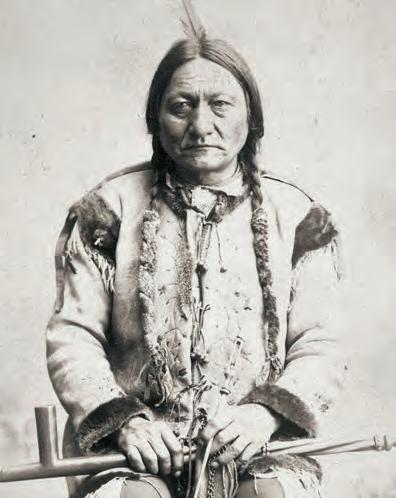

Bruguier resigned his agency position on May 31, 1873. By then the Army had sent Lt. Col. George Custer and the 7th U.S. Cavalry to Dakota Territory to protect Northern Pacific surveyors from attack. According to author and researcher John S. Gray, although Johnnie’s name doesn’t appear in official Army records as having accompanied Custer’s forces, he likely came along as an interpreter or scout or both.
During the 1873 Yellowstone Expedition two civilians—Dr. John Honsinger, a veterinarian, and Augustus Baliran, a sutler—were riding ahead of Custer’s main column, seeking water for their horses, when a party of Sioux warriors ambushed and killed them. Bruguier would soon learn the identity of the killer. That fall Edmond Palmer, O’Conner’s successor at the Grand River Agency—which had been moved up the Missouri and renamed Standing Rock—hired Johnnie. During that bleak and bitter Dakota winter some of the non-agency bands camped near the agency to take advantage of government rations. Lingering around the lodges of these new arrivals, Johnnie overheard Rain-in-the Face, the Hunkpapa war chief, bragging about having murdered Honsinger and Baliran.
On Feb. 10, 1874, Bruguier resigned his agency job and returned south along the Missouri to visit his family in Sioux City. En route he informed Colonel David S. Stanley, the commander at Fort Sully, about Rain-inthe-Face’s boastful confession. Stanley forwarded the information in a March 1 letter to department headquarters in St. Paul:
Sitting Bull
John Bruyere [sic], an educated half-breed, came here from Standing Rock yesterday. He informs me that the Indian who murdered the veterinary surgeon, Honsinger, and Mr. Baliran last August on the Yellowstone is now at Standing Rock Agency and boasts daily of having killed both these men with his own hand. The Indian says that the rest of the party wanted to spare the lives of the two unfortunate men, but that he killed them himself. Besides Bruyere, several white men have heard the Indian make this boast. To corroborate all this, Bruyere brought down Honsinger’s saddle and equipment, which he
Fall From Favor Frontier photographer David F. Barry (1854-1934) captured a census-taking day at the Standing Rock Agency in Dakota Territory. Johnnie was with younger brother Billy on Dec. 14, 1874, when Billy killed fellow agency employee William McGee. Both brothers fled.
LIBRARY OF CONGRESS (4)
WIWP-WINTER-2023-BRUGUIER.indd 51 9/30/22 9:59 AM
bought from the Indian. There is no difficulty of proving the murder, if the Indian can be caught. The arrest of the Indian will be a matter requiring address and force, as it may lead to a collision with all the Uncpapas [sic] camped at Standing Rock. I respectfully advise that the arrest be entrusted to Lt. Col. G.A. Custer, with not less than 300 men. John Bruyere will be at home, 2 miles from Sioux City, about the time this letter reaches St. Paul and is perfectly willing to go as guide. He was out as scout last summer and is well known to General Custer. If the department commander thinks favorably of this arrest, I would suggest that he summon John Bruyere to come to St. Paul to learn the full probabilities of success. A dispatch, care of Captain [W.W.] Foster or Mr. John H. Charles, would reach Bruyere at once.
Notwithstanding all the murders the Sioux have committed on this river, there has never yet been an arrest, and this seems to me to be a favorable opportunity. Standing Rock is only 25 miles from Fort Rice, and the march can be made in one night.
Stanley’s superiors met his letter with decided inaction. But later that year Rain-in-the-Face, unrepentantly boastful as ever, reappeared at Standing Rock. Apparently, that bit of news made its way north to the desk of Colonel Custer at Fort Abraham Lincoln. Still furious over the two civilian murders during the Yellowstone Expedition, Custer dispatched Captain George W. Yates and two companies of cavalry to arrest Rain-inthe Face. Yates did so on December 14, and in his report the captain gave high praise to Bruguier for his reliability and good service to the troopers by helping them identify Rain-in-the-Face.
Till then Bruguier’s life and career had run along fairly conventional lines. He might have gone down as an obscure footnote in the chronicles of the Old West. But an incident at the agency on Dec. 14, 1874—exactly a year to the day after Rain-in-the-Face’s arrest—recast Johnnie in the minds of many from trusted scout to wanted murderer. The Bismarck Tribune broke the news:

STANDING ROCK, D.T., Dec. 16: A sad affair occurred here Tuesday evening [December 14] about 10 o’clock that has resulted in the death of William McGee, an employee at the agency, from a blow delivered by Billy Brughier [sic], a half-breed Indian. It seems McGee was about retiring when Brughier and his brother John, the agency interpreter,
entered the room considerably under the influence of liquor. McGee evi dently endeavored to get one or both of the boys to bed when Billy fired two shots at him from his revolver, miss ing his aim entirely; he then struck him a terrible blow with his revolver just above the left ear, fracturing the skull in four different places. Word was immediately sent to the guard at the garrison for assistance in search ing for the murderer, who had imme diately proceeded to the stable and, mounting his pony, had fled to Two Bear’s camp, about 2 miles above the agency. Lieutenant G.B. Walker, of the 6th Infantry, proceeded to the Indian camp yesterday with a small party in search of Brughier, but it was found that he had fled. He is supposed to have gone to Bis marck and from there to Minnesota in order to get among the Red River half-breeds, he having expressed such as his intention.
McGee was a quiet, hardworking man and leaves a father, mother and daughter living at last accounts near Martinsburg, [W.]Va.
Assistant Surgeon T.A. Davis and Dr. S.S. Turner held a postmortem examination of the remains this morning.
This same Brughier, but a few days ago, attempted to shoot John McCarthy, of Bis marck, and when under the influence of liquor is always trying to kill someone.
Within days an Army patrol tracked down Billy and turned him over to federal officials in Bis marck. Sentenced to a 10-year prison term in June 1875, he was pardoned by the Dakota terri torial governor on New Year’s Day 1882, having served just seven years of his sentence.
Although Johnnie hadn’t struck the deadly blow, he, too, had fled and was eventually charged as an accomplice in the murder. In the minds of many of his contemporaries, as well as subse quent historians investigating the matter, his flight only established his guilt.
The Bruguiers had both relatives and fast friends among the Sioux, and Johnnie drew on those contacts to hide him. On hearing a warrant had been sworn out against him, he headed south west into the Black Hills. In February 1876 the warrant reached the U.S. marshal in Yankton, who dispatched a posse into the hills to seek out the half-blood fugitive. But Johnnie eluded them, and the posse returned to Yankton in July without its man.
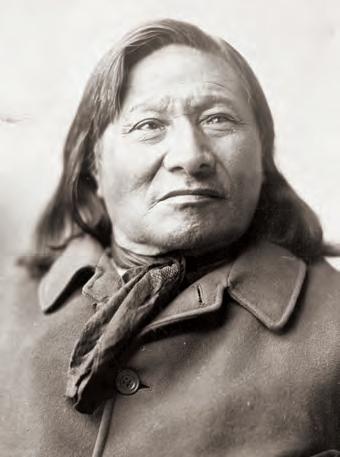
WILD WEST WINTER 202352 LIBRARY OF CONGRESS (2) NORTH WIND PICTURE ARCHIVES/ALAMY STOCK PHOTO
Colonel David S. Stanley
Rain-in-the-Face
WIWP-WINTER-2023-BRUGUIER.indd 52 9/30/22 9:59 AM
According to a 1932 letter written by nephew John Bruguier, his uncle soon sought refuge in the lodge of Sitting Bull himself. In late August 1876, mere weeks after the shocking defeat of Custer’s 7th Cavalry com mand on Montana’s Little Bighorn River, Johnnie arrived in the Hunkpapa camp wearing the garb of an Army scout. Warriors were ready to brain him on the spot until Sitting Bull intervened. “Well, if you are going to kill this man, kill him,” the iconic leader reportedly told his warriors, “and if you are not, give him a drink of water, something to eat and a pipe of peace to smoke.” Thus accepted into Sitting Bull’s band, Bruguier served as an interpreter in many tense encounters between the Army and the fugitive Hunk papa leader, who stalwartly refused to surrender, let alone move to the reservation.
By year’s end a weary Bruguier resolved to get back into the good graces of his former employer. Breaking off from Sitting Bull, he joined Iron Dog’s Hunkpapa band, which that October 31 made a winter truce with agent Thomas J. Mitchell at Fort Peck. Johnnie ap proached Mitchell with a Little Bighorn relic one of Sitting Bull’s warriors must have looted from the battle field—a paymaster’s check for $127 made out to Cap tain Yates and endorsed over to Captain William W. Cooke. Both Yates and Cooke had died with Custer on June 25. The peace offering worked, as Mitchell welcomed Bruguier back into the fold.
Meanwhile, the Army kept hot on the trail of Sitting Bull. Colonel Nelson Miles, tasked with bringing in the elusive chief, tapped Bruguier for advice. On November 17 the two made a deal: Johnnie would employ his significant skills to track down and bring Sitting Bull to the negotiating table, and Miles would do what he could to assist Bruguier with his legal trouble. When Miles set out with his troops after Sitting Bull, he made use of Johnnie’s intelligence. The colonel must have been pleased, as on December 17, a month after striking their deal, Miles hired Bruguier as a regular Army scout.
Johnnie proved invaluable in subsequent Army campaigns against Crazy Horse, Lame Deer and Chief Joseph. He frequently rode alone into hostile Indian camps, bearing messages to and from field commanders and Indian chiefs. His superiors praised his courage and mentioned him in dispatches as a reliable and trusted scout.
Regardless, Bruguier remained under a cloud of suspicion in the murder of William McGee, and on Sept. 27, 1879, authorities finally arrested the fugitive scout at Fort Keogh, in southeastern Montana Territory. Though Johnnie faced federal prosecution, he took heart from the fact that nearly every citizen of neighboring Miles City signed a petition of clemency on his behalf. Town namesake Colonel Miles also let it be loudly known Bruguier was the best scout he had ever employed, and that he was con vinced of Johnnie’s innocence. The case went to trial in Fargo on Decem ber 30 and 31. Despite the determined efforts of the district attorney to blacken the scout’s character, the jury deliberated but a half hour before returning a verdict of not guilty.
Bruguier continued to serve off and on as a scout for his old friend Miles, who was promoted to brigadier general in 1880 and major general in 1890. That year Johnnie retired from Army service and settled near Poplar, Mont.,
The Art of Scouting
In this hand-colored woodcut of an 1885 illustration by Thure de Thulstrup (1848-1930) frontier scouts confer about the trail ahead. Bruguier proved his worth as a reliable and trusted scout in campaigns against Crazy Horse, Lame Deer and Chief Joseph.

on the Fort Peck Indian Reservation. There, on June 13, 1898, the old scout’s lifeless body was discovered on a lonely road. His head had been caved in with a wagon wrench. Authorities soon arrested another half blood, Ernest Strikler, for the crime. The motive went unrecorded, but it’s ironic that a man who had been in the thick of things on either side of the Indian wars was ultimately brought down by a wrench rather than a bullet or a tomahawk.
Aaron Robert Woodard, who writes out of Hart ford, S.D., teaches history and government at Pur due University Global and American history at Bellevue University. For further reading he recom mends The History of Dakota Territory, by George W. Kingsbury; History of South Dakota, by Doane Robinson; and “What Made Johnnie Bruguier Run?” by John S. Gray, published in the spring 1964 (Vol. 14, No. 2) issue of Montana: The Mag azine of Western History and available online.
53WILD WEST WINTER 2023 LIBRARY OF CONGRESS (2) NORTH WIND PICTURE ARCHIVES/ALAMY STOCK PHOTO
WIWP-WINTER-2023-BRUGUIER.indd 53 9/30/22 10:00 AM

OPPOSITE: GRAND RAPIDS HISTORICAL COMMISSION; THIS PAGE: ALLEN COUNTY PUBLIC LIBRARY
Massacre Victim On Oct. 26, 1853, Ute warriors attacked the central Utah Territory camp of Captain John Williams Gunnison and his transcontinental railroad survey party, killing him and seven others. Opposite: Brevet Lt. Col. Edward Steptoe was tasked with bringing their killers to justice.
WIWP-WINTER-2023-GUNNISON.indd 54 9/30/22 10:01 AM
Trouble in Zion
ORDERED TO UTAH TERRITORY IN 1854 TO BRING UTE MURDERERS TO JUSTICE, AN ARMY COLUMN VERY NEARLY SPARKED WAR WITH THEIR MORMON HOSTS
BY WILL GORENFELD
In the 1850s railroads were all the rage, and the U.S. Army was sent to survey poten tial routes west of the Mississippi River.
In the fall of 1853 Captain John Williams Gunnison of the Corps of Topographical Engi neers and members of his railroad survey party were murdered in central Utah Territory. Pres ident Franklin Pierce dispatched a column of soldiers to investigate and to gain hegemony over Mormons of the region. Considered by many a religious cult, members of the Church of Jesus Christ of Latter-day Saints had been driven out of Missouri and persecuted and attacked in Illinois through the 1830s and ’40s. So, in the summer of 1847 Mormon emi grants led by Brigham Young had launched a westward exo dus to found the State of Deseret, centered on Salt Lake City. In 1850 Congress organized the Mormon “Zion” as Utah Territory.
Captain Gunnison had long maintained friendly relations with the Mormons and in 1852 had published The Mormons, or, Latter-day Saints, in the Valley of the Great Salt Lake , a generally favorable account of their history. A year later the Army ordered the captain to conduct a topographical survey of the broader Great Basin region to determine its suitabil ity as a route for a proposed transcontinental railroad. On June 2, 1853, the survey party—comprising Gunnison and co-commander Lieutenant Edward Beckwith, topographer and artist Richard Kern and assistant topographer James Snyder, astronomer Sheppard Homans, surgeon and geol ogist Dr. James Schiel and botanist Frederick Creutzfeldt— set out from Fort Leavenworth (in what would soon be orga nized as Kansas Territory) for Utah Territory. Accompanying them were Brevet Captain Robert Morris, 2nd Lt. Laurence Baker and some 30 Mounted Riflemen, while wagon master Charles Taplin headed the teamsters. In October Gunnison and his scientific team were exploring terrain near the terri torial capital of Fillmore (Salt Lake City replaced it as the
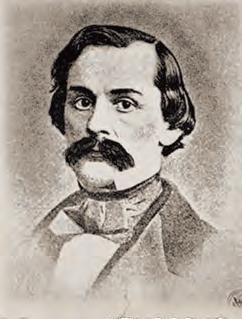
capital in 1856). Though warned of troubles with tribes in the area, the captain wasn’t worried, as he had established good relations with the local Ute band. But on the morning of October 26 Ute warriors attacked the party’s camp along the Sevier River near Black Canyon, killing Gunnison and seven others in what became known as the Gunnison Massacre.
Many Easterners were quick to pin the kill ings on the Mormons, suggesting they had either disguised themselves as Indians or incited the Utes to commit the outrage. Many federal officials also sus pected the Mormons had whipped up the tribesmen, perhaps out of fear a railroad through the territory would bring in “Gentiles” bent on further persecution. Secretary of War Jefferson Davis ultimately concurred, concluding the Mor mons had conspired with Pahvant Utes to murder Gunnison and his men. President Pierce, under the pretext of forging a new military road to California and Oregon, furnished Brevet Lt. Col. Edward Steptoe of the 3rd U.S. Artillery with troops, horses and mules and tasked him with investigating the mur ders and bringing the guilty to justice. Lieutenant LaRhett Livingston, one of Colonel Steptoe’s young officers, shared his understanding of the mission in a letter home to his father:
The principal object in our wintering here is to avenge the death of Captain Gunnison.…We are to keep dark [covert] until a fit opportunity for making prisoners or getting the real perpetrators of the deed. We are in fact sailing under sealed orders so as to further our purposes…whether the Indians had done it, for the sake of plunder and to gratify their bloodthirsty natures, or whether the Mormons had done it, or instigated the Indians to do it, for purposes of their own.
On June 1, 1854, Steptoe’s 175-man force, comprising two companies of the 3rd Artillery and a gaggle of 1st Dragoon re
55WILD WEST WINTER 2023 OPPOSITE: GRAND RAPIDS HISTORICAL COMMISSION; THIS PAGE: ALLEN COUNTY PUBLIC LIBRARY WIWP-WINTER-2023-GUNNISON.indd 55 9/30/22 10:01 AM
cruits, plus 150 civilians and more than 700 horses and mules, marched west from Fort Leavenworth bound for Salt Lake City. While some con temporary chroniclers suspected Davis had directed Steptoe to place all of Utah Territory under martial law, historians assert the secretary of war had instructed the colonel merely to assess the state of affairs in the terri tory and to help civil authorities identify and apprehend those responsible for the Gunnison Massacre.
Many of Steptoe’s troops groused about the mismatched surplus Mexican War uniforms they’d drawn from the quartermaster. Lieutenant Ben Allston, who proudly rode his steed at the head of his newly mounted unit and gloried in his newfound status, poked fun at his own expense in a letter home to his mother:
You would laugh to see my costume—one of your check shirts, rather more dirty-stained [than] you would like to see it, no collar and no cravat and a common gray flannel shirt used as a coat. This, with my pants rolled up to my knees almost, completes my costume.
Dangerous Territory Above: John Mix Stanley rendered this tinted lithograph of the Black Canyon after a sketch by Frederick W. von Egloffstein, who replaced the murdered artist Richard Kern. Left: Utes killed Gunnison, Kern and six other members of the survey party near this gorge on the Sevier River.
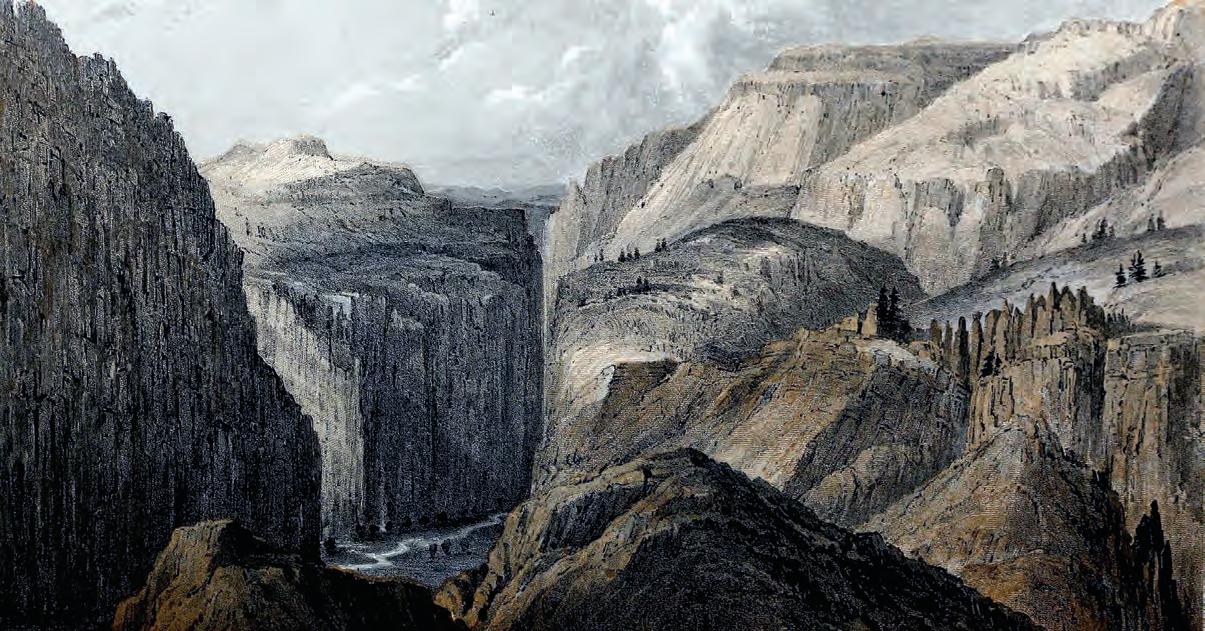
Captain Rufus Ingalls, Steptoe’s assistant quartermaster, painted a grand tableau of the caravan that set forth from Fort Leavenworth. It tallied 300 horses, 448 mules, 70 heavy baggage wagons and seven light wagons, to which the quartermaster had attached the horses in strings of from 30 to 40.
By late August the column had descended the western slope of the Rockies, rested and caught from a distance their first glimpse of fabled Salt Lake City. The opinion these soldiers had of the Mormons differed markedly from that expressed by dragoons on prior, recip rocally friendly encounters with Mormons. While stationed in Los Angeles during the 1846–48 Mex ican War, for example, local Mormons and dra goons had regarded one another with mutual respect. Sergeant Dan Tyler of the Mormon Bat talion recalled the situation there in 1847:
When bullies came into the town and began to impose upon the “Mormon boys,” the dra goons would not allow them to take their own part if they could avoid it, but would say, “Stand back; you are religious men, and we are not; we will take all of your fights into our hands,” and with an oath would say, “You shall not be imposed upon by them.” Several instances of the kind might be named.
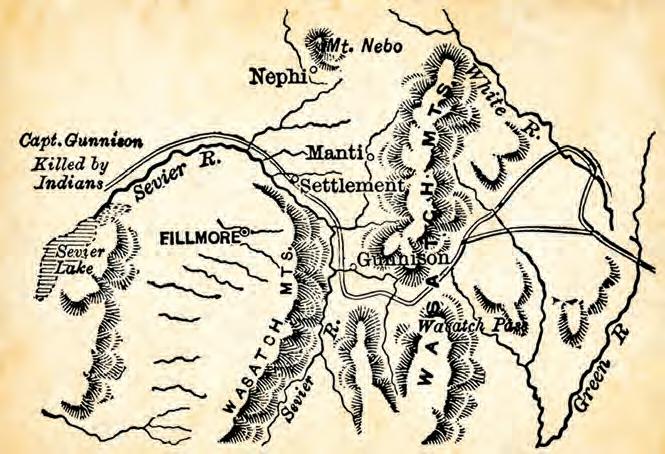
WILD WEST WINTER 202356 TOP: SAN FRANCISCO PUBLIC LIBRARY; LEFT: UNIVERSITY OF CALIFORNIA LIBRARIES ABOVE: WILL GORENFELD COLLECTION; RIGHT: BRIGHAM YOUNG UNIVERSITY
WIWP-WINTER-2023-GUNNISON.indd 56 9/30/22 1:09 PM
In the immediate postwar period, however, soldiers increasingly shared the opinion that Mormons were an undesirable element not conforming to prevailing Protestant norms. Polygamy was the leading object of their ire. “It is with difficulty that our officers can keep the soldiers from cleaning out the Mormon men,” wrote an enlisted man stationed at Fort Webster in New Mexico Territory. “They are given scant welcome or courtesy here and are hurried off as soon as possible.” In June 1852 the same soldier’s troop encountered a wagon train of California-bound Mormons. “[The men] are perfectly willing for the soldiers to protect their trains from the Indians but don’t want us to look at the women with them,” he wrote. “The Mormon men acting ugly and our officers, fearing trouble between the soldiers and them, did not permit us to remain long enough at the springs to rest before we are hurried off.”
News of the Gunnison Massacre further hardened both military and public opin ion against the denizens of Utah Territory.
“I cannot express to you what a thorough disgust I have for the whole religion,” wrote Lieutenant Allston, “and it only, in my opin ion, needs one to be an eyewitness to be of the same tone of feeling.” Such loathing reflected the general opinion among the rank and file.
The unexpected appearance of a sprawl ing Army column at the gates of Salt Lake City on August 3, 1854, shocked the Mormon leaders. Prophet cum Terri torial Governor Brigham Young and church elders rode out to meet the troops and protest their presence. “It was no use, however,” Private James Stevenson boasted in a letter home, “for in we went and were quartered in the very heart of the city.” German-born Private William Antes journaled of the column’s arrival and left a detailed description of the town and its residents. “Just imagine a continuous walk of three months, covering 1,200 miles, and think of our delight when…we reached Great Salt Lake City, Utah Territory,” he wrote. “We marched into the suburbs when our colonel soon made his appearance, accompanied by Brigham Young himself, as we soon discovered. All eyes were at once directed toward the great apostle of polygamy. He was dressed in black pants, white shirt, fine boots and a high silk hat. He wore no coat. At the time of which we write, Brigham Young was aged 53 years, and he gloried in the possession of 57 wives!” Antes went on to describe the settlement and its residents:
The city is well laid out with wide streets; the water, which comes from the mountain, runs on both sides of the streets. The houses are built of adobe, some one story, others two or three stories high; each house has a garden in the rear. The city is enclosed by a mud wall, with portholes here or there in case of Indian attacks. Three iron cannons are housed on a hill north of the city.
Salt Lake had then 12,000 inhabitants, mostly Mormons, consisting of Americans, English, Swedes, Germans, French Canadians and Denmark ians [sic]. There was at that time one theater, one hotel, about four goods stores [and] one bath built over a cold and hot spring…only a few feet apart. There was also a public square, called the Union Square, and the only church in the city was a Mormon house of worship and was only built as a temporary edifice. The foundation for the largest church in the world was partly laid at the time I saw it.
For a time Colonel Steptoe encamped in Union Square, the better to keep an eye on the locals. Relations between the soldiers and the Mormons were tense from the start. Days after the soldiers set up camp, some 500 new converts arrived in Salt Lake City and pressed for space in the square, their proximity posing a threat in the minds of soldiers.
In October the colonel initiated the expedi tion’s primary mission, sending a detachment under Brevet Maj. John F. Reynolds and Lieu tenant Allston to track down the perpetrators of the Gunnison Massacre. Among the detachment’s enlisted men were Privates Stevenson and Antes, the latter of whom nearly killed a fellow rider. “I narrowly escaped shooting a soldier by the accidental discharge of my gun,” Antes recalled. “In riding along, I suppose the hammer of my gun became entangled in the picket ropes, and hence the discharge. The soldier looked very pale for

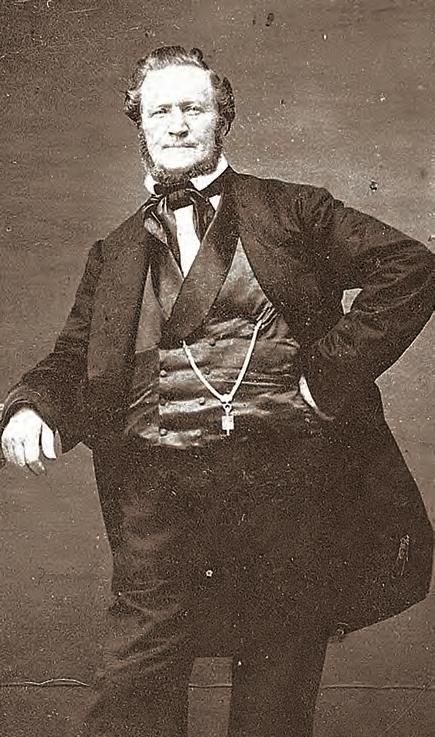
TOP: SAN FRANCISCO PUBLIC LIBRARY; LEFT: UNIVERSITY OF CALIFORNIA LIBRARIES ABOVE: WILL GORENFELD COLLECTION; RIGHT: BRIGHAM YOUNG UNIVERSITY
A Soldier and the ‘Mormon Moses’ Private James Stevenson (above left) was with the Army troops that appeared at the gates of Salt Lake City on Aug. 31, 1854. Territorial Governor Brigham Young (above) and church elders protested their presence. “It was no use, however,” recalled Stevenson, “for in we went and were quartered in the very heart of the city.”
57WILD WEST WINTER 2023 WIWP-WINTER-2023-GUNNISON.indd 57 9/30/22 1:09 PM
Sylvester Mowry
awhile from the fright I had unintentionally given him.” The percussion firearms carried by mounted soldiers in the antebellum era were notoriously dangerous, not only to the enemy but also to the shooter. Most bore conspicuous hammers on the right side of the gun, making them susceptible to snagging and accidental discharge, as Antes learned to his chagrin.
Through the winter months the column’s sup plies of food, provender and clothing intermit tently ran low, requiring the Army to purchase supplies from Mormon merchants, usually at inflated prices. Yet Antes went out of his way to mention the compassion with which Mormon citizens treated two impoverished, dishonorably discharged soldiers. Indeed, the private held a far less hostile view of Mormons than that held by many of his comrades, possibly because he was a Roman Catholic—a despised religious minority in the mid–19th century United States—or per haps he was simply more open-minded. His curi osity about the Mormon faith prompted him and three fellow German-born soldiers to attend a prayer meeting conducted in German in the par tially built temple, though Antes confessed the bombastic tone of the sermon did not suit him.
A common fear among the Mormons was that lustful soldiers would molest their women. Eaves dropping on prayer meetings, Stevenson heard leading elders “scold and threaten the women for their reported intimacy with the ‘Gentiles,’ and especially with the soldiers, and the language used was not very choice.” Lieutenant Livingston
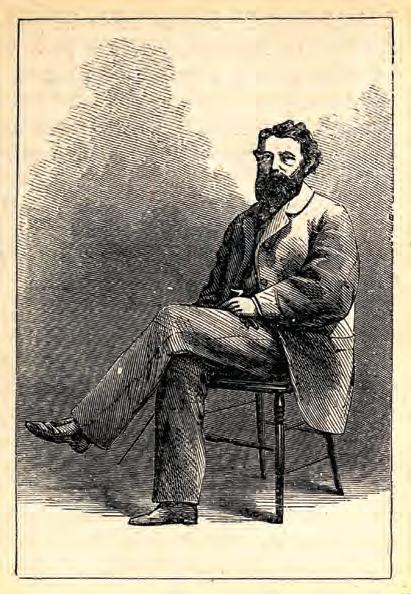
also heard Mormon elders advise women to “avoid the society of ‘Gentiles,’ as they term us.” In a September 17 letter to a friend Lieutenant Sylvester Mowry noted with amusement that Elder Heber C. Kimball had preached a sermon in which he warned soldiers to keep their “hands off” their women and warned the women to keep themselves pure. Such remonstrances by church elders were hardly unwarranted. “Brigham’s daughter-in-law is the prettiest woman I have seen yet,” a rakish Mowry wrote. “Her husband is on a mission, and she is as hot a thing as you could wish. I am going to make the attempt, and if I succeed and don’t get my head blown off by being caught shall esteem myself some.” Soon enough the lieutenant was caught up in an affair with the woman. He was not alone in his hot-blooded desires.
Alcohol was another common temptation for officers and soldiers out West. As of 1854 the Mormon religion had not wholly forbidden its use or sale. In fact, local merchants soon discovered to their delight the profit ability of selling spirits to their winter guests. Livingston wrote his father of the trade in alcohol and its deleterious effects on the ranks. “The men are very troublesome in the city, and I don’t know as we will ever get them straight,” he wrote. “I have been on a court this morning to try six cases of drunkenness, and it is a thing that is recurring all the time. The Mormons will sell the soldiers liquor, and if I was in command, I would spill every drop on the ground.”
Tensions between the Mormons and soldiers reached a boiling point in late December when a drunken troopers picked a fight with civilians in a crowded theater. Army officers immediately intervened. But on Christmas Day a donnybrook involving some 300 soldiers and Mormons broke out on the Salt Lake City streets. As Livingston recalled, after an exchange of jeers, “stones and clubs did better execution.” Shots were fired, but no one was hit. Steptoe’s officers and Mormon police quickly put a stop to the violence. Livingston pinned blame on a “desperate set of rascals infesting this city” and noted the soldiers “will not be run over if they can help it.”
In the wake of the riot the colonel ordered enlisted men confined to quarters for the remainder of the holiday season.
Officers, of course, were not confined to quarters and celebrated New Year’s Eve at a ball thrown by Young in their honor. But the damage was done. The depravity of a few soldiers had stiffened Mormon resistance to federal authority, exacerbated further in 1857 when President James Buchanan authorized a large force to invade the territory at the outset of the Utah War.
The Pahvant tribe ultimately surrendered seven men to the Mormons, and in early February 1855 soldiers escorted the Ute suspects, one of whom had brought along his wife, to Nephi City to stand trial for the murders of Gunnison and party. On the eve of the proceedings a grand jury dropped the charges against four of the men, indicting the other three. Their trial began on March 21 and lasted three days. Defense Attorney Almon Babbitt initially moved for dismissal, arguing that his clients could not be guilty of murder, as their tribe had been at war with the United States. The judge denied his motion. “There were many witnesses who went to prove the fact of their having been engaged in the affair,” Allston recalled, “but the evidence of the squaw was damning. She said that all were there and participated in the mas sacre, and that one of them…saw the party coming down to the river and told his followers, saying, ‘There come the Americans—come let us kill them.’”
Though their duty seemed clear, the members of the all-Mormon jury, in counsel with church elders, feared that a guilty verdict followed by a triple execution would lead to war with the tribe. Thus, they found the defendants guilty only of manslaughter, a non-capital offense. Sentenced to the maximum penalty of three years, the Utes were sent to the terri
WILD WEST WINTER 202358 OLIVER WENDELL HOLMES LIBRARY, PHILLIPS ACADEMY, ANDOVER, MASS. TOP: 360CITIES.NET/ALAMY STOCK PHOTO; ABOVE: UNIVERSITY OF CALIFORNIA LIBRARIES
WIWP-WINTER-2023-GUNNISON.indd 58 9/30/22 10:02 AM
torial penitentiary. Then came a fur ther affront to justice. “Within less than a week they were permitted to escape and are again at large,” reported The New York Times. “The Mormons connived at it in order to ingratiate themselves with the Indians,” a disgusted Stevenson opined of the escape, echoing the senti ments of his comrades.
At news of the unsatisfactory ver dict, the soldiers’ hostility toward the Mormons finally boiled over. Anxious to avoid stirring the Mormons’ mutual animosity, Steptoe had already turned down President Pierce’s proffered appointment to serve as territorial governor in Young’s stead. On April 29, to further defuse tensions and prevent a reprise of the Christmas day riot, the colonel quietly marched his soldiers out of Salt Lake City. They en camped at a spot along the Weber River some 35 miles north of town, where the men cooled off while the column’s stock watered, grazed and gathered strength for the onward route-finding march west.
A handful of women and girls seeking either to escape plural marriage or Mormon religious strictures, or both, accompanied the departing column. Though doubtless glad to see off the Army, Mormon leaders were anything but pleased to see soldiers carry off their womenfolk. A few boorish officers left a particularly bad impression, as Stevenson noted:
One of our officers carried a Mormon girl along with him to California. Another officer attempted to play Mormon by carrying off two sisters, but Colonel Steptoe caused him to take them back to their friends. When the officer attempted to do so, he was fired upon by the brother of the young ladies and came near being killed. Served him right!
For the march west Steptoe split his com mand. One detachment was to circle north around the Great Salt Lake, follow the Hum boldt River, then swing northwest to the Sacra mento Valley. The other was to bear southwest erly across the Mohave Desert to Fort Tejon, north of Los Angeles. Among the latter detach ment were 32 men of the 1st Dragoons, includ ing Privates Antes and Stevenson, who would record many more adventures beyond Zion.

Will Gorenfeld is the co-author, with son John Gorenfeld, of Kearny’s Dragoons Out West
For further reading he recommends At Sword’s Point, Part 1: A Documentary History of the Utah War to 1858 (Vol. 10 of Kingdom in the West: The Mormons and the American Frontier), by William P. MacKinnon; “Sex, Subalterns and Steptoe: Army Behavior, Mormon Rage and Utah War Anxieties,” also by MacKinnon, in Vol. 76, No. 3, of the Utah Historical Quarterly (2008); and “Lieutenant Sylvester Mowry’s Report on His March in 1855 From Salt Lake City to Fort Tejon,” by Lynn R. Bailey, in Vol. 7, No. 4, of Arizona and the West: A Quarterly Journal of History (1965).
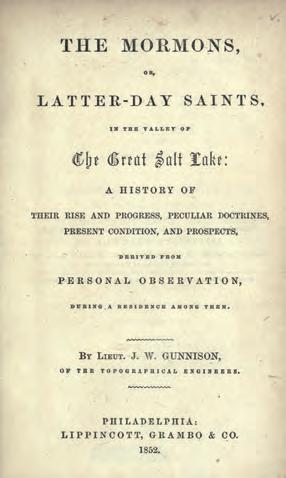
59WILD WEST WINTER 2023 OLIVER WENDELL HOLMES LIBRARY, PHILLIPS ACADEMY, ANDOVER, MASS. TOP: 360CITIES.NET/ALAMY STOCK PHOTO; ABOVE: UNIVERSITY OF CALIFORNIA LIBRARIES
Massacre Marker and Gunnison’s Book Above: The Gunnison Massacre site, southwest of Hinckley in west-central Utah’s Millard County, was listed on the National Register of Historic Places in 1976. Left: A year before his death Gunnison, who had fostered friendly relations with the Mormons, published this favorable account of their history.
WIWP-WINTER-2023-GUNNISON.indd 59 10/5/22 7:09 AM

WIWP-WINTER-2023-PEACE OFFICER.indd 60 9/30/22 10:03 AM
BY ELLEN NOTBOHM

It Happened Here Two boys pose on Main Street in Mayville, N.D., where on Sept. 3, 1893, thieves seeking alcohol to bootleg in that prohibition state killed police officer Even Paulson. Norwegian-born Paulson had arrived in the Traill County town and been granted U.S. citizenship scarcely a year earlier. A Peace Officer Murdered for Booze A NORTH DAKOTA COMMUNITY ROSE UP IN RAGE AND SORROW AS ITS NEWSPAPER CONDEMNED ‘THE MOST ATROCIOUS CRIME’ IN COUNTY HISTORY
NORTH DAKOTA STATE UNIVERSITY ARCHIVES 61WILD WEST WINTER 2023 WIWP-WINTER-2023-PEACE OFFICER.indd 61 10/5/22 7:04 AM
There is truth to the old adage “every tombstone tells a story.” Few do so as provocatively as Mayville, N.D., police officer Even Paulson’s headstone. For 129 years snow, ice, wind and moss have done their best to sully his grave marker in the town’s tidy cemetery, but not enough to obscure the gripping inscription:
EVEN PAULSON
Born Dec. 29, 1862
Killed while on duty As nightwAtchmAn At MAYVILLE, N.D.
Sept. 3, 1893 1 o’clock a.m.
To lay eyes on the chiseled epitaph is to feel the piercing depth of loss dealt to a close-knit commu nity. It’s uncommon to find the cause of death on a tombstone. In this case those few words held the genesis of their aftermath: a community’s anger, the spectacle of a sensational trial played out in the media across five states and the repercussions that would reverberate for two decades.
Paulson was 4,000 miles from his birthplace and just 30 years old when his life came to an abrupt and horrific end down a dark alley in smalltown North Dakota. Born in Seljord, a village in Telemark, Norway, he was 21 years old when he took what was likely his last look at his homeland
Trials in Traill County
William Law and James Kelly, the men charged with Paulson’s murder, were tried separately in Hillsboro, the seat of Traill County. Defense attorney Francis W. Ames’ request for a change of venue was denied. Though convicted, neither Law nor Kelly was sent to the gallows.
and his parents. Arriving in Que bec in 1884, he headed for Granite Falls, Minn., and within two years filed declaration of intention pa pers (a precursor to becoming an American citizen) in Yellow Medi cine County. By 1892 he had made his way to Traill County, N.D., where on May 13 District Judge William B. McConnell granted him citizenship.
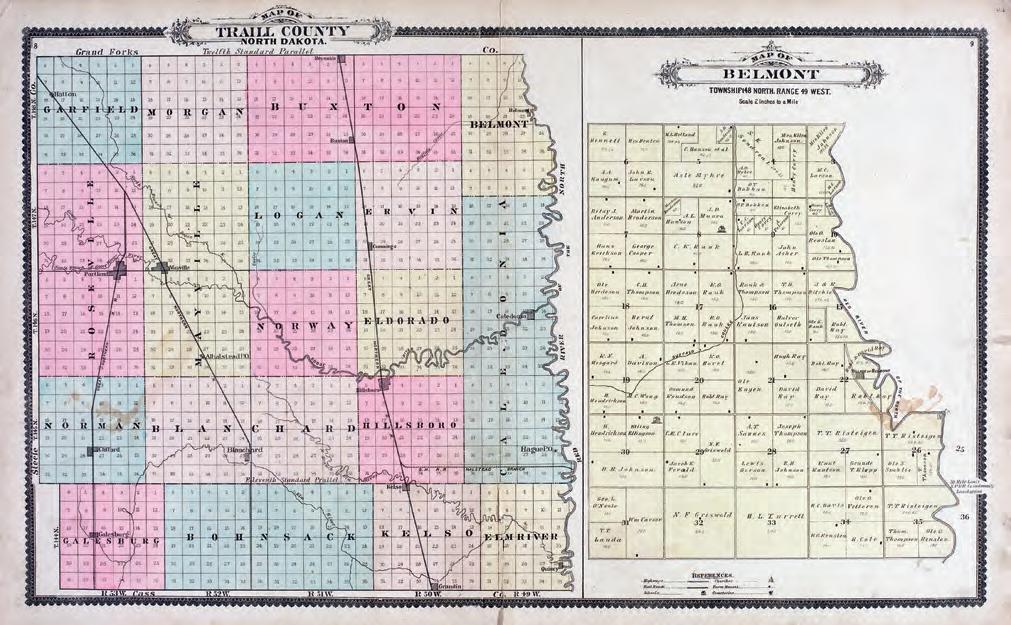
North Dakota’s 1889 entry into the Union as a prohibition state ensured there would be wild confrontations between bootleggers, speakeasy pro prietors (aka “blind piggers”), the Women’s Christian Temperance Union and lawmen sworn to uphold the state constitution, regardless of their own attitudes about alcohol. But Officer Paulson was universally trusted and immensely liked in Mayville, even by those he arrested. “His personal ity was so engaging,” writes Harold Wenaas in his 1996 book Stener: The Sheriff From Telemark, “he could talk unruly toughs and drunks into vol untarily accompanying him to the city jail.” (The author’s grandfather, Stener Wenaas, served as a deputy sheriff and sheriff of Traill County and hailed from the same small Norwegian town as Paulson.) Paulson believed policemen should be visible in their communities, thus he became a fixture on the streets of Mayville, talking to children, parents and business owners.
But a crime to which there were no eyewitnesses except the victim’s dog can only be retold second- or thirdhand, so the story of Paulson’s murder must be pieced together through the public record and from numerous newspaper accounts, splashed across front pages from Iowa to Minnesota, including at least two Norwegian-language papers.
The MosT ATrocious criMe in TrAill counTy’s hisTory
So declared the headline in the Hillsboro Banner. It all came down to booze. Shortly before 1 a.m. on Sept. 3, 1893, Officer Paulson had surprised burglars
WILD WEST WINTER 202362
LIBRARY OF CONGRESS HISTORYNET ARCHIVE
WIWP-WINTER-2023-PEACE OFFICER.indd 62 10/5/22 7:07 AM
in the act of stealing liquor to bootleg from a warehouse behind the R.L. Ken ney & Co. drugstore, whose pharmacist used alcohol in the preparation of medicines. The first shot, to the abdomen, dropped Paulson. His shouts for help carried on the night air until silenced by a second bullet, to his forehead at point-blank range. When all fell silent, Paulson’s dog remained beside the body of his fallen owner.
The killers promptly bolted, each in opposite directions. Moments later a thump against a nearby home alerted its resident, who saw a man disappear over a fence. A posse described in Wenaas’ book as “half the population of Mayville” pulled one James Kelly, either drunk or claiming to be, from the crawlspace beneath the train depot and hauled him to the city jail. The next morn ing authorities discovered the source of the thump in the night—a .44-caliber Winchester rifle traced to local butcher William Law. A search of Law’s room turned up the stolen goods in a trunk. The price of Paulson’s life —a 10-gallon cask of port wine. He’d been shot when the burglars returned in search of whiskey.
An enraged mob of 700 choked the streets. Describing the crime as “one of most unusual cruelty,” the Hillsboro Banner reported, “It was with greatest difficulty that lynching was prevented.” Cooler heads managed to quell the fury long enough for County Sheriff William K. Seaver to hold both prisoners (“two well-known town toughs,” according to the Hope Pioneer ) for a day before transporting them across the line to the Cass County Jail, in Fargo, to await trial during the next term of court at Hillsboro, the Traill County seat.
One might wonder whether Law and Kelly witnessed the funeral pro cession for Paulson, a solemn line of horse-drawn carriages that extended a mile. The Reverends George Curtiss and Jens Lonne spoke in English and Norwegian, respectively, to the largest funeral gathering Mayville had ever witnessed.
A 28-year-old Maryland native, Law had made his way to North Dakota only a few months earlier. While working as a butcher in Fargo, he’d fallen in with undesirable company and left for the smaller town of Mayville.
Kelly’s appearance suggested a rough path in life. Barely 30 years old, he was already graying and balding, with a crooked nose and a left eye noticeably larger than the right. A Massachusetts-born transient laborer, he lived in a camp just outside town and sometimes assisted butcher Law, slaughtering stock with the latter’s Winchester in exchange for cuts of meat.
Neither man denied the robbery. Both denied the murder. Law and Kelly claimed they had a third accomplice, referred to only as Murphy, whom they claimed fired the shots that killed Paulson. Despite an all-out search and a proffered reward, however, no third man ever turned up. Jim Davis, head of reference at the State Archives and Historical Research Library in Bismarck at the time this article was researched, was likewise unable to find any cred ible reference to a third party. “I doubt there ever was one,” he said. “In cases like this there’s always a ‘third party’ brought up as the actual person who did the killing, and there’s no one who can really dispute it.” Was there a faceless third man who got away with murder? Only Kelly, Law and Paulson know. A grand jury in Hillsboro returned four indictments, two each for murder and burglary. Kelly suffered a “severe hemorrhage of the lungs” while await ing trial in the Cass County jail but survived to face his day in court.
Presumed Innocent?

The presumption of innocence until proven guilty was in scarce supply in the months leading up to the trials of James Kelly and William Law. “I saw the murderers of Paulson as they were being taken to Fargo,” the Rev. Thomas Sheckler was quoted in the Bismarck Tribune, “and I can tell you they are hard-looking cus tomers.” Not that the newspapers themselves showed any inclination to maintain editorial objectivity.
Trial of Two Murderers ran the headline in at least five newspapers in four states between Jan. 17 and 20, 1894. Within days North Dakota papers reported the grand jury had returned indictments against “Lowe [sic] and Kelly, the Paulson murderers.”
Although the defense attorneys faced an uphill battle as steep as a capital A, they did try. A pretrial request for change of venue was denied, followed by a “stub born battle” between attorneys over the admissibility of Kelly’s confession as evi dence in the coroner’s inquest. “The result was inevitable,” Law remarked after his trial, “and I am glad to escape with my life.” Indeed, he and Kelly had only narrowly avoided first lynching and then capital punishment. The murder of a peace officer committed by bootleggers of Irish descent was too much to bear for the heavily Norwegian, largely tem perate community of Mayville, N.D., a prohibition state. In the wake of the trial the Mayville Tribune congratulated citi zens “for the manner in which they have aided prosecuting attorneys in getting evidence against the murderers.” The public responded by publishing a “Reso lution of Thanks” to Traill County State’s Attorney John Carmody and Hillsboro City Attorney Charles E. Leslie for their “ability, zeal and exhaustive labor” in seeing that justice was not thwarted “through the instrumentality of the law, which through its complicities and techni calities the guilty so often escape.” —E.N.

LIBRARY OF CONGRESS HISTORYNET ARCHIVE
63WILD WEST WINTER 2023
William McConnell
WIWP-WINTER-2023-PEACE OFFICER.indd 63 9/30/22 10:04 AM
As the trial dates for Kelly and Law approached, the Grand Forks Herald questioned little Hillsboro’s ability to handle the expected crush of trial watch ers and urged the Great Northern Railway to offer fare inducements that would encourage people to stay in Fargo or Grand Forks.
“The trial of the supposed mur derers will be closely watched and the outcome of which may prove beneficial or otherwise,” the pa per wrote. “A prospectus for North Dakota regarding labor for the coming year may hinge, regard ing morality, on this very case.”
A request by defense attorney Francis W. Ames (later a state senator and reporter of the North Dakota Su preme Court) for a change of venue was denied.
On Jan. 20, 1894, a trial jury was empaneled and a slate of 20 witnesses submitted for exam ination. “Although this dastardly deed has been commented on and hashed over and over again in the hotels, business places, clubs and at the homes, and opinions freely expressed,” the Herald reported, “a jury has been drawn that has not expressed themselves, but will when the proper time arrives.”
Kelly’s confession to the coroner’s inquest formed the centerpiece of his trial. He admitted to the robbery, implicated Law and the alleged third party, and claimed he wasn’t even present for the murder. Placed on the stand, he denied the coroner’s evidence and, in doing so, contradicted himself. The jury deliberated through the night before returning a verdict of guilty on January 29. “The law of this state allows the jury to fix the penalty,” The Dickinson Press wrote in its coverage of the sentencing. “They say imprisonment for life. The evidence is all circumstantial, but the public sentiment says guilty.”
Traill County State’s Attorney John Carmody (a future state Supreme Court justice) painted Law as the principal in the crime during his trial. On February 1 Carmody, the Bismarck Tribune reported, produced evidence showing Law had “threatened some days previous to the murder to blow Paulson’s brains out and produced the gun and said that gun would do it.”
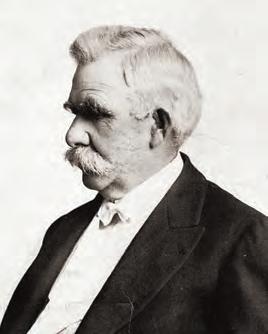

“That gun” was the Winchester. On February 9, after another overnight deliberation, the jury voted to convict.
Lack of definitive proof as to who pulled the trigger also spared Law the gallows. He, too, was sentenced to life imprisonment at the North Dakota State Penitentiary in Bismarck. Judge McConnell, who nearly two years earlier signed the papers granting Paulson his American citi zenship, pronounced sentence on the pair. “Did you hope that the jury might waver in their duty and extend an avenue of escape through sym pathy for you?” he boomed. “If so, stop and consider whether or not you showed to Even Paulson any sympathy or mercy. Did you stop to consider that he was an honorable citizen, a faithful officer and in the performance of his duty? Did you consider his father and mother in Norway and his sisters here and how your act must so cruelly wound
the love and affection they had for this son and brother? It is indeed a sad spectacle to see one of your years receive the sentence of banish ment for life, from all the objects, hopes, antici pations and pleasures of life, and to think you merit such a desperate penalty.” Law and Kelly were delivered to the state penitentiary on Feb ruary 13, duly described by the Bismarck Weekly Tribune as “evil-looking villains, whose faces were made to grace a rogue’s gallery or adorn the space behind prison bars.”
Paulson’s life had come to its end, as had the trials of his convicted murderers, but the story didn’t end there. Little more than two years later, on May 11, 1896, the Bismarck Tribune reported: “A movement is afoot to get a new trial for Lowe [sic].…K.P.’s [Knights of Pythias, to which Law be longed] are said to be interested.” Traill County’s collective temperature blew sky high in May 1899 on word that Governor Frederick B. Fancher would hear Law’s application for pardon. “They had their trial,” stormed the Hillsboro Banner , and their life sentence “was considered lenient for such red-handed murderers.” Law’s family and the Knights of Pythias pressed hard for his release. Mayville’s mayor unleashed strongly worded protests signed by “everybody” in Mayville and Hillsboro. After deliberating several weeks, Gov ernor Fancher denied the petition, declaring himself “unable to sufficient cause why I, as exec utive of this state, should interfere with the de cision of the court.” But the efforts to free Law forged on unabated.
What Kind of Man is this Man Mcconnell?
So asked the Mayville Tribune in a banner headline on Sept. 12, 1901. Palpable outrage satu rated Mayville and Hillsboro when McConnell, the judge who had presided over the trials of Paulson’s killers, but who no longer lived in North Dakota, signed a petition seeking Law’s release. The Tribune reprinted the text of McConnell’s 1894 pronouncement of sentence, tersely con cluding, “Comment is unnecessary.” The Hillsboro Banner applauded the Tribune for “dishing up a rich brown roast for ex-Judge McConnell” and urged citizens to “read it, it will do you good and help to counteract any tendency towards that morbid sentimentality which is all too common in favor of jailbirds.”
The Knights of Pythias continued its widely reported efforts, and that December 21, against sustained, strenuous resistance by the citizens of Mayville, the state Board of Pardons commuted Law’s sentence from life imprisonment to 15 years. Traill County coroner Thomas Harri
WILD WEST WINTER 202364 STATE HISTORICAL SOCIETY OF NORTH DAKOTA (2) ELLEN NOTBOHM COLLECTION
Francis Ames
John Carmody
WIWP-WINTER-2023-PEACE OFFICER.indd 64 10/5/22 7:07 AM
son released a statement blasting the board’s decision:
While there remains not a shadow of a doubt that Law was the arch crimi nal of the two, his sentence has been commuted, while Kelly, who is friend less and unknown, is still condemned to end his days in a felon’s cell. If murderers are to be pardoned be cause they have fraternal friends who persistently press the matter… the wisdom of the law creating the [pardon] board must be doubted.
Law walked free in 1907, having served little more than 13 years. Marrying shortly after his release, he ulti mately settled in Minneapolis and resumed work in the meat industry. He died in 1945, leaving nothing to suggest anything other than an unremark able post-prison life.
In December 1911 the Board of Pardons commuted the sentence of Kelly from life to 26 years, provoking the unforgiving Mayville Tribune to scath ingly suggest he “join Mr. Lowe [sic] in Minneapolis and talk over old times.” Taylor Crum, the Fargo attorney who made application for Kelly’s release, presented the situation in a more benign light. Through discussions with the warden Crum had concluded Kelly might be useful as a handyman, perhaps at a hospital, and approached a local doctor on the convict’s be half. “Unless arrangements can be made for employment,” Crum wrote the doctor, “at his age and after his long term of service, he might almost be better off to stay where he is than be sent adrift among the hobos of the Northwest.” Lifers almost always make good if allowed to stay in the local community, own up to their past and “start in right,” the attorney argued. “It would be much better for the old man than to be sent adrift looking for jobs in railroad and lumber camps…until he is invariably recognized and kicked from pillar to post. Don’t you agree?”
Kelly was released from prison in May 1912. His fate remains unknown, so for now the story ends here.
But it remains so much more than the story of an impulsive murder in the often violent and unpredictable Old West. Three young men from origins thousands of miles apart converged in the wrong place at exactly the wrong time, a coincidence of tragic pro portions for all three. It speaks to the fra gility of any random moment wherein lives are irreparably altered and history is written, immor talizing both the good and the bad that can live on after that random moment.
Oregon resident Ellen Notbohm is the author of The River by Starlight, which won a 2019 Spur Award for best first novel from Western Writers of America. This article on the Paulson murder is expanded from “A Tombstone Tells Its Story,” published in the July/August 2009 issue of Ancestry. After happening on Paulson’s grave marker and deciding to tell his story, Notbohm says, “More than a dozen researchers and organizations took an interest and dug deep for information, because, as Harold Wenaas tells us in his book Stener: The Sheriff From Telemark, ‘There was some thing special about Even Paulson.’”

An Inside Perspective
Nineteen years and four months ago in the city of Mayville, N.D., a man lost his life, and two transients were arrested, and upon circumstantial evidence they were convicted and sentenced to life in prison. After nine years one of them succeeded through his slick tongue and petting ways to the officers in gain ing a pardon, but the other, whose name we do not
feel in duty bound to use, had to stay, but after his stay of 19 years he still maintains his innocence, and on Thursday of this week he stepped out into the world a free man. Now, the question is: Who is guilty of the murder in Mayville? Was it either of these men or someone else? We are not able to say—and neither are you, so let us wish him Godspeed and give him the benefit of the doubt and believe him innocent until we are more competent to prove him guilty.
If he was an innocent man, may God have mercy upon our state law that will through its weakness con fine a man to this hellhole for 19 years, thereby taking away from him that Liberty which God himself gave to him. But if he is guilty may God have mercy upon his soul and judge him according to his merits. —E.N.
 Tombstone Tells the Tale
Paulson’s weathered grave marker in the Mayville Cemetery lists both the shocking cause and hour of his death. The funeral gathering for the well-liked officer was said to have been the largest the North Dakota town had ever seen.
Tombstone Tells the Tale
Paulson’s weathered grave marker in the Mayville Cemetery lists both the shocking cause and hour of his death. The funeral gathering for the well-liked officer was said to have been the largest the North Dakota town had ever seen.
65WILD WEST WINTER 2023 STATE HISTORICAL SOCIETY OF NORTH DAKOTA (2) ELLEN NOTBOHM COLLECTION
James Kelly’s release from prison prompted the following response in The Reflector, a paper published by inmates of the North Dakota State Penitentiary, in Bis marck (as reprinted in the Mayville Tribune, May 16, 1912):
Murderer Kelly at Liberty Slayer of Mayville Nightwatchman Goes Free
WIWP-WINTER-2023-PEACE OFFICER.indd 65 10/5/22 7:08 AM
Cost of a Cane
The walking stick supposedly given by George Hearst to Wyatt Earp for protective services rendered in Arizona Territory fetched $65,000 at auction on June 6, 2015.
The Buffalo-Bone Cane Mystery
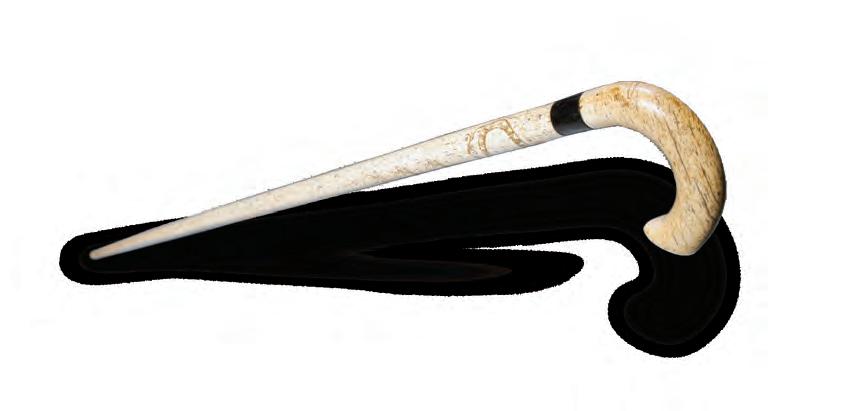
WYATT EARP PROTECTED GEORGE HEARST FROM COWBOYS, AND THE MINING MAGNATE REWARDED HIM WITH A WALKING STICK—OR DID THEY?
BY MATTHEW BERNSTEIN
Stuart N. Lake—part biographer, part con man—was looking to land a whale.
Having secured an agreement to pen Wyatt Earp’s biography, Lake managed to conduct just eight inter views with the legendary Western lawman before prostaterelated health problems did for Wyatt what gunfighters in Dodge City, Tombstone and other tough towns could not.
On Jan. 13, 1929, 80-year-old Earp died in Los Angeles. Un deterred, Lake resolved to complete the biography anyway. If he had to support the facts with rumors, half-truths and fabrications, so be it. Who would know?
In the meantime, Lake needed money. Hoping for a big score, on Aug. 31, 1929, he wrote to William Randolph Hearst, the newspaper tycoon and son of the late mining magnate George Hearst. In the letter Lake dangled a cane Hearst suppos edly gave Earp in Tombstone. The biographer’s account of how George came to present Wyatt with the cane is quite the tale.
On arriving in Tombstone in 1881 after a perilous trip through Sonora, Mexico, and Arizona Territory to assess mining prop erties, Hearst learned from an undercover Wells Fargo agent that the “Curly Bill–John Ringo gang of outlaws” had con cocted a scheme to kidnap and ransom him. For protection Hearst’s friends convinced him to have Earp—the one lawman the Cowboys feared—join him on his next excursion. When the two returned safely to Tombstone, Earp refused Hearst’s offer of money, so instead George gave Wyatt his cane. Lake wrote:
Your father had a walking stick, made of buffalo bone and hand-carved by some Indian, which he had carried for several years, ever since it had been given to him by the chief of a tribe—Sioux, I think—during a visit to the Deadwood country, in the course of which your father promised to exert his influence in behalf of certain mat ters of moment to the tribesmen. He had this stick in his hand at the time of parting from Wyatt Earp in Tomb stone and, as Wyatt himself told me on several occa sions, insisted that he accept it as a memento of their trip through the Arizona wilderness.…
Wyatt was reluctant to accept the gift, but your father climbed into the Benson stage and left the marshal stand ing in Allen Street with the stick in his hand. For the next 47 years, until his death, Wyatt Earp kept the buffalobone cane with him wherever he went.…After his death Mrs. [Josephine] Earp gave the stick to me.
Passed from a Sioux chief to George Hearst to Wyatt Earp, the buffalo-bone cane certainly had a rich history. But was it all hogwash? Could it be Lake was trying to flimflam W.R. Hearst into buying a worthless stick of no historic value? By examining the actions and whereabouts of Earp and George Hearst when both were in Arizona Territory, we can determine whether Lake’s story behind the buffalo-bone cane holds up or is the stuff dreams are made of.
BRIAN LEBEL’S OLD WEST EVENTS; OPPOSITE: GL ARCHIVE/ALAMY STOCK PHOTO
WILD WEST WINTER 202366 WIWP-WINTER-2023-EARP AND HEARST.indd 66 10/3/22 7:48 AM
A Hearst Man?
Famed lawman Wyatt Earp, according to biographer Stuart N. Lake, served as George Hearst’s bodyguard in the Tombstone environs in early 1882 when Cowboys were plotting to kidnap and ransom the mining magnate.
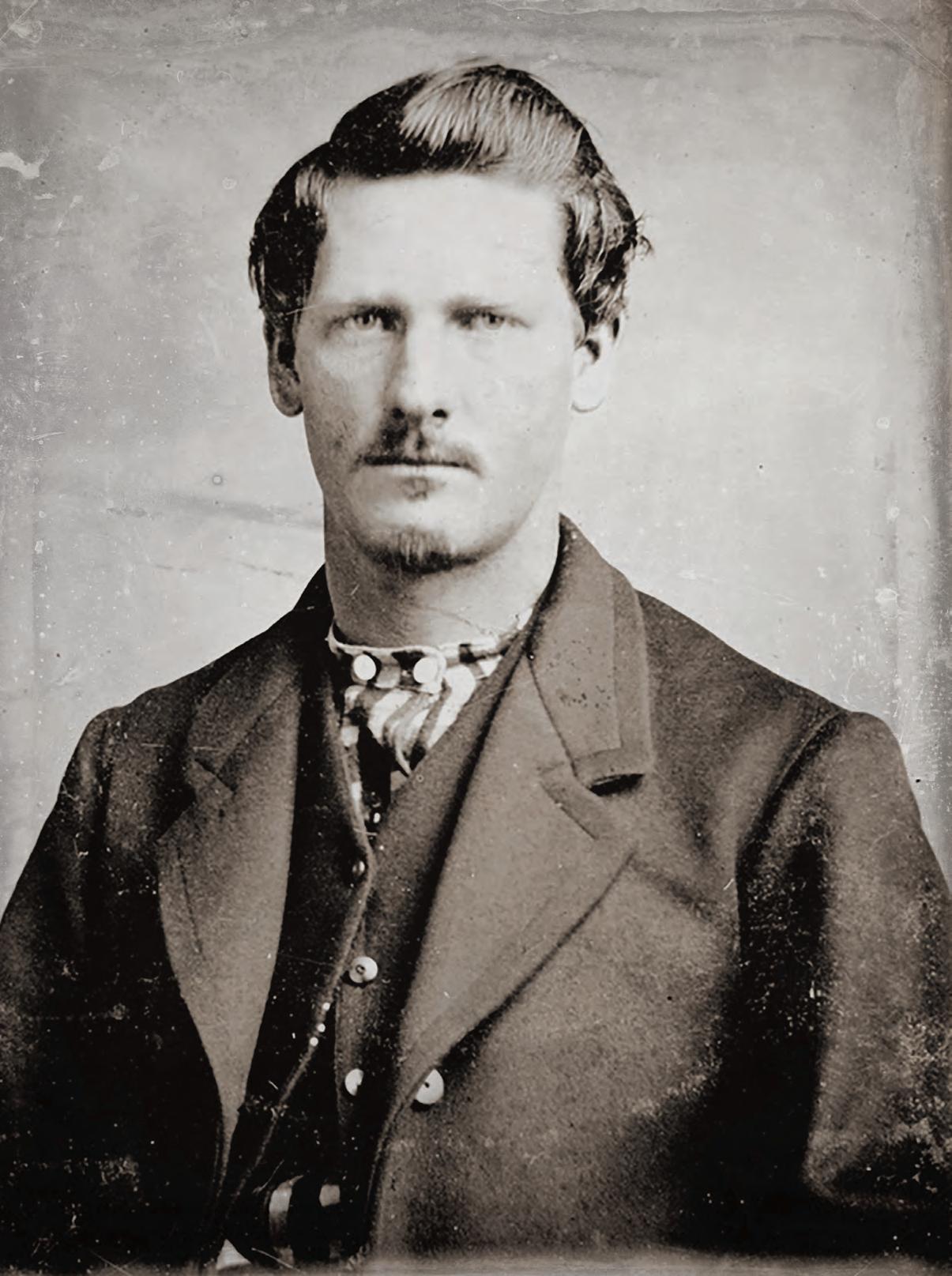
BRIAN LEBEL’S OLD WEST EVENTS; OPPOSITE: GL ARCHIVE/ALAMY STOCK PHOTO WIWP-WINTER-2023-EARP AND HEARST.indd 67 10/3/22 7:49 AM
In September 1878, feeling his oats after having acquired the richest gold mines in the Black Hills, Hearst turned his attention to the silver diggings in Arizona Territory. A year earlier Army scout turned prospector Ed Schieffelin had wandered into Apache country east of the San Pedro River in search of gold. Fellow scout Al Sieber had reportedly warned Schieffelin he’d find nothing but his tombstone. But the gamble paid off. Schieffelin struck a rich vein of silver and named his claim Tombstone after Sieber’s jest. A flood of prospectors had followed, giving rise to the namesake settlement and drawing Hearst’s attention.

Born into a slave-owning family in Missouri Territory on Sept. 3, 1820, George Hearst traded the reliable income of the family-owned farms and general store for the capricious promise of the California Gold Rush. Reaching the diggings in the fall of 1850, Hearst scrabbled about for sev eral years at various enterprises. He made his first real killing during the frigid winter of 1859–60 by driving a pack of mules laden with tons of silver the 250 miles southwest from Virginia City, Utah Territory (in present-day Nevada) to San Francisco for smelting. By the time the first shots of the Civil War rang out at Fort Sumter, S.C., Hearst was a millionaire. Given his almost oracular mining successes, Hearst helped accelerate the rush to Tombstone merely by showing interest.
Wyatt Earp was among the silver seekers who took notice.
Opportunity in Arizona Territory
On Feb. 4, 1880, Hearst checked into Tucson’s Cosmopolitan Hotel (left). From there he went to Sonora, Mexico, to purchase a land grant up near Tombstone. On it he laid railroad tracks, started a ranch and built up the Contention mine (bottom).


Born in Monmouth, Ill., on March 19, 1848, Earp had followed a meandering path to law en forcement stints in Lamar, Mo., and Wichita and Dodge City, Kan. Having largely tamed the latter cow town by the fall of 1879, Wyatt swallowed the lure of El Dorado and headed for Tombstone. Earp and traveling companions—Wyatt’s common-law wife Mattie Blaylock, his brother James and Jim’s wife, Bessie, and her children—may have raised eyebrows when they stopped en route in Las Vegas, New Mexico Territory, to seek out John Henry “Doc” Holliday and Doc’s common-law wife, “BigNose” Kate Horony. After all, Doc had killed can tankerous Army scout Mike Gordon in a local saloon that July, and the safest way to not pro voke the tubercular gambler was to stay the hell away from him. But Wyatt counted Doc as one of his truest friends, and together they traveled to Arizona Territory. In Prescott they added Wyatt’s brother Virgil and his common-law wife, Allie, to their party, which reached Tombstone in the closing weeks of 1879.
Wyatt’s projected moneymaking enterprise was a bust. “I intended to start a stage line when I first started out from Dodge City,” he recalled. But two lines were already operating in Tomb stone, so he sold his outfit. By July 1880 he was working as a shotgun messenger for Wells Fargo. He was still guarding the stages that ran between Tombstone and Benson when Hearst appeared in Arizona Territory.
On Feb. 4, 1880, Hearst checked into Tucson’s Cosmopolitan Hotel. In May he ventured to So nora, Mexico. There Hearst met with the Elias
TOP AND BOTTOM: ARIZONA STATE LIBRARY; LEFT: UC BERKELEY, BANCROFT LIBRARY ABOVE: HISTORYNET ARCHIVE; RIGHT: ARIZONA STATE LIBRARY
George Hearst
WIWP-WINTER-2023-EARP AND HEARST.indd 68 9/30/22 10:07 AM
family and purchased from them the Boquillas land grant, some 10 miles northwest of Tombstone, which included the Contention silver mine.
On June 12 Hearst was in Harshaw, Arizona Territory, within 10 miles of the southern border, where he acquired and began improving an old Mexican property colloquially known as “the Trench.” Although a dearth of lumber forced a temporary halt to construction, the Trench soon boasted a 40-foot tunnel and a shaft plunging 106 feet. From there Hearst traveled on 50 miles northeast to the Boquillas grant. Some of the land he sold, while on the most promising sections he began work on a railroad, started a cattle ranch and built up the Contention mine.
On July 18 Hearst sent an update from Tucson to business partner James Ben Ali Haggin. “I have done more and accomplished less, so far than I would like,” he wrote. “I assure you this is the hardest place to accomplish anything I have ever met.” Hearst was soon back in San Francisco.
Although it is conceivable that between Feb. 4 and July 18, 1880, Hearst may have ridden in a Wells Fargo stagecoach with Earp as his protector— potentially forging a lasting friendship—no such connection can be found in contemporary letters, diaries, or newspaper accounts. Newspapermen would have been especially keen to spot Wyatt speaking with the mining magnate during Hearst’s visit to Ari zona Territory late the following year, for in the interim Earp would eclipse Hearst as the most talked-about man in the territory.
Stepping off a train at the Tombstone depot late on Christmas Day 1881, Hearst found a different town than the one he’d left. Fear rather than festivity pervaded the air.
The tensions revolved around an ongoing bloody feud between the Earps and a band of rustlers and kill ers known as the Cowboys. Under the nebulous leader ship of gunmen Curly Bill Brocius and Johnny Ringo, the Cowboys particularly chafed at a new ordinance that prohibited the carrying of firearms within town limits. Enforcing the ban were Wyatt and brothers—once again lawmen. Virgil was the city marshal (police chief), Wyatt and younger brother Morgan his assistant marshals. Although Doc didn’t wear a star, on October 26 he’d backed the Earps in a gunfight behind the O.K. Corral that had claimed the lives of three Cowboys—Billy Clanton and brothers Tom and Frank McLaury. Virgil and Morgan had been shot, Doc grazed. Wyatt, miraculously, was unhurt.
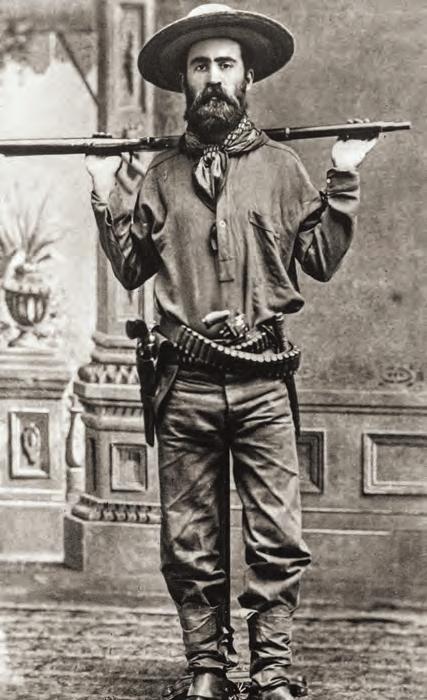
Hearst, a pragmatist who had taken a neutral stance during the Civil War, wanted nothing to do with the dispute. Three days after his return to Tombstone, the feud hit another flash point. At 11:30 p.m. on December 28 Virgil was ambushed outside the Oriental Saloon. Though his left arm was shattered by buckshot, the city marshal survived.
George W. Parsons, who befriended the Earps in Tombstone and later served as one of Wyatt’s pallbearers, noted Hearst’s Jan. 3, 1882, return to town on the evening stagecoach. “Met George Hearst this morning and had quite a talk,” Parsons wrote in his journal the next day. “He seems to like the camp.”

Parsons recorded Hearst’s continued presence in camp on a “cold and frightfully windy” Friday, January 13. Despite the wind and ice, Hearst was planning to head up into the Dragoon Mountains, some 15 miles to the northeast. Given the ever-present threat of highwaymen and Apaches, Hearst needed the services of a gunhand who knew the lay of the land. If Hearst considered hiring Wyatt, he soon dismissed the notion. Instead, he tapped another Tombstone man who fit the bill—John Henry Jackson.
Born in Ontario, Canada, on April 18, 1840, Jackson had arrived in Tombstone in the spring of 1879. He and sister Francis shared an adobe house on Bruce Street and had an interest in the Omega claim. After converting a leased livery stable on Allen Street into a boardinghouse and restaurant, he’d purchased city attorney Marcus P. Hayne’s ranch in Cochise Pass and other inter ests in the Dragoons. To Hearst’s purposes, the 41-year-old had a commanding presence and an intimate knowledge of the mountains.
On the morning of January 14 Hearst, Jackson and a party of four others left Tombstone by stage coach. After examining the Defiance mine, Jack son, Hearst and Hiram M. French saddled three horses from the team and rode to the more re mote Dragoon, Black Jack, Hidden Treasure, Star, Lake Superior and Elgin mines. Returning to the stagecoach, they hitched their horses and, tired and hungry, drove the team back to Tomb stone, dining at the popular Fourth Street restau rant Jakey’s. “Hearst was very favorably impressed with the mines,” the Tombstone Epitaph wrote. “We trust that his favorable report upon his return
TOP AND BOTTOM: ARIZONA STATE LIBRARY; LEFT: UC BERKELEY, BANCROFT LIBRARY ABOVE: HISTORYNET ARCHIVE; RIGHT: ARIZONA STATE LIBRARY
A Hearst Defender and an Earp Friend Left: Canadian-born John Henry Jackson had a commanding presence and really did serve Hearst as a bodyguard. Above: Wyatt’s pal George W. Parsons journaled about an 1882 Hearst visit to Tombstone.
69WILD WEST WINTER 2023 WIWP-WINTER-2023-EARP AND HEARST.indd 69 9/30/22 10:07 AM
to San Francisco will set the great mining operators of the Pacific Coast to thinking that, after all, Arizona is worth looking after a little.”
On January 16, amid a snowy mix, Hearst purchased a stake in the Contact mine for an initial $5,000; $10,000 more soon followed, and Hearst would expend another $6,000 to develop it.
Although it didn’t snow the next day, Parsons recorded there was “much blood in the air this afternoon. Ringo and Doc Holliday came nearly having it with pistols.…Bad time expected with the Cowboy leader and D.H. I passed both, not knowing blood was up. One with hand in breast pocket, and the other probably ready. Earps just beyond.”
Before either man could draw, Officer Jim Flynn pulled Ringo away, while Wyatt strongarmed Doc in the opposite direction.
In his 1931 biography Wyatt Earp: Frontier Marshal Lake claimed Wyatt rode out from Tombstone with Hearst the day after the Doc–Ringo scrape:
The Curly Bill gang was plotting to kidnap United States Senator George Hearst, then on inspection of Cochise County mining properties, and to hold the capitalist for ransom. Senator Hearst, however, insisted on making his trip, so the [Tombstone] Safety Committee asked Wyatt to accom pany him. With Wyatt, Hearst spent a week riding and camping in the mountains and desert without molestation.
If Lake is to be believed, Hearst and Wyatt were inspecting mining properties between January 18 and 25. But, according to the Tomb stone Weekly Epitaph , Hearst left town on January 22 in the company of Jackson and George A. Berry. Their destination was the Winchester Mountains, some 50 miles to the north. Wyatt left Tombstone a day later in the company of Doc, Morgan and five other men. Each was conspicuously armed with a Winchester rifle, a shotgun and two pistols. Wyatt carried a warrant for the three Cowboys—Pony Diehl and brothers Ike and Phin Clanton—he held responsible for Virgil’s shooting.
Daunting Dragoons
In January 1882 Jackson guided Hearst and Hiram M. French on horseback through these mountains in Cochise County to examine a half dozen mines, and Hearst was reportedly “favorably impressed.”

Lake’s timing was off. It’s also hard to imagine Hearst would have wanted to place himself amid the feud by standing anywhere near Wyatt. That Lake repeatedly refers to Hearst as “Senator,” though Hearst wasn’t appointed to the Senate until 1886, makes the claim even more suspect.
Jackson was back in Tombstone on January 24, organizing a separate posse to ride out and arrest Ringo. A week later Hearst left for Mexico. While the citizens of Tombstone held their breath, await ing the next dustup between the Earps and the Cowboys, disturbing news came in from Sonora: George Hearst had been murdered.
On February 13 a Mexican rode into Tombstone telling a wild story. While making their way along a tributary of the Sonora River north of Arizpe, 100 miles south of Tombstone, Hearst and party had been massacred by Indians. News of Hearst’s death spread like wildfire and was telegraphed to his partners Haggin and Lloyd Tevis in San Francisco.
Addison E. Head, a friend of Hearst’s from their days prospecting Nevada silver, was aghast, but for a different reason. He was in telegraphic con tact with the wandering magnate, who was very much alive. When Hearst returned to Tombstone on February 19, speculation abounded the Mexi can had conjured the rumored massacre from the bottom of a bottle of mescal. A few days later Hearst left by train for Los Angeles. William Pinkerton, a scion of the Pinkerton National Detective Agency, was also aboard. It does not appear the detective was there to keep an eye on Hearst—but with the crafty Pinkertons, you never knew.
WILD WEST WINTER 202370 DIFFERENT_BRIAN/GETTY IMAGES JONATHAN WALKER/GETTY IMAGES
That Lake repeatedly refers to Hearst as ‘Senator,’ though Hearst wasn’t appointed to the Senate until 1886, makes the claim even more suspect
WIWP-WINTER-2023-EARP AND HEARST.indd 70 9/30/22 10:08 AM
In spring of 1882 the Earp–Cowboy feud reached its bloody crescendo.
On March 18 Morgan was shot dead by a Cowboy assassin while shooting pool in the Campbell & Hatch Billiard Parlor as Wyatt stood by helplessly. Two days later Wyatt, who weeks earlier had been appointed a deputy U.S. marshal, gunned down Frank Stilwell near the Southern Pacific depot in Tucson, an act of vengeance that kicked off what historians call the “Earp Vendetta Ride.” To avenge Morgan, Wyatt had formed a posse com posed of men from both sides of the law. Considering Wyatt a rogue agent, Arizona Territory Governor Frederick A. Tritle directed Cochise County Sheriff Johnny Behan to bring Earp to justice.

Around 11:15 on the morning of March 22, Wyatt, Doc, Sherman Mc Master, and “Turkey Creek” Johnson caught up with Florentino Cruz, who was chopping wood in a camp below the South Pass of the Dragoon Mountains. The next day Cruz’s body was found with four bullet wounds, including one to his right temple.
On March 24 Earp finally shot it out with Curly Bill. Wyatt had been hoping to get the drop on the Cowboys at Iron Springs (present-day Mescal Spring) but was outnumbered and surprised from ambush. This time the posse comprised Wyatt, Doc, McMaster, “Texas Jack” Vermillion, Jack Johnson and Wyatt’s youngest brother, Warren. Arrayed against them were Curly Bill, Milt Hicks, Johnny Barnes and a half dozen other Cowboys. Despite the odds and Curly Bill’s gun skills, Wyatt put a shotgun blast through Curly Bill’s chest. He then drew his pistol, shooting Hicks in the arm and Barnes through the chest. With Curly Bill and Barnes dead, and the Earp posse having suffered only one casualty—Texas Jack’s horse— the remaining Cowboys fled.
When Hearst returned to Tombstone the first week of April, he needed a bodyguard more than ever. Jackson was unavailable, however. Appointed a deputy U.S. marshal in the Earps’ stead, he’d been ordered by Governor Tritle to raise another posse to bring in Wyatt and party.
Hearst had other ideas.
Accepting Hearst’s offer, Jackson guided Hearst and Head some 120 miles east into New Mexico Territory’s Victorio Mountains. This was wild country, inhabited by Mexican gray wolves, mountain lions and grizzly bears. Undaunted, Hearst and Head established an expansive cattle ranch in Deming, 20 miles beyond the mountains, purchasing for $12,000 former Texas Ranger Michael Gray’s 1,000-acre property, which two years earlier Gray had paid squatter Curly Bill $300 to vacate. This acquisition, ulti mately renamed the Diamond A Ranch, marked the beginning of Hearst’s New Mexican cattle barony.
On April 15 Wyatt, Doc and the others arrived in Silver City, New Mexico Territory, 45 miles northwest of Deming. The next day they sold their horses and boarded a Deming-bound stagecoach. By the time the Earp party reached that dusty New Mexico Territory town, Hearst, Head and Jackson had returned west. Hearst reached Tombstone on April 23, while Wyatt boarded a train north for Albuquerque. From there Earp drifted to Colo rado, Idaho and California, then north to Alaska before settling in Los Angeles for keeps. His final resting place is beneath a tombstone at the Hills of Eternity Memorial Park in Colma, south of San Francisco, within 1,000 feet of George Hearst’s family mausoleum.
So, did Hearst give Earp the cane? It doesn’t seem likely. As Lake tells it, Hearst acquired the cane in Deadwood after having brokered a deal on behalf of a Sioux chief, but there is no evidence he had any such dealings with Indians in the Black Hills. The same goes for the supposed Cowboy plot to abduct him. Most telling, the dates don’t add up.
Walking stick aside, Hearst delivered Earp an even greater gift. By retaining the services of Jackson in the spring of 1882, he inadvertently made certain that formidable marshal spent the last days of the Earp Vendetta Ride protecting Hearst rather than chasing Wyatt.
As for the cane itself, it kicked around for de cades before turning up at one of Brian Lebel’s Old West Auctions at the Will Rogers Memorial Center in Fort Worth, Texas. Both Lake’s type written letter and the cane were authenticated— as much as they could be—and on June 6, 2015, they were auctioned off. Starting at $20,000, the lot hammered down at $65,000. Whether or not the cane ever belonged to George Hearst or Wyatt Earp, the surrounding mythology made it worth its weight in gold.
Matthew Bernstein teaches at Matrix for Success Academy and Los Angeles City College and is the author of George Hearst: Silver King of the Gilded Age. For further reading he recommends The Dragoon Mountains, by Lynn R. Bailey; Wyatt Earp: The Life Behind the Legend, by Casey Tefertiller; and Ride the Devil’s Herd: Wyatt Earp’s Epic Battle Against the West’s Biggest Outlaw Gang, by John Boessenecker.
71WILD WEST WINTER 2023 DIFFERENT_BRIAN/GETTY IMAGES JONATHAN WALKER/GETTY IMAGES
The Rest of the Story Wyatt’s final resting place is with wife Josephine at the Hills of Eternity Memorial Park in Colma, south of San Francisco, within 1,000 feet of George Hearst’s family mausoleum. Whether or not Lake’s cane story is true, Wyatt and Hearst did later associate in Los Angeles.
WIWP-WINTER-2023-EARP AND HEARST.indd 71 9/30/22 10:08 AM
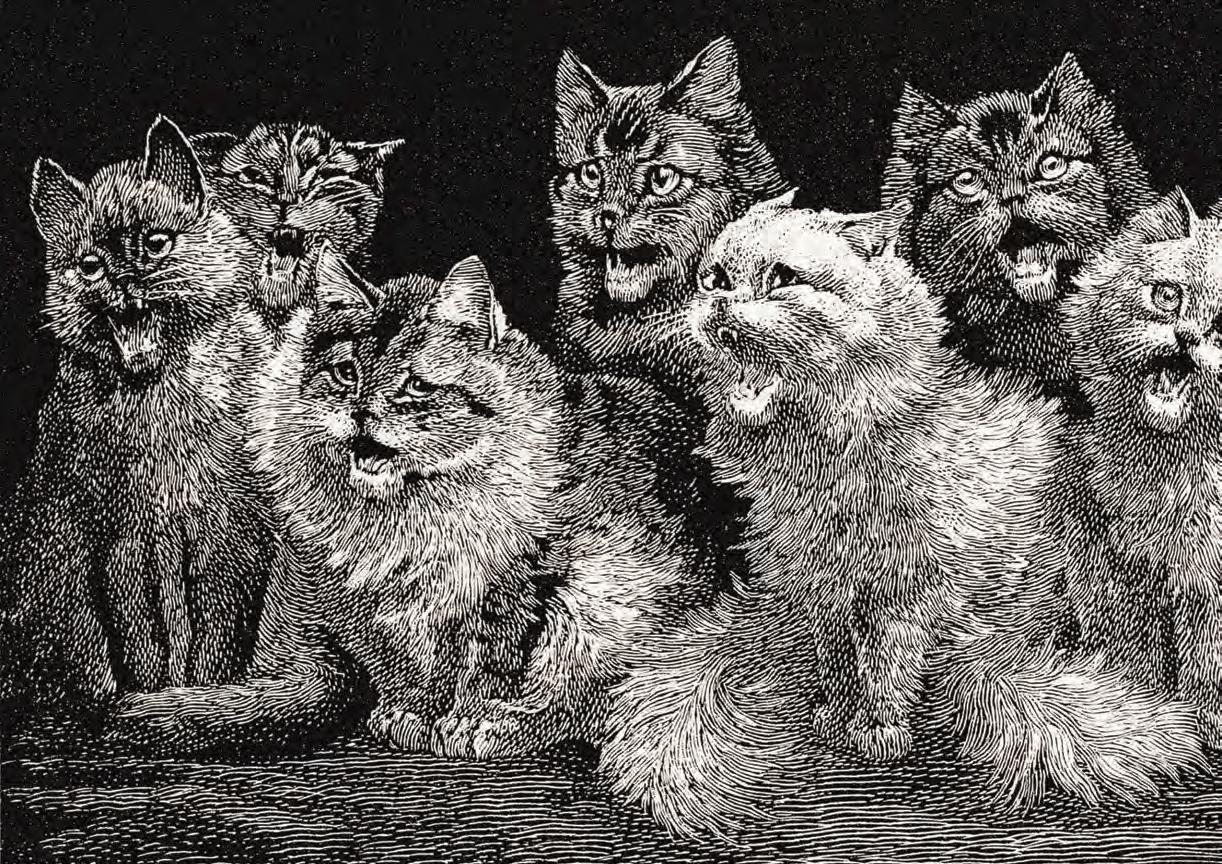
WILD WEST WINTER 202372 There’ll Be a inCaterwauling the Old Town Tonight WHEN THE WEST WAS WILD, FERAL CATS RAISED FAR MORE OF A NOCTURNAL RUCKUS THAN DID THE SALOON CROWD BY PRESTON LEWIS DOVER PUBLICATIONS WIWP-WINTER-2023-CATS OF THE WEST.indd 72 9/30/22 10:09 AM
As disturbers of the peace, neither celebrating cowboys nor duel ing gunmen could hold a candle to the feral cats that roamed the streets and disrupted the dreams of folks in mining towns, cow towns and other settlements across the Old West. Meowing, trilling, hissing, growling, snarling, grunting, screeching and wailing at all hours of the night, such roving felines were to nighttime tranquility what dynamite was to solid rock. If period accounts are any indication, for all the good cats may have done in reducing rodent populations, the benefit came at a long-term cost to citizens’ slumber.
Editors and readers alike complained in print of the interminable feline fandangos that shattered the after-hours quietude craved by frontier saints and sinners. The caterwauling came from perches as varied as fences, roofs, bushes, wagons, front porches and the neighbor’s yard, invariably when residents were settling in for a long night’s sleep.
“The cats have been troubling us considerably of late,” Nevada journalist and diarist Alfred Doten wrote of a May 1874 evening in Gold Hill, “every night holding caucuses on the back porch and making a hideous noise, so that I had to raid out at them with oyster cans and beer bottles two or three times a night.”
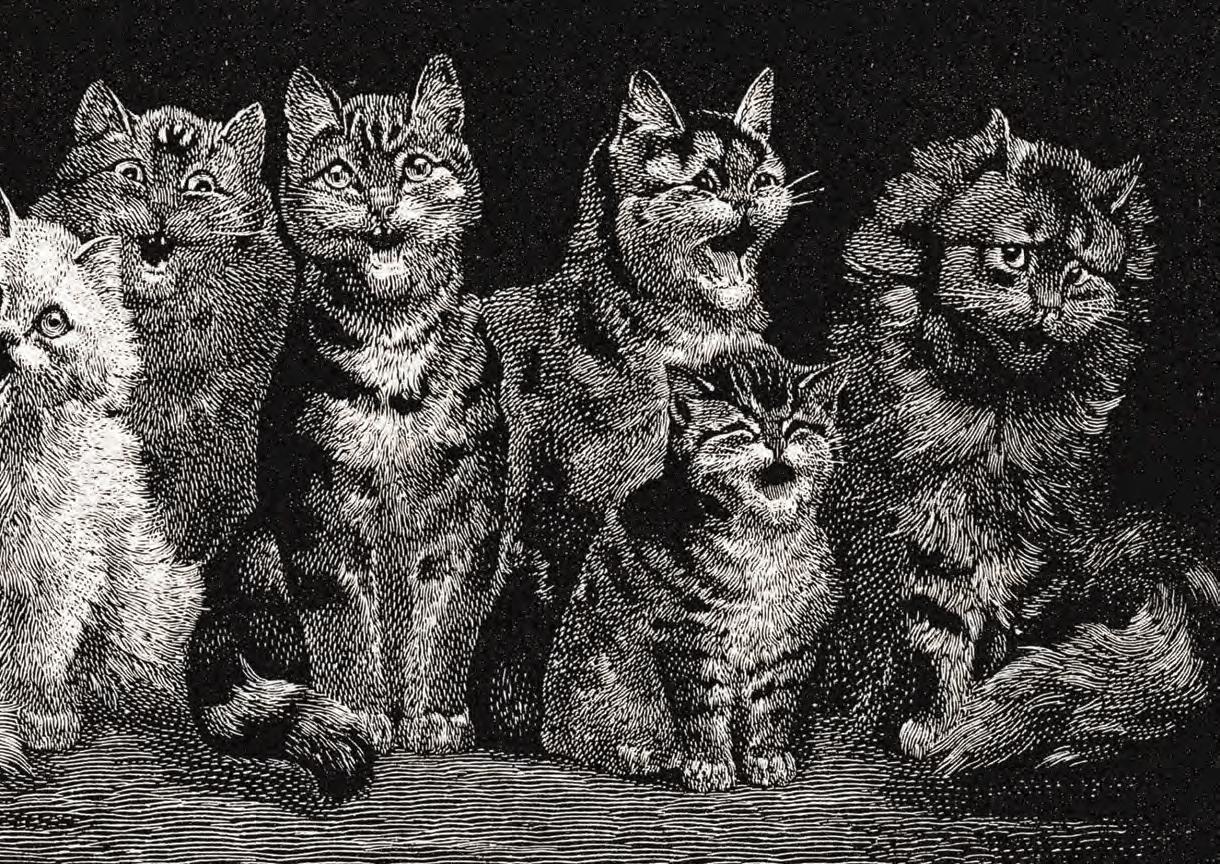
The complaints came in from far and wide. “The cat shooting season will commence shortly in this place if the brutes don’t make less noise of nights,” vowed a sleep-deprived editor in Eureka, Kan., in the summer of 1869. “A fellow isn’t half so much bothered by the dog days as he is by the cat nights,” wrote a wag in Fulton, Mo., in September 1878. “Musical concerts by Thomas cats are becoming common these moonshiny nights,” quipped a
Cat-cophony
Texan in the Brenham Weekly Banner in May 1877. “A cat is not as large as a steam piano,” observed The Kansas City Evening Star in September 1881, “but it can make more noise when fully aroused.” That lesson became all too apparent one starcrossed night in August 1891 when boarders at the Windsor Hotel in Anaconda, Mont., “had their peaceful nocturnal slumbers aroused by the unearthly squalling of a cat.”
Portland’s Morning Oregonian likened the melodies of “a thousand amorous John Thomas cats” to the city’s Chinese theaters, “[making] night hideous with banging of gongs and with songs in a falsetto key.” Addressing the ceaseless urban cacophony in an 1874 editorial, The New North-West of Deer Lodge, Mont., summed up the situation: “The American people are a patient race; but there is a place where they draw a line. It is at abnormally vociferous cats.”
WILD WEST WINTER 2023 73
DOVER PUBLICATIONS
Western editors and readers alike complained in print about the way cats carried on, especially at night when the feline meowing, trilling, hissing, growling, snarling, screeching and wailing kept the good townsfolk awake.
WIWP-WINTER-2023-CATS OF THE WEST.indd 73 9/30/22 10:09 AM
In February 1878 the rare appearance of a two-headed kitten in Guthrie County, Iowa, made the news some 300 miles south in Eureka, Kan., whose Herald observed, “When a man sits down and reflects that the next generation of cats may possess double the facilities for making nocturnal noises that their fathers have, it is enough to destroy all the theological theories of the age.”
The San Francisco Chronicle raised the alarm in the spring of 1889 when an unnamed municipality in Iowa shipped unwanted cats west to the Dakotas. “Three carloads of cats!” the paper mused. “Only imagine the concentration of cussedness which that implies. Fancy the moonlight serenades on the back fences and shed roofs, the number of flying boot jacks and soap dishes, and the amount of Dakotan swear words which are latent in three carloads of cats.”
An 1893 editorial in Kansas’ Coffeyville Weekly Journal feigned sym pathy for the plight of the feline. “The cat is a fine musician,” it noted. “As a midnight serenader he attracts more attention than a mandolin club, quartette or string band. He never fails to receive an encore, generally consisting of bootjacks, stove legs, brick bats and anything else that may happen to be handy.” The Emporia Daily News concurred, noting, “George Washington was so fond of cats that he would get up in the middle of the night to throw a bootjack at them.”
While it appears the bootjack (a V-shaped wooden wedge used to remove one’s own boots) was the weapon of choice to hurl at wailing, cantankerous cats, it was far from the only anti-feline missile employed. “Every adult cat has had more costly articles thrown at it than any opera singer that ever lived,” The Arizona Daily Star observed in 1882, “for when a man’s state of mind becomes such that he gets out of bed to serve his country in this cause, the first article he touches is the thing that goes, whether it be a coal scuttle, an ivory-backed hairbrush or a diamond bracelet. Man has the right of this conflict, and he will surely win if he lives long enough.”
Frontier folks threw so many items at cats that clever youngsters learned to profit from it. According to reports from Iowa, one boy who’d learned to imitate a cat’s meow would visit neigh bors’ yards at night, start caterwauling and then collect and sell anything worthwhile thrown at him. A boy in Utah tried something similar with promising results—that is, until he got “a load of bird shot from a double-barreled shotgun.”
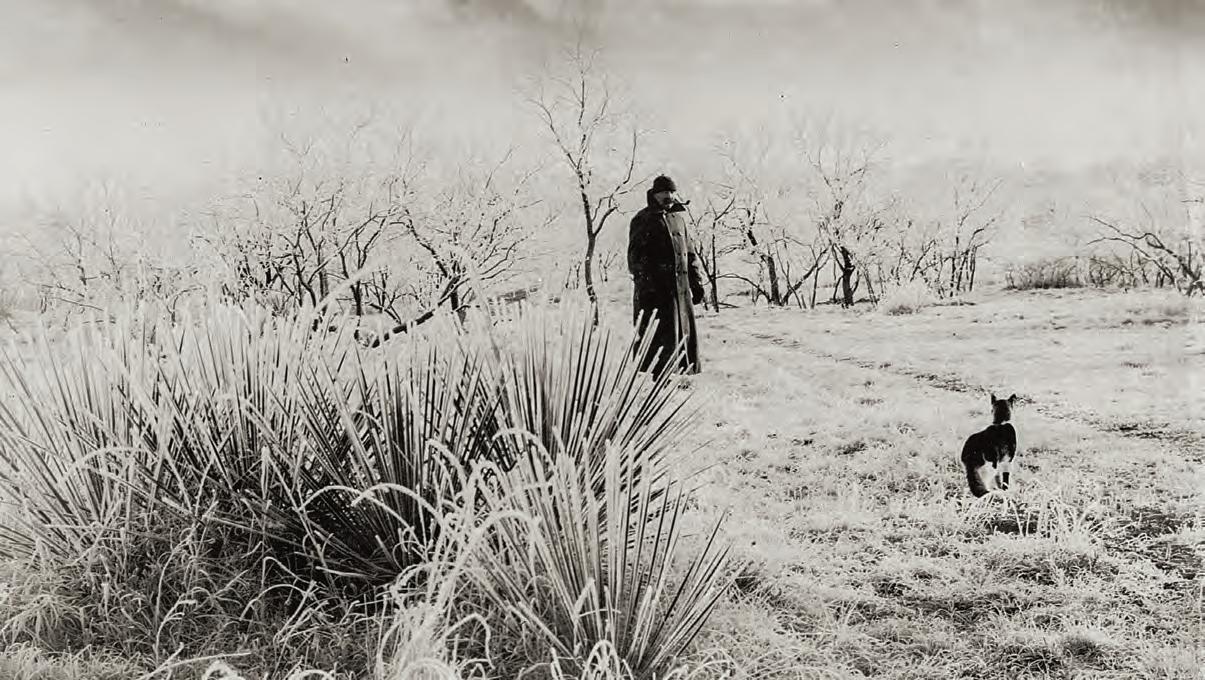
Such was his desperation for a full night’s sleep that Comstock Lode journalist and satirist Dan De Quille conceived a bootjack packed with dyna mite that “explodes as soon as it hits the ground and annihilates the cat.” Never mind that his ex plosive epiphany came on the heels of a devastat ing 1875 fire that ravaged Virginia City, destroying 2,000 buildings and mining properties valued at upward of $10 million . Terrible as the fire had been, the St. Louis Daily Globe-Democrat sug gested Comstock denizens had reason enough to be thankful. “There’s a silver lining in the Virginia City cloud in the fact that from 15,000 to 20,000 prowling pussycats are estimated to have gone up in the flames of the recent conflagration.”
While it was the ravages of fire that decimated the cats of Virginia City, elsewhere in the West the nocturnal crooners were more likely to be shot, clubbed, lynched or drowned alive. Like outlaws and coyotes, cats even had bounties placed on their heads. “Speaking of the grand and beneficent results of science,” the Newton Kansan reported in 1888, “the senior pharmacists
WILD WEST WINTER 202374
A Man and His Cat Actually, the collarless calico here may not belong to this fellow out walking on a cold West Texas day around the turn of the 19th century. Judging by period reports from the frontier West, folks were just as happy if country cats didn’t come to town.
COURTESY WEST TEXAS COLLECTION, ANGELO STATE UNIVERSITY LEFT: COURTESY WEST TEXAS COLLECTION, ANGELO STATE UNIVERSITY; RIGHT: LIBRARY OF CONGRESS WIWP-WINTER-2023-CATS OF THE WEST.indd 74 9/30/22 1:19 PM
of the Kansas university are offering 15 cents for cats, dead or alive.”
In 1875 south-central Nebraska’s Red Cloud Chief hailed a resident of Beatrice, four counties to the east, who “shot 118 cats in three minutes by the light of the silver moon.” An 1886 edition of The San Saba News praised the unknown persons who had shot some of that central Texas commu nity’s stray dogs and noted, “If they would kill about a hundred cats, while they had their hands in, they would receive the gratitude of a longsuffering public.” In February 1894 Arizona Terri tory’s Tombstone Weekly Epitaph reported a step in that direction. “Two shots fired in rapid succes sion early this morning on Fremont Street,” the paper wrote, “resulted in the ninth death of a big black cat whose melodious voice had kept the neighborhood awake the greater part of the night.”
A May 1877 report out of Lawrence, Kan., told of a “champion cat-destroying angel” that over the past 10 days had “made 38 full-grown cats bite the dust, and that, too, without the aid of shotgun or poison.” The “angel” in question would catch cats by the tail, then cruelly bash them against a tree, a fence or a wall. “With three cheers, a swing and a tiger, pussy is no more,” the Daily Journal bluntly reported. But even sleepless townspeople had humane limits. In March 1894 officials in San Francisco arrested one John “Judy” John son, 13, and Arthur “Fishy” Whiting, 15, “whose studies run mostly to dime novels and the soulharrowing order of drama,” for having lynched a number of cats—though their slaying of a dog was what may have landed them in jail.
Newspapers could be faulted for such slips in civility. The editors of various Kansas newspapers, for instance, put forth equally barbaric solutions to the cat-astrophe. One suggested administering a half pound of shot to “sympathetic cats,” which would “bear fruit in increased hours of slumber.”
Another held to the credo, “If your dog goes mad, kill your cat.” Perhaps the most heartless proposed “amputation of the tail just back of the ears.” Others looked to agriculture for a remedy. “Now is a good time to plant cats,” editorialized one paper in the summer of 1872. “The cats should be prepared with a club, revolver or some other farming utensil and then planted under a peach tree. If you have not got a peach tree, plant any where. Plant as many as you can, and plant deep. This branch of agriculture is much neglected.” In 1888 the Abilene Daily Reflector proposed plant ing a cat with every new tree so western Kansas could grow forests. “If the cats hold out, 20 years from now where buffalo grass and prairie dogs exist will be huge forests and logging camps.”
More humane was the enterprising Oklahoma newspaperman who, on learning of a $10 reward for the return of a lost cat in a neighboring city, wrote, “Let us send over a thousand or two—it may be in the lot.”
But such restraint proved the exception rather than the rule. A newspaper in California, for exam ple, offered the story of a man who entered a gun shop and was offered a six-shooter. “Better make it a nine-shooter,” he replied. “I want to kill a cat.”
Animosity toward cats persisted far past the frontier days and nights, mostly because the fe lines refused to shut up, especially after dark. The universal disgust with their nighttime antics was perhaps best summed up by a young lad who had raised cats for a time before expressing misgivings to his mother. “Mama,” he said, “I hope the next cat I have will be a dog.”
Texas author Preston Lewis, a past president of Western Writers of America, is an award-winning author of more than 40 books. For further reading see his Cat Tales of the Old West: Poems, Puns & Perspectives on Frontier Felines.
Cats Should Be Seen... Above left: This 1890s cat seems content on the bed of a little girl who may be praying her pet purrs but otherwise remains quiet all night. Above right: An early 1900s cat perched on the upper log of a cabin in Washington state poses with a woman at a spinning wheel and a watchful dog.


WILD WEST WINTER 2023 75
‘The cats should be prepared with a club, revolver or some other farming utensil and then planted under a peach tree’
COURTESY WEST TEXAS COLLECTION, ANGELO STATE UNIVERSITY LEFT: COURTESY WEST TEXAS COLLECTION, ANGELO STATE UNIVERSITY; RIGHT: LIBRARY OF CONGRESS WIWP-WINTER-2023-CATS OF THE WEST.indd 75 9/30/22 1:19 PM
Where Lonesome Dove Came to Roost
BY LINDA WOMMACK
The Wittliff Collections, on the campus of Texas State University, San Marcos, include the production archives, artifacts and costumes of Lonesome Dove, arguably the most popular Western television mini series ever filmed. Screenwriter William D. “Bill” Wittliff donated his own keepsakes and convinced others among the cast and crew to do likewise, including actors Robert Du vall and Anjelica Huston, production designer Cary White, costume designer Van Broughton Ramsey and composer Basil Poledouris. The result is a unique archival treasury that cap tures all aspects of production on the miniseries.

Lonesome Dove came to fruition after a chance meeting between Motown Productions president Suzanne de Passe and author Larry McMurtry in which de Passe asked Mc Murtry about his current writing project. McMurtry sent a manuscript of the unpublished Western novel to de Passe,
who quickly snatched up the film rights. Published in 1985, Lonesome Dove spent 20 weeks on The New York Times best seller list and received the 1986 Pulitzer Prize for fiction, among other awards.
The miniseries traces its roots to a feature screenplay titled The Streets of Laredo, written in 1972 by McMurtry and Peter Bogdanovich (of The Last Picture Show fame). Intended as a star vehicle for John Wayne, Henry Fonda and James Stew art, the project failed to materialize, so McMurtry decided to expand the treatment into an 843-page epic novel about frontier Texas.
A dozen years later, after de Passe secured the film rights, Motown Productions reached an agreement with CBS to air the Western as a 384-minute, four-part miniseries. De Passe hired native Texan Bill Wittliff, who had scripted the West erns Barbarosa (1982) and Red Headed Stranger (1986), to
WILD WEST WINTER 202376 IMAGES COURTESY THE WITTLIFF COLLECTIONS AT TEXAS STATE UNIVERSITY (4)
FANS OF THE POPULAR 1989 WESTERN MINISERIES MUST VISIT ITS PRODUCTION ARCHIVES AT TEXAS STATE UNIVERSITY, SAN MARCOS
The main gallery of the newly expanded Lonesome Dove Collection takes visitors behind the scenes of the Emmy-winning 1989 miniseries. At back is the sign that hung outside the Dry Bean Saloon in the fictional town of Lonesome Dove, Texas.
COLLECTIONS
WIWP-WINTER 2023-COLLECTIONS.indd 76 9/30/22 10:11 AM
write the screenplay. Wittliff also served as exec utive producer. Filming began in Austin in March 1988, moved to Del Rio, Texas, that April and Santa Fe in May before wrapping in July after 88 days of shooting.
Directed by Simon Wincer and starring Du vall, Tommy Lee Jones, Robert Urich, Danny Glover, Huston, Diane Lane and Rick Schroder, the miniseries aired in early February 1989 to high ratings and critical acclaim. Among many other awards, Lonesome Dove grabbed seven Emmy Awards—for directing, casting, costume, music, sound editing, sound mixing and make up—a Peabody Award and two Golden Globes, one for best miniseries and the other to Duvall for best actor in a miniseries.

Already a celebrated actor with a distinguished career, Duvall recalled his character, Texas Ranger Captain Augustus “Gus” McCrae, as a favorite role. “When I was doing The Godfather,” he said, “I knew we were doing something big. When I was doing Lonesome Dove, I got the same feeling. I’ve only felt that a couple of times in my life.” Wittliff had similar feelings about the project. “Sometimes something just takes over,” he re called, “and Lonesome Dove is a good example of that. I think every element works.…It was just a beautiful combination of enormously talented people…[and] the final project was larger than all the people.”
Befitting the film’s iconic status, TSU’s Lone some Dove Collection includes scripts, letters, memos, production forms, costume sketches, set sketches and blueprints, photography, props and costumes, as well as obsolete videotapes, audio cassettes and even a laser videodisc. The ma terial traces the arc of the production, from the writing of the teleplay to budgeting, casting, planning, scheduling, filming, publicity and dis tribution. The archive mirrors the order of pro duction and is broken down into the following
categories: Story & Script, Producer’s Unit, Production Staff, Casting, Art, Ward robe, Production, Distribu tion, Publicity and Awards.
McMurtry’s agent do nated the typescript and final shooting script, the latter’s title page signed by every actor who delivered a speaking line in the miniseries. The original director’s slate used during production is also on display.
Of particular interest are the wonderful cos tumes and props. Alongside costume designer Ramsey’s sketches are the original outfits worn by Duvall and Jones (who played Texas Ranger Captain Woodrow F. Call, McCrae’s partner in the Hat Creek ranch), the patchwork pants and hat worn by Glover (portraying scout Joshua Deets) and the wardrobes of Huston (as Mc Crae’s former love interest Clara Allen) and Lane (as soiled dove Lorena Wood).

A glass-enclosed prop case holds guns toted by Duvall, Jones and Glover, while an adjacent exhibit displays the actors’ hats, including the one Duvall wore that inspired the wildly pop ular “Gus hat” still made by retail designers. Also on display are two iconic signboards from the set—the Hat Creek Cattle Co. sign and the “Lonesome Dove” sign from the exterior of the set’s Dry Bean Saloon.

The newly expanded main gallery immortal izes the late McMurtry with a statue. Visitors can drop into a screening room to watch ro tating episodes of the miniseries or browse the collection beforehand via a digital touch screen. You’ll find the Lonesome Dove exhibit on the 7th floor of TSU’s Alkek Library, at 601 Uni versity Drive in San Marcos. Admission is free. For more information call 512-245-2313 or visit thewittliffcollections.txst.edu/exhibitions.
Other Lonesome Dove items on display include (clockwise from top left) the original hats beside photos of the actors who wore them; the original “Gus and Call” wardrobe worn by Robert Duvall and Tommy Lee Jones; and a set design sketch of the namesake town, home to the Hat Creek Cattle Co. and Livery Emporium.
WILD WEST WINTER 2023 77 IMAGES COURTESY THE WITTLIFF COLLECTIONS AT TEXAS STATE UNIVERSITY (4)
‘When I was doing The Godfather,’ Duvall said, ‘I knew we were doing something big. When I was doing Lonesome Dove, I got the same feeling’
WIWP-WINTER 2023-COLLECTIONS.indd 77 9/30/22 10:11 AM
GUNS OF THE
Black Bart’s Double-Barrels
THE CALIFORNIA HIGHWAYMAN BRANDISHED—THOUGH NEVER FIRED— BREECH- AND MUZZLE-LOADING DOUBLE-BARRELED SHOTGUNS
BY GEORGE LAYMAN
On the American fronter shotguns—smoothbore firearms that could be loaded with bird shot, buck shot, lead balls or “buck and ball”—justly came to be feared at close range. Smoothbore “front stuffers” date from the 16th century when Europeans first used “fowling pieces,” mainly to hunt birds. By the early 18th century English gentry and well-heeled gamekeepers were employing muzzle loading fowling pieces. Exactly when the term “shotgun” came into common usage is uncertain, though it appears in corre spondence from Fort Boonesborough, Ken., in 1776, the year after that settlement’s founding by famed frontiersman Daniel Boone. In his 1848 novel The Oak Openings; or, The Bee Hunter historical novelist James Fenimore Cooper mentions a “double-barreled ‘shot-gun’…to use the language of the West.”
Through the 1800s shotguns (aka “scatterguns”) remained popular among bird hunters. While smoothbore muskets served the same purpose, “double guns” were an improvement, as they allowed for a follow-up shot. During the American Civil War the double-barreled scattergun proved effective, not to mention imposing with those cavernous twin tubes down which an enemy might find himself staring. John Singleton Mosby, William Quantrill and other Southern guerrillas fond of hit-and-run cavalry tactics but short on military firearms
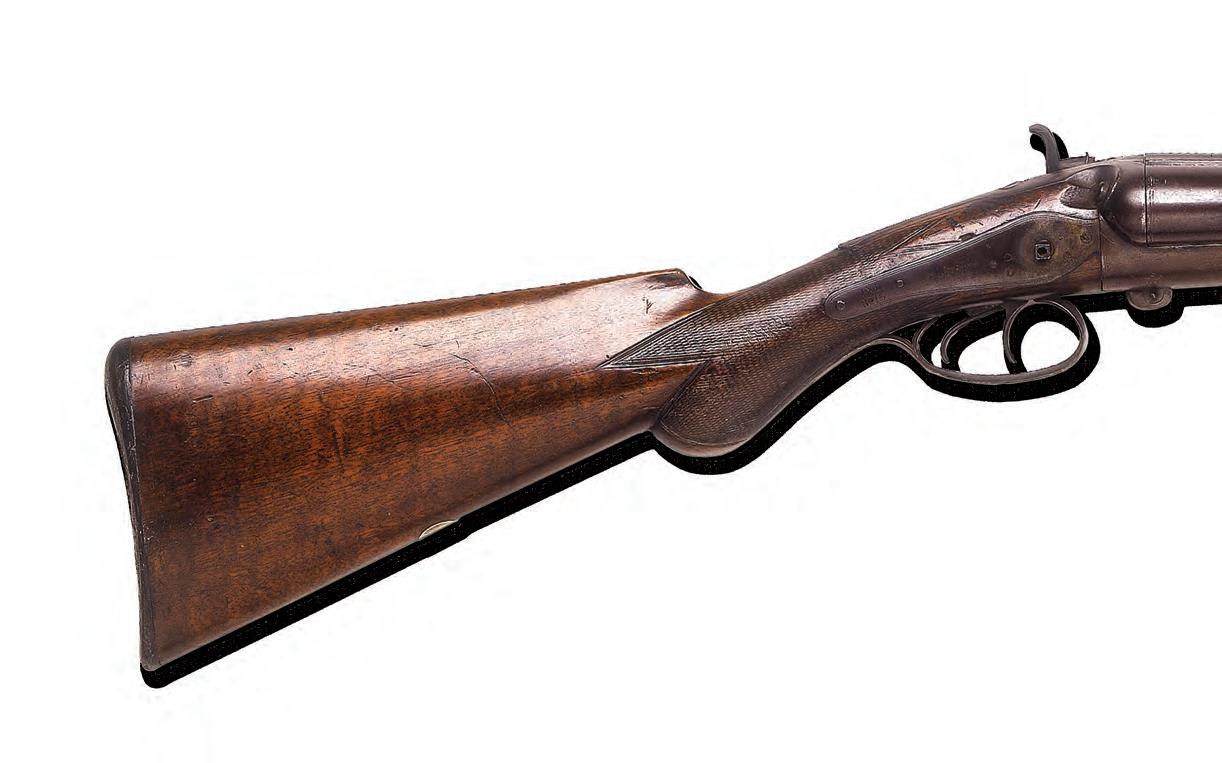
found sawed-off percussion shotguns the ideal tool for inflict ing damage on Yankees. One prepped a muzzle-loading shot gun by pouring gunpowder from a flask down each barrel, stuffing in paper wadding, followed by a load of buckshot, then another wad of paper tightly compressed using the ram rod that rested in twin ferrules beneath the barrels. After one placed a percussion cap on the nipple at the back of each barrel and cocked the hammers, the gun was ready to fire.
In the 1870s modern breech-loading shotguns capable of firing paper-hulled cartridge loads became commercially avail able. While they were a huge improvement over muzzleloaders, few Americans could afford the fancy new break-action models made by such manufacturers as W.W. Greener, L.C. Smith and Parker Bros. Enterprising dealers filled the void by importing affordable Belgian-made breech-loading shotguns for the aver age wage earner. In no time the obsolete muzzleloaders could be purchased for a dollar or two, though only diehards and those unable to afford breechloaders were clamoring for them. The fast-loading break-action models soon had a following among lawmen and express guards (hence the expression “shotgun messengers”), not to mention the outlaws who plagued them.
Charles E. Boles (alias “Black Bart”) was the nation’s most prolific road agent, having robbed more coaches than any
WILD WEST WINTER 202378
WEST
Charles E. Boles (alias “Black Bart”) reportedly brandished this 12-gauge Loomis IXL No. 15 double-barreled shotgun (Serial No. 36822) made by Joseph Bourne & Co. of England.
TOP: AUTRY MUSEUM, LOS ANGELES, 86.22.1; RIGHT: CALAVERAS COUNTY HISTORICAL SOCIETY
WIWP-WINTER 2023-GUNS-OF-THE-WEST.indd 78 9/30/22 10:12 AM
other bandit. Between 1875 and ’83 he held up 29 stages in northern California, always bran dishing a sawed-off double-barreled shotgun —usually a cartridge breechloader, though oc casionally a muzzleloader. Stepping into the road donned in a flour sack mask, he would po litely order the driver, “Throw down the box.”
On two occasions he left at the scene bits of droll verse signed “Black Bart.” That grabbed the at tention of newspapers, which dubbed him the “Poet Highwayman.” In keeping with his gen tlemanly reputation, he reportedly never fired a shot during his many robberies. To avoid sus picion when traveling, Boles carried his breech loaders broken down into their component parts —stock and barrel—and concealed within a bed roll. On those few occasions he used a muzzle loader, he did the same by first removing the flat tenon pin in the forearm that holds the barrel to the frame.
During his last holdup—on Nov. 3, 1883, on Funk Hill, a few miles southeast of Copperopolis —Bart fled with the loot, concealing it and the shotgun, after having been fired on and wounded by a young passenger. In his haste he dropped several personal items, including his handker chief, which tireless Wells Fargo detective Henry N. “Harry” Morse used to track down Boles through a San Francisco laundry. Convicted and sent to San Quentin, Black Bart vanished soon after his 1888 release.
Over the years a string of old-timers claimed to have found the shotgun Black Bart had con cealed after his last robbery. In fact, as part of a plea deal Black Bart had led Morse and two other lawmen to the loot and the shotgun, which he’d hidden in a hollow log on Funk Hill. The firearm they retrieved is likely the “Black Bart shotgun”— a 12-gauge Loomis IXL No. 15 (Serial No. 36822) with a sidehammer and sawed-off barrels—that Wells, Fargo & Co. displayed in the company’s ex hibit at the 1893 World’s Columbian Exposition in Chicago. In 1918, amid World War I, Wells Fargo was absorbed by the government-run American Railway Express Co., which inherited Black Bart’s shotgun. In 1927 the vice president of the com pany presented the weapon to W. Parker Lyon, a wealthy collector who was assembling artifacts
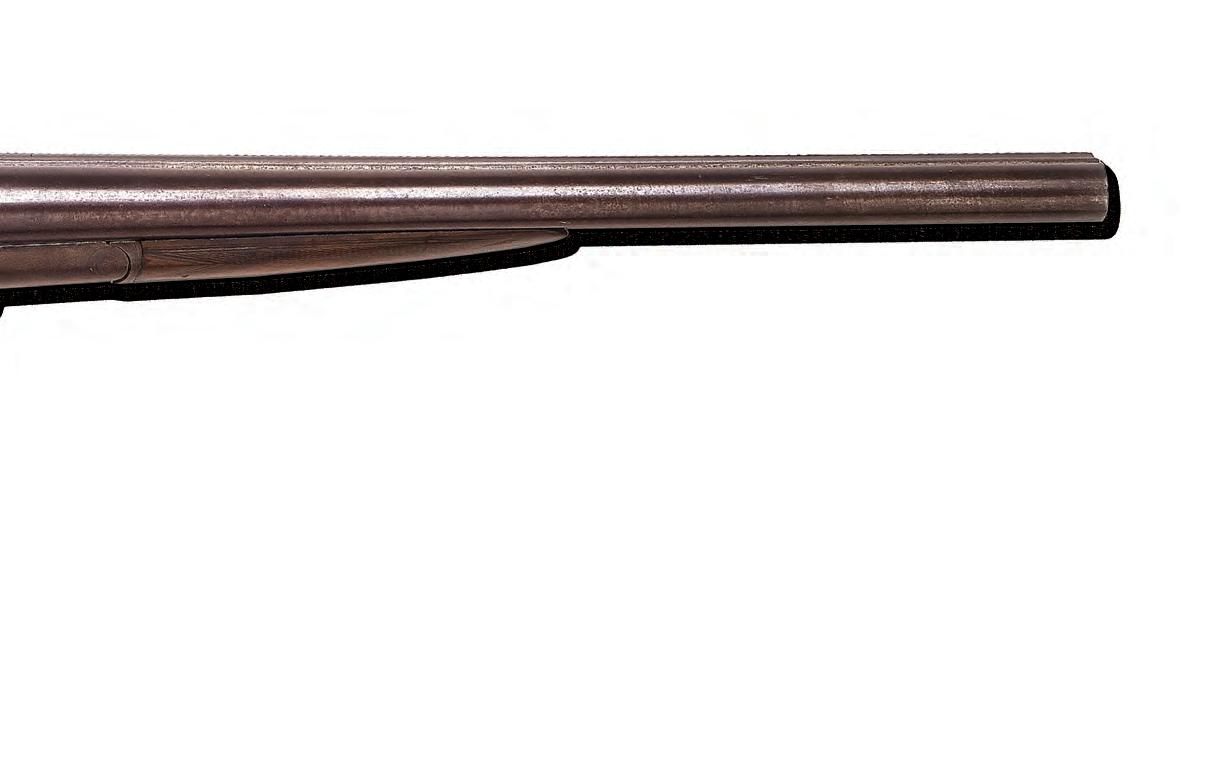
for his sprawling Pony Express Museum in Los Angeles County. In 1955, when the museum finally closed six years after Lyon’s death, Bill Harrah, owner of the namesake hotel and casino in Reno, Nev., bought and relocated the entire museum collection. In 1986 firearms collector Greg Martin of San Francisco purchased the collection from Harrah’s and promptly auctioned off all but three coveted firearms, including Black Bart’s scatter gun. Boles’ shotgun was eventually acquired by the Autry Museum in Los Angeles, where it re mains on display.
Thanks for the assistance of Wild West special contributor John Boessenecker, who is writing a biography of Black Bart.
Boles, looking dapper here, was not deadly but he was the nation’s most prolific road agent, having held up 29 stagecoaches in northern California between 1875 and ‘83. At each robbery he produced a sawedoff double-barreled shotgun. Twice he left bits of droll verse signed “Black Bart.”
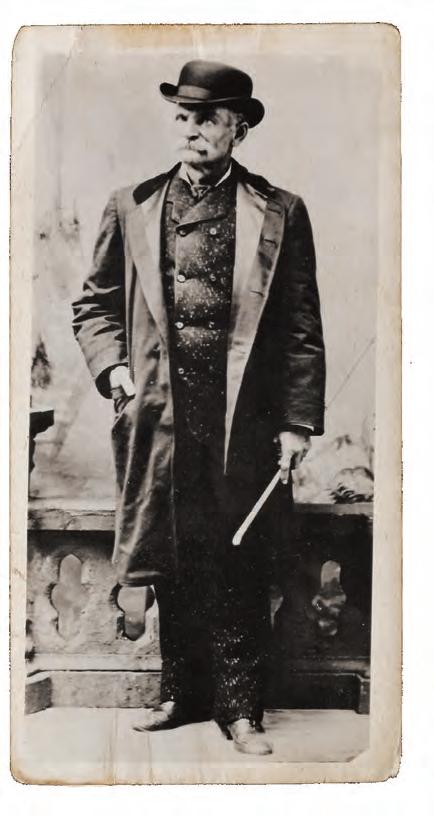
WILD WEST WINTER 2023 79
In keeping with his gentlemanly reputation, he reportedly never fired a shot during his many robberies
TOP: AUTRY MUSEUM, LOS ANGELES, 86.22.1; RIGHT: CALAVERAS COUNTY HISTORICAL SOCIETY
WIWP-WINTER 2023-GUNS-OF-THE-WEST.indd 79 9/30/22 10:12 AM
Hawkinsville, Colorado
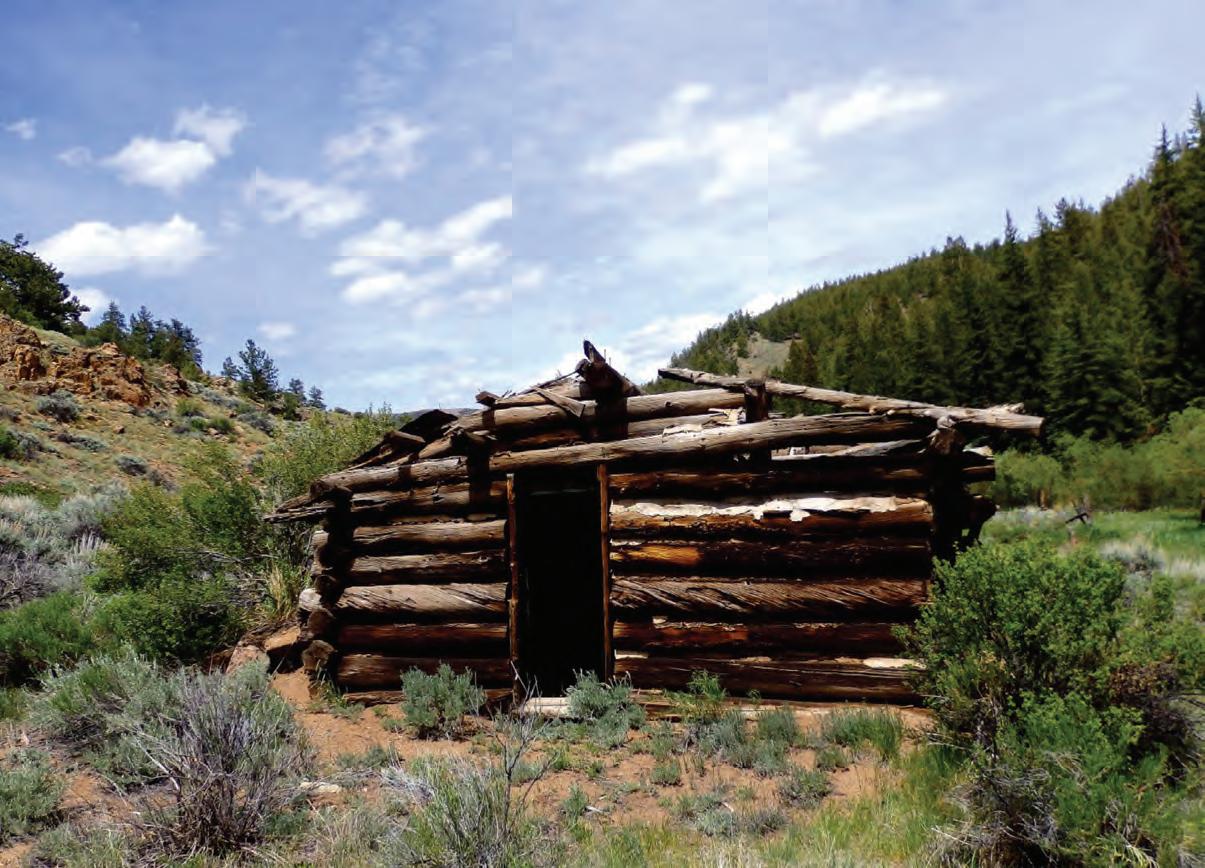 BY JIM WINNERMAN
BY JIM WINNERMAN
The term “ghost town” defines Hawkinsville more aptly than most other abandoned mining settle ments. Almost no mention of it appears in the ar chives of Colorado newspapers, and long ago the old stage road in washed away, effectively sealing off the town from curious sightseers. Unlike other successful mining towns that boasted upward of a thousand residents at their peak, Hawkinsville’s population likely never climbed above 50. As best as can be determined, it never offered traditional town services like as a post office, hotel or saloon. Such were the province of Granite, a onetime county seat and Denver & Rio Grande Railway stop scarcely a mile to the southwest, whose population peaked at around 3,000. Even the first name of Hawkinsville’s founder has been lost to history.
Yet, the tiny community reaped the rewards of a profitable gold mine not once, but twice.
In the spring of 1860 news of a rich strike of placer gold, dubbed the Georgia Bar, drew prospectors to this hilly stretch along the east bank of the Arkansas River midway between Leadville and Buena Vista. Initially undisturbed was the narrow gulch threaded by a clear-running stream in which Hawkinsville would pop up. For the time being the Georgia Bar and the brewing war back East absorbed locals’ attention.
In the wake of the Civil War a prospector by the last name of Hawkins staked the first claim along the brushy gulch some 2 miles above the Georgia Bar, defiantly registering it as the Yankee Blade. By 1867 the gulch had been thoroughly staked, and Hawkinsville had sprung into existence. Until
WILD WEST WINTER 202380 PHOTOS BY JEFF D. EBERLE (4)
THOUGH
ABSENT FROM MOST PERIOD MAPS, THIS SIDE-CANYON SETTLEMENT PROVED A SIGNIFICANT SOURCE OF RICH GOLD ORE
While Hawkinsville never had a post office or even a population of more than 50, it does make for an impressive ghost town, with about 15 intact structures, thanks to its remote location and the arid climate. GHOST TOWNS
WIWP-WINTER 2023-GHOST TOWN.indd 80 9/30/22 10:13 AM
BY JEFF D. EBERLE (4)
flooding put it and neighboring mines out of commission, Hawkins’ own Blade proved the most lucrative claim. In a tally taken two de cades later the mine was already credited with having produced ore worth more than $6 million in today’s dollars.

The district lay dormant until the early 1900s, when Hawkinsville recorded a brief revival as miners reworked the tailings, finding ore missed by the first wave of prospectors. This second boom lasted until about 1930 when the mines played out and were abandoned.
Jeff D. Eberle, the author of three overviews of Colorado ghost towns ( Abandoned Western Colorado , Abandoned Northern Colorado and Abandoned Southern Colorado and the San Luis Valley), has visited Hawkinsville twice. He dis covered it by accident after taking a wrong turn en route to another ghost town. “I realized I was following an old railroad bed when some narrowgauge tracks actually appeared out of a mine shaft,” he recalls, “and I could see where they joined the road I was on.”
Eberle believes Hawkinsville miners extracted rough ore from the tunnels using small carts towed by mule and/or pushed by hand. From there a narrow-gauge steam engine would haul ore carts the half mile north to the Belle of Gran ite stamp mill in Low Pass Gulch. That mill pro cessed ore for several area mines.
After making his discovery, Eberle spent hours poring over old newspapers only to find a hand ful of contemporary accounts of Hawkinsville. It is absent from most period maps. The 15 or so surviving structures in town appear very well constructed and remain intact. Eberle credits their longevity to the relatively arid climate in Hawkinsville. “The townsite itself,” he adds, “sits in a narrow canyon, offering additional protec tion from the elements, and, coupled with its difficult access, has resulted in preservation of the site. The only gold I found was on the glisten ing flanks of the cutthroat trout that swim in the creek, and the only resident left in town was a beaver lazily paddling across a pond without a care in the world.”
Prospectors first struck gold here in the 1860s. A few decades later flooding put the mines out of commission, but there was a revival in the 20th century when others found ore missed by the first wave of seekers. By 1930 the ore had played out, and the town died.


WILD WEST WINTER 2023 81 PHOTOS
WIWP-WINTER 2023-GHOST TOWN.indd 81 10/5/22 7:06 AM
Must See, Must Read
JOHNNY D. BOGGS’ FAVORITE UNSUNG NONFICTION BOOKS AND FILMS

The Raven: A Biography of Sam Houston (1929, by Marquis James)

Chalk up this volume’s relative obscurity to more recent bias against “Big Sam,” warts and all. Certainly not overlooked when published last century, The Raven earned James his first Pulitzer Prize (he earned a second for his 1937 biography of Andrew Jackson). While other authors have writ ten better, more accurate accounts, James’ look at the legend (emphasis on legend ) remains a lively read.
The Only Good Indian: The Hollywood Gospel (1972, by Ralph and Natasha Friar)
Chalk it up to the bias of a film historian, but this book is much more than an indictment against Hollywood as “a co-conspirator in committing cultural genocide.” The Friars point accusing fingers at James Fenimore Cooper, opera com posers, songwriters, playwrights, artists—you name it. Unfortunately, a half century later it remains relevant.
Red Blood & Black Ink: Journalism in the Old West (1998, by David Dary)
The Wister Trace: Classic Novels of the American Frontier (1987, by Loren D. Estleman)
Chalk it up to the bias of a Western novelist, but this literary criticism is an excellent analysis of the genre, from Owen Wister’s The Virginian (1902) to Ron Hansen’s The Assassination of Jesse James by the Coward Robert Ford (1983). Estleman, an award-winning novelist and recip ient of Western Writers of America’s Owen Wister Award for lifetime contributions to Western lit erature, published an updated second edition in 2014.
Movies
No Name on the Bullet (1959, on DVD)
Best 1950s Western. Caveat: Not the greatest film of a decade that saw many classics (from 1950’s Winchester ’73 to 1959’s Rio Bravo ), but the best about the 1950s. Sure, both High Noon (1952) and Silver Lode (1954) took shots at the Hollywood blacklist and McCarthyism, but when hired killer Audie Murphy rides into this town, the populace unravels, worrying over who may be on the gunman’s list—a sharp reflection of Cold War paranoia.
His Last Game (1909, watch free on YouTube)
by Marquis James, Bobbs-Merrill Co., Indianapolis, 1929; reprinted by the University of Texas Press, Austin, 1988, $29.95
Chalk it up to the bias of a former newspaper journalist, but Dary, a journalist and professor turned popular historian, knew how to weave a story. His look at reporters, editors, publish ers and printers shows just how wild and woolly things could get when frontier presses rolled. The fine text is supplemented by many excerpts from the early newspapers themselves.
The Journey of Crazy Horse: A Lakota History (2004, by Joseph M. Marshall III)
No bias here. While Mari Sandoz and Kingsley M. Bray have written solid biographies about the Lakota leader, Marshall’s is easily the most insightful, engaging, provocative and heartfelt.
As Marshall, a Lakota, writes, “Crazy Horse is much too important to the Lakota for us to be indifferent to the misconceptions about him.”
Best baseball-related Western. In this 12½minute silent short a Choctaw ballplayer is sen tenced to death for killing a gambler who tried to slip the star a Mickey to keep him from pitch ing in the big game. After giving his word to return to face a firing squad, the condemned is allowed to pitch the game and wins. Meanwhile, friends seek to have his execution overturned. Spoiler alert: A reprieve arrives too late. Loosely based on the story of William “Walla Tonaka” Goings, a Choctaw ballplayer convicted of mur der. Goings was executed by firing squad at Oklahoma’s Alikchi Court Grounds in 1899, marking the last instance of capital punishment carried out by the Choctaw Nation.
Hell’s Heroes (1930, on DVD)
Best Christmas Western. This first sound adap tation of Peter B. Kyne’s oft-filmed 1913 novella
The Three Godfathers casts Charles Bickford, Raymond Hatton and Fred Kohler as the bank robbers who encounter a dying woman about to give birth far from any town. The story follows the outlaws on a road to redemption as they try to save the infant. Starkly directed by William Wyler (The Westerner, The Big Country), the film was shot in the Mojave Desert and the ghost town of Bodie, Calif.
WILD WEST WINTER 202382
REVIEWS
The Raven: A Biography of Sam Houston
WIWP-WINTER-2023-REVIEWS-BW.indd 82 10/4/22 5:34 PM
You can’t always lie down in bed and sleep. Heartburn, cardiac problems, hip or back aches – and dozens of other ailments and worries. Those are the nights you’d give anything for a comfortable chair to sleep in: one that reclines to exactly the right degree, raises your feet and legs just where you want them, supports your head and shoulders properly, and operates at the touch of a button.







Our Perfect Sleep Chair® does all that and more. More than a chair or recliner, it’s designed to provide total comfort. Choose your preferred heat and massage settings, for hours of soothing relaxation. Reading or watching TV? Our chair’s recline technology allows you to pause the chair in an infinite number of settings. And best of all, it features a powerful lift mechanism that tilts the entire chair forward, making it easy to stand. You’ll love the other benefits, too. It helps with correct spinal alignment and promotes back pressure relief, to prevent back and muscle pain. The overstuffed, oversized biscuit style back and unique seat design will cradle you





in comfort. Generously filled, wide armrests provide enhanced arm support when sitting or reclining. It even has a battery backup in case of a power outage.
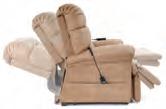








White glove delivery included in shipping charge. Professionals will deliver the chair to the exact spot in your home where you want it, unpack it, inspect it, test it, position it, and even carry the packaging away! You get your choice of Luxurious and Lasting Brisa, Genuine Italian Leather, stain and liquid repellent Duralux with the classic leather look, or plush MicroLux microfiber, all handcrafted in a variety of colors to fit any decor. Call now!







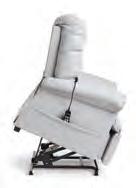





1-888-698-9899 Please mention code 601389 when ordering.
“To
you, it’s the perfect lift chair. To me, it’s the best sleep chair I’ve ever had.”
— J. Fitzgerald,
VA 46622Because each Perfect Sleep Chair is a made-to-order bedding product it cannot be returned, but if it arrives damaged or defective, at our option we will repair it or replace it. © 2022 Journey Health and Lifestyle. 3CHAIRS IN ONE: BUSINESS A+ enjoying life never gets old™mobility | sleep | comfort | safety SLEEP/RECLINE/LIFT Pictured is Luxurious & Lasting Brisa™. Ask about our 5 Comfort Zone chair. REMOTE-CONTROLLED EASILY SHIFTS FROM FLAT TO A STAND-ASSIST POSITION Now available in a variety of colors, fabrics and sizes. MicroLux™ Microfiber breathable & amazingly soft Long Lasting DuraLux™ Chocolate Blue Genuine Italian Leather classic beauty & style Chestnut Light GraySaddleChocolate WIWP-221108-009 FirstStreet Journey Health Perfect Sleep Chair.indd 1 9/30/22 11:16 PM
The Earth Is All That Lasts: Crazy Horse, Sitting Bull and the Last Stand of the Great Sioux Nation by Mark Lee Gardner, Mariner Books (an imprint of HarperCollins), Boston and New York, 2022, $28.99

The Wind (1928, on DVD)
Best women’s Western. Wholesome Virginia girl Letty Mason (Lillian Gish) arrives in Texas, where she reluctantly marries wrangler Lige Hightower (Lars Hanson) and tries to adapt to the frontier. But loneliness, creepy villain Wirt Roddy (Montagu Love) and the unrelenting wind conspire to drive her mad. Based on Dorothy Scarborough’s grim 1925 namesake novel, the film features a studio-mandated “happier” ending.
Ulzana’s Raid (1972, on Blu-ray and DVD)
Best Vietnam Western. Other parables about that war (e.g., 1969’s The Wild Bunch and 1970’s Little Big Man) did well in theaters. But director Robert Aldrich’s realistic film is not only an effec tive allegory but also ranks among the best cav alry-vs.-Indians films. Burt Lancaster gives a fine performance as an aging scout assigned to a patrol led by a green lieutenant (Bruce Davison).
REVIEWS
Sitting Bull and Crazy Horse United
In 1975 Stephen Ambrose published his wellreceived Crazy Horse and Custer: The Parallel Lives of Two American Warriors. Such dual biog raphies featuring big names from the Wild West era seem to be the rage more than ever these days, including four by Bill Markley alone—Wyatt Earp & Bat Masterson: Lawmen of the Legendary West, Billy the Kid & Jesse James: Outlaws of the Legendary West, Wild Bill Hickok & Buffalo Bill Cody: Plainsmen of the Legendary West and Geronimo & Sitting Bull: Leaders of the Legendary West. All of the abovenamed Westerners have been well-covered in solo biographies, so the joint approach offers readers something a little different. Mark Lee Gardner’s latest offering, The Earth Is All That Lasts, fits the bill, as Sitting Bull and Crazy Horse remain the two best-known Lakota Indians (with apologies to Red Cloud) and among the best-known of all American Indians (along with Apaches Geronimo and Cochise and Nez Perce Chief Joseph). They remain integral to the broader story of the Old West, as the two friends were proud, skillful warriors who resisted the white man at the Little Bighorn and in other battles and remained defiant even after surren dering and right up till their similar violent ends. But in relating their life stories together, Gardner, who worked on the book for five years as an inde pendent researcher-writer, masterfully adds a fresh dimension to the lives of two men he views as freedom fighters.
The author first covers the early years of his two subjects, including their emergence as war riors against the Crows, Shoshones and other tribes that considered Lakotas the enemy. The author then focuses on their resistance to the bluecoats (aka “long knives”). The Hunkpapa Sitting Bull and the younger (by about 10 years) Oglala Crazy Horse spent more time apart, so the author shifts back and forth to relate their activities (many of which had no recorded date). Neither put pen to paper when the U.S. govern ment sent commissioners west to treat with the Sioux, Cheyennes and other tribes. Even after fellow tribesmen did sign the treaties, writes Gardner, “[Sitting Bull and Crazy Horse] still considered white men fair game.”
When Sitting Bull decided in November 1876 to flee to Canada instead of surrendering to the Army, he tried to convince Crazy Horse to join him. “But Crazy Horse was ever a warrior, in both spirit and body,” the author suggests. “And he wasn’t so willing to leave the country that was rightfully theirs. Maybe it was simply his time to die, Crazy Horse said.” Yet Crazy Horse was the first of the two to surrender, and four months later, in September 1877, he was killed while resisting imprisonment.
Sitting Bull, must have grieved the death of his friend, but, unfortunately, no matter how much research is done, much of how the two men felt about each other and what they said to one another will never be known. What is known is that both men possessed a strong fighting spirit. Sitting Bull died during the Ghost Dance activi ties of December 1890. “As with Crazy Horse,” Gardner writes, “Sitting Bull’s last act was one of resistance. He would not suffer the ignominy of being imprisoned.”
—Editor
This Texas Ranger Was Wright
When former Texas Ranger captain William L. “Will” Wright died on March 7, 1942, Bob McCracken of the Corpus Christi Caller wrote one of the first and best obituaries, noting the long time lawman’s death ended “a career studded with adventures stranger than fiction.” Waxing more rhapsodic was Brownsville’s Valley Sunday Star-Monitor-Herald, whose obituary stated, “Scores of border badmen tried to get Capt. Will L. Wright in their gunsights, but he died a kind old man’s death at his Floresville home early Saturday.”
McCracken had been working with Wright on a memoir of the Texas Ranger’s long and illus trious career, but the author himself died in 1958
From
WILD WEST WINTER 202384
LALIRE_MCCALLWIWP-WINTER-2023-REVIEWS-BW.indd 84 9/30/22 10:18 AM
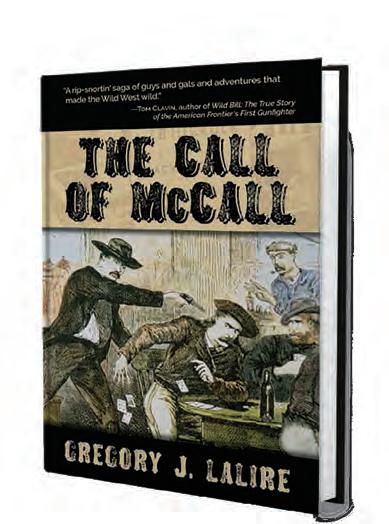



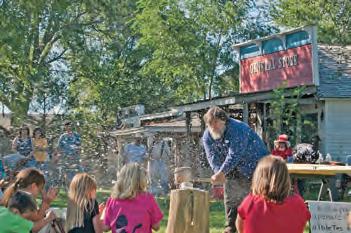



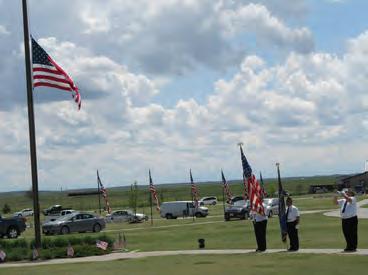
THIS HISTORICAL NOVEL follows Confederate veteran Zach “the bastard” McCall, his African American bear-wrestling pal Jasper Washington and half-brother Jack “Crooked Nose” McCall from the Daniel’s Den (a bordello in Boonesborough, Kentucky) to Springfield, Missouri, to connect with Wild Bill Hickok. The trio watches Wild Bill win a shootout with cardsharp Dave Tutt and then follows the famous lawman-gambler to the Kansas cow towns of Hays City and Abilene. In the end, they all arrive in Deadwood, Dakota Territory, where one of the Wild West’s most famous murders takes place—during a poker game at the No. 10 Saloon. BY GREGORY J. LALIRE PRICE $25.95/447 PAGES HARDCOVER (5.5 X 8.5)/ISBN13:9781432892722 TIFFANYSCHOFELD@CEGAGE.COM FACEBOOK & TWITTER: @FIVESTARCENGAGE From Gregory J. Lalire, the editor of MAGAZINE THE CALL OF McCALL LALIRE_MCCALL half-horiz AD.indd 22 2/10/22 4:56 PM ChartyourCoursetoexperiencethe unexpecteddiscoveriesinandaroundAlliance, Nebraskawherethereishistoryateveryturn. Fromscenicdrives,toourlocalbrewery, remarkableparks,richartandthelegendary Carhenge;youwillbetransportedtoanostalgic placewherequaintshopslineourhistoric downtownbrickpavedstreetsandfolksyou’ve nevermetwillsmileandwave.Ourhospitality andbeautyofourcitywillleaveyouwantingto comebackformore. Planyourgetawaynowbyvisiting www.visitalliance.com Veteran's Cemetery KnightMuseum& SandhillsCenter & SallowsMilitary Museum Dobby's Frontier WIWP-221108-003 Alliance Tourism 1-2Horiz.indd 1 9/30/22 11:13 PM WIWP-WINTER-2023-REVIEWS-BW.indd 85 10/4/22 5:34 PM
Texas Ranger Captain William L. Wright
by Richard B. McCaslin, University of North Texas Press, Denton, 2021, $34.95
before completing it. With the bicentennial of the founding of the original Texas Rangers approaching in 2023, Richard B. McCaslin, pro fessor of Texas history at the University of North Texas, has finally sewn up the overdue saga of Wright, one of the 30 inductees to date in Waco’s Texas Ranger Hall of Fame.
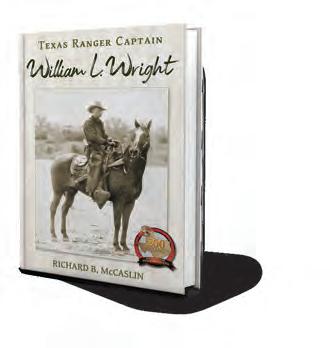
Though not one of the “Four Great Captains” of his generation—those honors going to James A. Brooks, John R. Hughes, William J. McDonald and John H. Rogers—Wright was a worthy disci ple of Rogers’ when he served with the captain in Company E of the Frontier Battalion. The author notes that upholding the law was a Wright fam ily tradition, no fewer than eight of his relatives having served as Rangers before the Civil War and a whopping 35 having worn badges at one time or another by 1935.
Born in Lockhart, Texas, on Feb. 19, 1868, Wright turned stints as a cowpuncher and farmer before becoming a deputy sheriff in 1899 and a Ranger later that year. He soon proved his mettle, quell ing a mob during the Laredo Smallpox Riot, main taining order during the Reese-Townsend Feud and winning a gunfight in Cotulla with local tough James Davenport on Oct. 24, 1900. Wright impressed those around him as much with his pro fessionalism and solid set of ethics as his skills with horse and gun.
for the show—“Women’s Work.” Typical ques tions posed by spectators included: “Does that placard really mean to tell us a woman mounted all these animals?” “Did she kill any of the ani mals?” “What sort of woman is she?”
Perhaps the most common reaction from women who attended the exposition was, “Do tell me who she is and how she did it!” In 1877 Martha’s half sister and lifelong friend, poet and essay ist Mary Dartt, set out to answer that question by writing On the Plains, and Among the Peaks , first published in 1878. Essentially a collection of anecdotes, the book follows the “Colorado Huntress” on her expeditions throughout the terri tory, shooting hundreds of animals and mounting them with an uncanny eye for remembering how they looked in the wild, as few naturalists had done before. In this 2021 reprint Maxwell’s rec ollections, written with Dartt’s help, have been edited and placed in historic context by Julie McCown, an assistant professor of English at Southern Utah University.
On the Plains and Among the Peaks, or, How Mrs. Maxwell Made Her Natural History Collection by Mary Dartt, University Press of Colorado, Louisville, 2021, $27.95

In 1910 the prospect of a higher salary led Wright down the path toward becoming the longestserving sheriff in Wilson County, during which he kept the peace amid the so-called Bandit Wars. Seven years later he rejoined the Rangers, serv ing it mostly as a captain until finally retiring in 1939.
One in a spate of recent biographies of indi viduals behind the collective legend, Texas Ranger Captain William L. Wright takes readers through one of several eras in the Rangers’ evolution while illuminating that period’s outstanding players. Although Wright began his career at the tail end of the 19th century, his deeds should remind Western enthusiasts the new century still had its share of challenges. Between 1899 and 1939 there remained baddies who fought the law—and men like Wright who saw to it the law won.
Jon Guttman
She Killed to Immortalize
When Martha Dartt Maxwell exhibited her taxi dermy tableaux of 47 mammals and 224 birds at the 1876 Centennial International Exposition in Philadelphia, the unprecedented lifelike manner in which they were displayed caused a sensation, though arguably a greater one attended her title
Although Maxwell’s lifelike taxidermy made her one of Colorado’s most famous women by 1876, she and her literary half sister saw to it this biography is no dry zoological travelogue. In the course of riding the high and low country, Maxwell noted the behavior behind the poses and personalities exhibited by her many sub jects. For example, the huntress wrote admir ingly of a mother skunk who put her life on the line to protect her young—just before Maxwell shot them all. To the relief of readers with gen tler natures, she made a pet of a porcupine, which proved a lot less dangerous and somewhat less prickly than its reputation suggested, provided one could earn its trust. Maxwell’s behavioral observations extended to humans she encoun tered, who constituted an interesting menagerie in themselves.
Entertaining as the narrative may be, Dartt noted that Maxwell frequently had to address the oft-asked question a modern reader might be just as likely to ask: “You fearful woman! How can you have the heart to take so many lives?” Maxwell’s standard reply was: “There isn’t a day you don’t tacitly consent to have some creature killed that you may eat it. I never take life for such carnivorous purposes! All must die some time; I only shorten the period of consciousness that it may give their forms a perpetual memory; and, I leave it to you, which is more cruel—to kill to eat or kill to immortalize ?” Food for thought for anyone wending their way through On the Plains and Among the Peaks.
—Jon Guttman
WILD WEST WINTER 202386
WIWP-WINTER-2023-REVIEWS-BW.indd 86 9/30/22 10:19 AM
STATEMENT OF OWNERSHIP, MANAGEMENT AND CIRCULA TION (required by Act of August 12, 1970: Section 3685, Title 39, United States Code). 1. Wild West 2. (ISSN: 1046-4638) 3.



Filing date: 10/1/22. 4. Issue frequency: Quarterly. 5. Number of issues published annually: 4. 6. The annual subscription price is $39.95. 7. Complete mailing address of known office of publica tion: HistoryNet, 901 N Glebe Rd, 5th Floor, Arlington, VA 22203. 8. Complete mailing address of headquarters or general business office of publisher: HistoryNet, 901 N Glebe Rd, 5th Floor, Arlington, VA 22203. 9. Full names and complete mailing addresses of publisher, editor, and managing editor. Publisher, Michael A. Reinstein, HistoryNet, 901 N Glebe Rd, 5th Floor, Arlington, VA 22203, Editor, Gregory J Lalire, HistoryNet, 901 N Glebe Rd, 5th Floor, Arlington, VA 22203 , Editor in Chief, Dana Shoaf , HistoryNet, 901 N Glebe Rd, 5th Floor, Arlington, VA 22203. 10. Owner: HistoryNet; 901 N Glebe Rd, 5th Floor, Ar lington, VA 22203. 11. Known bondholders, mortgages, and other security holders owning or holding 1 percent of more of total amount of bonds, mortgages or other securities: None. 12.
Tax status: Has Not Changed During Preceding 12 Months. 13. Publisher title: Wild West. 14. Issue date for circulation data below: October 2022. 15. The extent and nature of circulation: A. Total number of copies printed (Net press run). Average num ber of copies each issue during preceding 12 months: 51,600. Actual number of copies of single issue published nearest to fil ing date: 49,097. B. Paid circulation. 1. Mailed outside-county paid subscriptions. Average number of copies each issue during the preceding 12 months: 25,556. Actual number of copies of single issue published nearest to filing date: 23,329. 2. Mailed in-county paid subscriptions. Average number of copies each issue during the preceding 12 months: 0. Actual number of cop ies of single issue published nearest to filing date: 0. 3. Sales through dealers and carriers, street vendors and counter sales. Average number of copies each issue during the preceding 12 months: 7,031. Actual number of copies of single issue pub lished nearest to filing date: 7,250. 4. Paid distribution through other classes mailed through the USPS. Average number of copies each issue during the preceding 12 months: 0. Actual number of copies of single issue published nearest to filing date: 0. C. Total paid distribution. Average number of copies each is sue during preceding 12 months: 32,587. Actual number of copies of single issue published nearest to filing date; 30,579. D. Free or nominal rate distribution (by mail and outside mail). 1. Free or nominal Outside-County. Average number of copies each issue during the preceding 12 months: 0. Number of copies of single issue published nearest to filing date: 0. 2. Free or nominal rate in-county copies. Average number of copies each issue during the preceding 12 months: 0. Number of copies of single issue published nearest to filing date: 0. 3. Free or nominal rate copies mailed at other Classes through the USPS. Average num ber of copies each issue during preceding 12 months: 0. Number of copies of single issue published nearest to filing date: 0. 4. Free or nominal rate distribution outside the mail. Average num ber of copies each issue during preceding 12 months: 578. Number of copies of single issue published nearest to filing date: 411. E. Total free or nominal rate distribution. Average number of copies each issue during preceding 12 months: 578. Actual number of copies of single issue published nearest to filing date: 411. F. Total free distribution (sum of 15c and 15e). Average number of copies each issue during preceding 12 months: 33,165. Actual number of copies of single issue published near est to filing date: 30,990. G. Copies not Distributed. Average number of copies each issue during preceding 12 months: 18,435. Actual number of copies of single issue published near est to filing date: 18,107. H. Total (sum of 15f and 15g). Average number of copies each issue during preceding 12 months: 51,600. Actual number of copies of single issue published near est to filing: 49,097. I. Percent paid. Average percent of copies paid for the preceding 12 months: 98.3% Actual percent of copies paid for the preceding 12 months: 98.7% 16. Electronic Copy Circulation: A. Paid Electronic Copies. Average number of copies each issue during preceding 12 months: 0. Actual num ber of copies of single issue published nearest to filing date: 0. B. Total Paid Print Copies (Line 15c) + Paid Electronic Copies (Line
16a). Average number of copies each issue during preceding 12 months: 32,587. Actual number of copies of single issue pub lished nearest to filing date: 30,579. C. Total Print Distribution (Line 15f) + Paid Electronic Copies (Line 16a). Average number of copies each issue during preceding 12 months: 33,165. Actu al number of copies of single issue published nearest to filing date: 30,990. D. Percent Paid (Both Print & Electronic Copies) (16b divided by 16c x 100). Average number of copies each is sue during preceding 12 months: 98.3%. Actual number of copies of single issue published nearest to filing date: 98.7%. I certify that 50% of all distributed copies (electronic and print) are paid above nominal price: Yes. Report circulation on PS Form 3526-X worksheet 17. Publication of statement of ownership will be printed in the Winter 2022 issue of the publication. 18. Signature and title of editor, publisher, business manager, or owner: Kelly Facer, SVP, Revenue Operations. I certify that all information furnished on this form is true and complete. I under stand that anyone who furnishes false or misleading information on this form or who omits material or information requested on the form may be subject to criminal sanction and civil actions. WIWP-221108-002 OK Corral 1-3V.indd 1 THIS WEEK IN HISTORY Join hosts Claire and Alex as they explore—week by week— the people and events that have shaped the world we live in. HISTORYNET.COM AN ORIGINAL VIDEO SERIES Check it Out! 9/16/21 11:20 AM WIWP-WINTER-2023-REVIEWS-BW.indd 87 10/4/22 7:54 AM
Reindeer Farm, Palmer, Alaska
This proud mama’s knockkneed calf is among the latest attractions at the Reindeer Farm in Palmer, some 43 miles northeast of Anchorage. In 1987 Tom and Gene
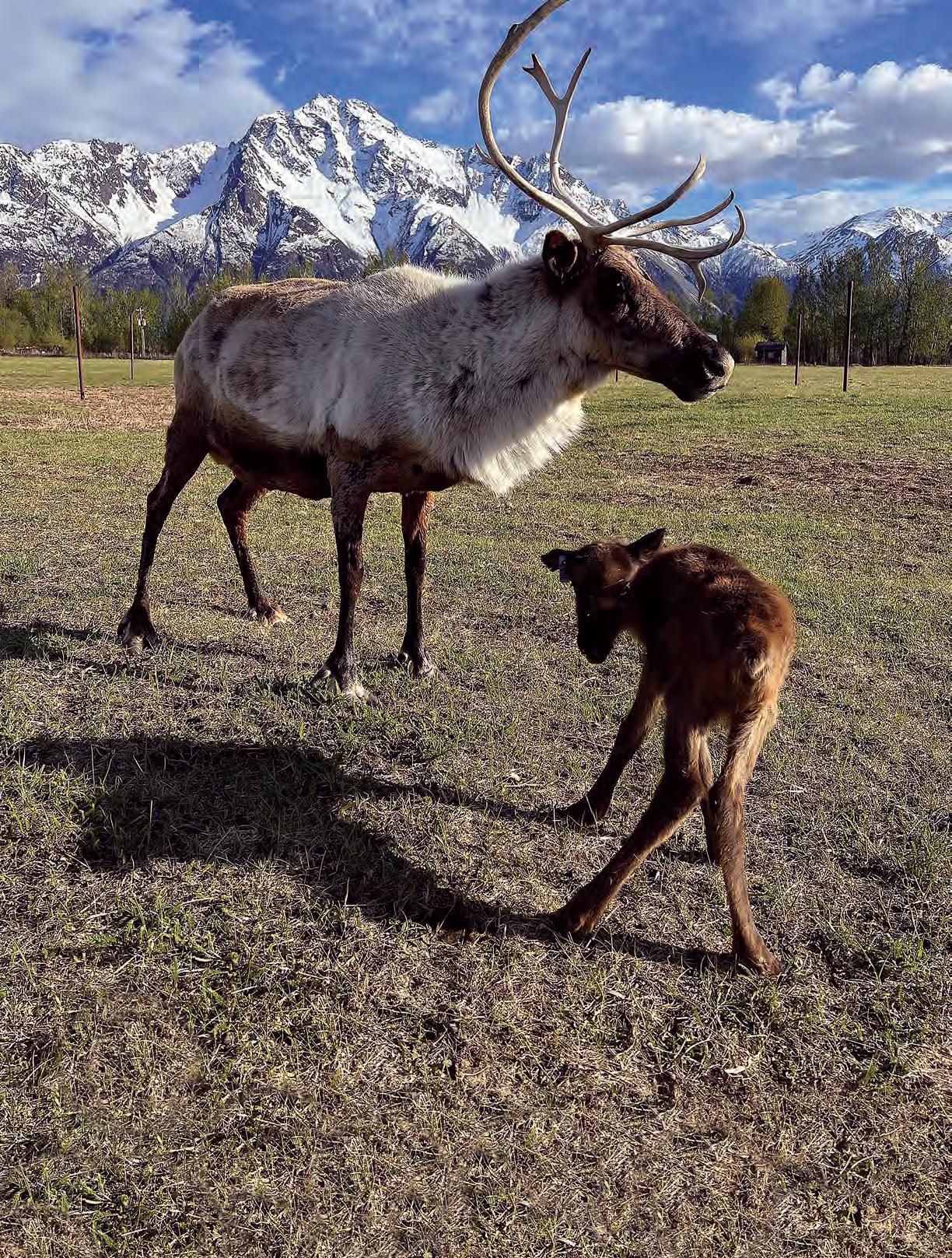
brought a herd of 20 reindeer down from northern
start what has since become
tion
and family now run the farm, which is home on the northern range to 100plus reindeer, elk, bison, moose and even a yak. Reindeer were big busi ness for a time after Congress formed the Alaska Reindeer Service back in 1893 (see related story, P. 40). Its organizers brought Saami herders from Lapland (inset) to manage the herds and train Iñupiat to do the same. But did they ever envision a petting zoo?

Williams
Canada to
a thriving family-run agritourism destina
[reindeerfarm.com]. Daughter Denise Williams Hardy
GO WEST WILD WEST WINTER 202388 LAUREN WAITE, WILLIAMS REINDEER FARM,
PALMER,
ALASKA; INSET: CHRONICLE/ALAMY
STOCK
PHOTO
WIWP-WINTER-2023-GO WEST.indd 88 9/30/22 10:20 AM
Stauer Collector’s Series
Blade Stunner
It’s not often you happen upon a blade smith who has gem cutting skills. In fact, you stand a better chance finding a needle in a haystack. But finding needles in haystacks is what we do best, so when we saw this master craftsman’s handiwork, we made certain to procure some of these Southwestern masterpieces to complete our collection.
The stainless steel blade, bolster and pommel are exquisitely etched and would have looked great with a less ambitious handle. But the results of overachieving are stunning here. The turquoise-blue colored handle is ablaze with assorted stones like jasper, marble, sunstone, and coral that have been hand cut and inlaid in a Southwestern motif that conjures images of intricately beaded belts and moccasins.


Whether you collect blades, interesting stones, or are a lover of the great American Southwest, the Sedona Knife is more than cut out to do the job.
But we don’t stop there. While supplies last, we’ll include a pair of $99, 8x21 power compact binoculars and a genuine leather sheath FREE when you purchase the Sedona Knife

Your satisfaction is 100% guaranteed. Feel the knife in your hands, wear it on your hip, inspect

What customers are saying about Stauer knives...





êêêêê
“Very hefty, well-built knife and
Extremely good-looking and utilitarian.”
— R., Lacey, Washington
the impeccable craftsmanship of the Sedona Knife. If you don’t feel like we cut you a fair deal, send it back within 30 days for a complete refund of the item price.
Limited Reserves. You could pay nearly $1,900 for a steel, fixed blade knife with a gemstone handle, but why would you when you can enjoy the superb craftsmanship of the Sedona Knife for only $99. Don’t let this beauty slip through your fingers. Call today!
•5" etched stainless steel blade; 9 1/2" overall length •Turquoise-colored handle with accent stones including coral, marble, sandstone, tiger’s eye, jasper and sunstone •Leather pouch included Stauer… Afford the Extraordinary .®
 Not shown actual size.
Not shown actual size.
Beautifully made, magni cent to look at, this knife is a work of art at only $99
sheath.
EXCLUSIVE FREE Stauer® 8x21 Compact Binoculars -a $99 valuewith purchase of the Sedona Knife “...Native American knives have since taken on a more artistic meaning in the modern era...these decorative style knives have become a must-have for any Southwestern home.” –– PRWeb, 2017 1-800-333-2045 Your Insider Offer Code: SEK216-01 You must use the insider offer code to get our special price. Sedona Knife $179* Offer Code Price Only $99 + S&P Save $80 Stauer ® Rating of A+ 14101 Southcross Drive W., Ste 155, Dept. SEK216-01 Burnsville, Minnesota 55337 www.stauer.com *Discount is only for customers who use the offer code versus the listed original Stauer.com price. California residents please call 1-800-333-2045 regarding Proposition 65 regulations before purchasing this product. FREE $99 Binoculars With Knife Purchase (see details) BONUS! Call today and you’ll also receive this heavy duty sheath! WIWP-221108-015 Stauer Sedona Knife.indd 1 9/30/22 11:26 PM
History from the Heart
WARS OF THE
Travel
-
A TOUR YOU WON’T FORGET! Join us on our Exclusive New Apache Wars of the Southwest tour, an unforgettable journey through the scenic Southwest that follows in the footsteps of Geronimo and cast of remarkable historical characters. In June 2023, join us for our Crazy Horse & Custer Tour. The Great Plains and Rocky


as you travel through Wyoming, South Dakota and Montana to learn about these
provide the
Our American History, Civil War and WWII
are unrivaled in their
with us October 15
21, 2023!
Mountains
scenic backdrop
legendary leaders.
tours
historical accuracy! EXPLORE NOW AT STEPHENAMBROSETOURS.COM 1.888.903.3329 APACHE
SOUTHWEST WIWP-221108-007 Stephen Ambrose.indd 1 9/30/22 11:38 PM































































 Aaron Robert Woodard
Aaron Robert Woodard



 BY JULIA BRICKLIN
BY JULIA BRICKLIN





















































































 BY JOHN H. MONNETT
BY JOHN H. MONNETT




























 Kid Curry in Custody
The man born Harvey Logan in 1867 posed slouched in a chair for this photo on Oct. 1, 1897, while being held in the Deadwood, S.D., jail. He’d been arrested for having helped rob the Butte County Bank in Belle Fourche, S.D., on June 28, 1897.
Kid Curry in Custody
The man born Harvey Logan in 1867 posed slouched in a chair for this photo on Oct. 1, 1897, while being held in the Deadwood, S.D., jail. He’d been arrested for having helped rob the Butte County Bank in Belle Fourche, S.D., on June 28, 1897.














 WILD WEST WINTER
WILD WEST WINTER











 Half blood Johnnie Bruguier served Colonel Nelson Miles and other officers on the northern Plains for nearly two decades.
Half blood Johnnie Bruguier served Colonel Nelson Miles and other officers on the northern Plains for nearly two decades.

























 Tombstone Tells the Tale
Paulson’s weathered grave marker in the Mayville Cemetery lists both the shocking cause and hour of his death. The funeral gathering for the well-liked officer was said to have been the largest the North Dakota town had ever seen.
Tombstone Tells the Tale
Paulson’s weathered grave marker in the Mayville Cemetery lists both the shocking cause and hour of his death. The funeral gathering for the well-liked officer was said to have been the largest the North Dakota town had ever seen.





















 BY JIM WINNERMAN
BY JIM WINNERMAN



























































 Not shown actual size.
Not shown actual size.

